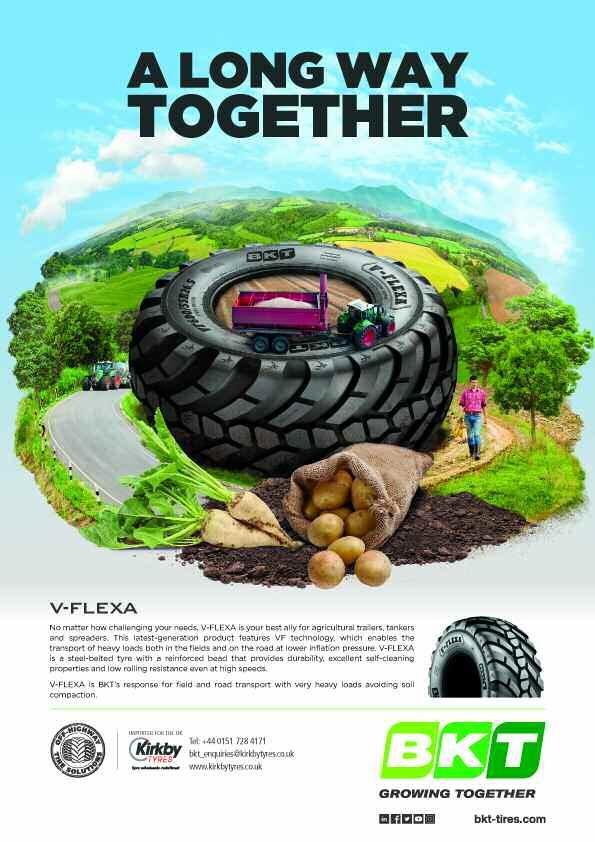

Technical
Recommended Lists - RL reset With major modifications to disease ratings, it’s very much a year of change.


Fit for the



Recommended Lists - RL reset With major modifications to disease ratings, it’s very much a year of change.


Fit for the
I may be about the only farmer in England who holds this view,but I think Defra’s Path to Sustainable Farming,its roadmap through transition,is a really useful,indeed impressive document.
Launched at the end of Dec, this puts a fair bit of detail into how Defra plans to manage the move from direct payments to public money for public goods. Most of the focus is on the tests, trials and pilots for the Environmental Land Management (ELM) scheme prior to its full implementation in 2024. The policy paper also looks towards 2028 and to productivity support, referred to as Improving Farm Prosperity.
It’s drawn a lot of criticism, not least from those who say it lacks the details against which you can make a credible business plan. There is also the feeling the reduction of direct payments should be delayed until their replacement is fully in place.
It’s true –– for many of us, this will be the first time in our farming career that a sizeable portion of our income we’ve relied on to be fixed will start to reduce to zero. We don’t know
how the void will be filled, and we can’t yet build an ELM scheme plan because this policy paper leaves too many questions unanswered, and figures unknown. But I’m not sure we should have expected these details to be presented to us, nor do I think we’d be happy if they were. What is clear from the paper is that there’s a lot of work that’s gone into it. It’s had to consider the views not only of every English farmer, from a shepherd in Cumbria to a Fenland wheat grower, but MPs, NGOs, auditors and of course the wider public. Weaving together a document that fulfils the hopes of that massive span of stakeholders, and moreover inspires ever y one of those farmers, is an almost impossible task. That’s why the result in my view is an impressive achievement and a credit to every civil servant who worked on it.
What’s different is the word ‘co-design’ that appears no less than 20 times within the document. This policy paper is not a set of instructions but a brief. How we take it forward is up to us –– wait for the detail and we’ll forego the opportunity to shape its outcome. So I think this plan is more likely to excite CPM readers than disappoint.
Of par ticular interest, for example, may be the pledge for “increased investment in agricultural R&D … to drive innovation which will see farmer-led R&D projects trial and demonstrate viability of

new and existing technologies”. CPM asked Defra for some clarification here, and received this response:
“The scheme will include mechanisms to bring together innovators, farmers, growers, foresters and researchers to work together, including through consortium-building workshops and networking events. Farmers and growers can get involved in projects by participating in project teams, co-designing research, outputs and plans for sharing results, and by taking part in field trials to test new techniques and technologies on-farm.
“It will fund far mer-led R&D projects to trial and demonstrate the on-farm viability of new and existing technologies to address immediate on-far m productivity challenges. It will pay to connect groups of researchers, far mers, growers and agri-food businesses to work in partnership on projects that are responsive to industry-specific challenges.”
Summer 2021 is when funding calls will be initiated, with pre-launch workshops and events planned to bring together interested farmers with scientists and researchers to for m project teams.
So what will you research? What project will you co-design? Perhaps this is an opportunity to explore how you can be par t of the solution to climate change. Just over a month ago, CPM chaired a round table meeting that brought together the arable sector’s first Climate Change
Champions with industry representatives. Hosted by the NFU, farming minister Victoria Prentis attended. There’s a full report on proceedings on p28, while ideas to take it forward may include growing miscanthus (p22) or farming carbon for a Sustainable Gain (p32).
But this is just the start. CPM’s Climate Change Champions have already made a palpable difference for UK Farming’s prospects in reaching Net Zero, and we’re now looking for farmers to step forward for 2021, to initiate and drive forward further positive change. The right individuals to do this have their eyes set on this very page, so please take the time to explore how to get involved at www.cpm-magazine.co.uk/ climatechangechampions.
It will be an uncertain transition, and Defra’s roadmap won’t really help clear up the doubts. But it is a genuine invitation to shape the future, and in the words of NFU president Minette Batters “this is our time”. So have a great Christmas, because the New Year looks as though it may be one filled with bright prospects.
Tom Allen-Stevens has a 170ha carbon store, renewable food source and wildlife haven in Oxon. tom@cpm-magazine.co.uk @tomallenstevens

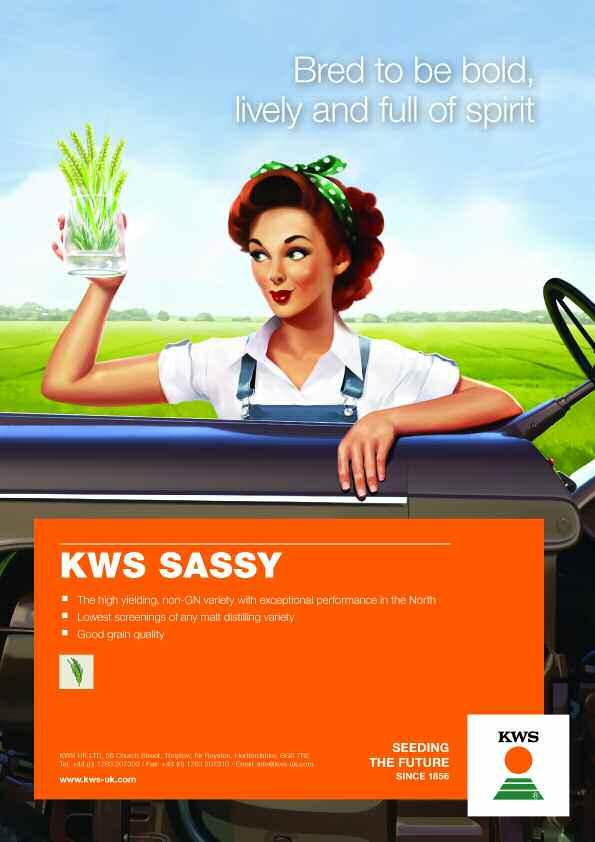

The reports that the 2020 UK wheat harvest of 10M tonnes was the lowest figure since 1981 caused me to rifle through the loft in the farm office where we still keep some of dads old farming mags.
Among the titles, which included the rather pompously named Big Farm Weekly, I found some 1981 editions. Amidst the Abertay Sack adverts there were
articles that gave a glimpse into arable farming a generation ago. Farmers were growing wheat varieties called Norman, Longbow, Galahad and Avalon –– no doubt the rest of the Knights had failed to get on the NIAB list.
Wheat yields were averaging around the 7.5t/ha mark (or as it was then described ‘the 60 cwt to the acre’) which worryingly is more than UK farmers averaged in 2020. So the size of the national wheat crop in 1980 wasn’t so much inhibited by yield but rather by area.
It was in the 1980s that the wheat area increased from a million ha in 1980 to twice that in 1990 while barley did the reverse halving from 3 million ha to 1.5. In 1981 the wheat price was around the £100/t mark largely thanks to EU intervention buying. Judging
by the adverts for the new four door Range Rovers and Axial-Flow combines with their ‘revolutionary new threshing mechanism’, arable farmers were doing OK. Farm workers were taking home around £50/week but that didn’t include overtime.
In terms of the weather, the 1981 harvest had started very wet, no doubt inspiring farmers to install new grain driers, but by the time August was out, most the harvest was in. The sting in the 1981 weather came in the tail with December temperatures averaging below freezing. There was even a brass-monkey ball freezing -20°C in the middle of the month, complete with several inches of snow.
In other 1981 news Prince Charles married Diana, Prime Minister Thatcher was crashing down the opinion polls, unemployment was at an eye-watering 9% as was inflation and Bucks Fizz won the European Song Contest with their skirt-ripping routine.
Returning to the issue of the historically small size of the combine harvest, if you take the meagre barley and oilseed rape harvest of 2020 into consideration to calculate a total figure you will probably have to go back to the infamous drought year of 1976 to find a deeper low in terms of UK production. All sobering stuff.
In times past, meagre harvests would have sparked fear in the populace as the prospect of a winter famine stalking the land would have raised its ugly head. But today, such news of domestic paucity gets very little attention apart from when bakers announce bread price rises as they fiendishly miscalculate that somehow a 20% rise in the wheat price justifies a 20% rise in the bread price, conveniently overlooking the fact wheat only makes up 10% of a price of a loaf. But even then, a few pence increase on the price isn’t exactly
going to incite bread riots across the land. The only panic buying you see nowadays is for loo rolls and crates of cut-price Special Brew.

The only hope is the record amount of grain imports we will need to fill the gap created by the poor 2020 harvest will focus a few minds in Westminster especially as most of that imported grain will have been grown with pesticides long since banned in the UK. But maybe there’s more chance of pink snow on Christmas Day.
I note the bookies are cutting the odds on a white Christmas.Sure enough the haws and hips on the hedge outside my house are a sea of red berries.Some old wives take that as a harbinger of a cold winter.I’m not a big fan of autumn hedge cutting as I see it as a rather mean-spirited destruction of a larder that sees some bird species through the winter months.So hedges round these parts are looking as unkempt as the farmer whose trips to the barber this year have been as often as his trips to the pub for a Scotch egg.

Guy Smith grows 500ha of combinable crops on the north east Essex coast, namely St. Osyth Marsh –– officially the driest spot in the British Isles. Despite spurious claims from others that their farms are actually drier, he points out that his farm is in the Guinness Book of Records, whereas others aren’t. End of.
@essexpeasant

With 21 new varieties and major modifications to disease resistance ratings, it’s very much a year of change for the AHDB Recommended Lists.
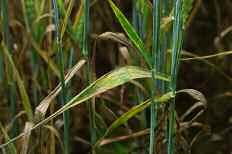
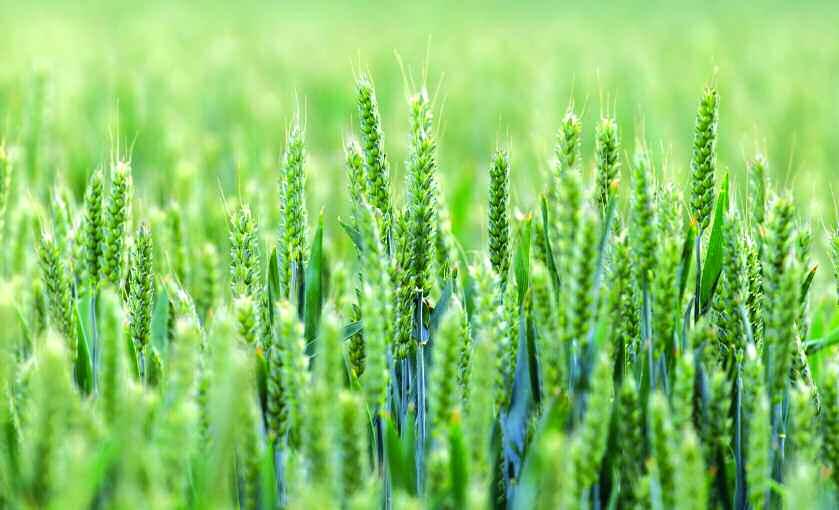
CPM takes an in-depth look at who’s come and who’s gone,as well as what the new ratings mean.
By Charlotte CunninghamIt’s a slightly more compact offering on the 2021/2022 Recommend Lists, with 25 varieties removed and 21 new entrants filling the space.
That said, those 21 varieties have certainly fought for their place, after the 2019/20 season being an incredibly difficult one for the trials team. “The autumn of 2019 was incredibly wet, which lasted well into the winter and led to the loss of a lot of trials,” explains Paul Gosling, who manages the RL at AHDB. “In total we lost 19 wheat, 14 OSR, eight winter barley and six winter oat trials ––either simply because they weren’t drilled, as we were unable to get onto the ground, or because we had to abandon them as they were in such poor condition.”
The spring of 2020 brought further issues due to the COVID movement restrictions meaning four spring barley trials and two spring oat plots were unable to be drilled. “COVID also impacted trial inspections, with AHDB having to turn to drone footage, in some cases, to glean the necessary information,” adds Paul.
So it’s been a year of adapting and working in new ways, but perhaps the most interesting addition this year’s RL is the change to disease-resistance ratings –– including brand new disease ratings for winter rye (brown rust) and winter triticale (yellow rust) on the Descriptive Lists.
So what’s the reason behind this? Offering a rich mixture of broad-appeal and niche varieties, the new RL acts as a foundation for integrated pest management and brings opportunities for a wide range of markets, says Paul. “The wheat brown and yellow rust ratings are now weighted, so the most recent years’ results have the largest influence on the rating. This approach makes the rating more sensitive to changes in rust populations, while still building on a valuable three-year data set.
“For wheat yellow rust and spring oat mildew, we’ve also changed the way we calculate disease ratings, relative to our susceptible and resistant variety fixed points. This ‘reset’ means, compared with the previous edition, the same amount of disease will result in a lower rating score. For rust, some varieties have dropped by as much as three rating points. We stress this
is largely due to the way we calculate the ratings, rather than an indication of a major shift in rust races in 2020.”
Turning the focus to the varieties, what’s new and what’s been dropped?
After an impressive 13 new varieties last year, it’s a much more sombre affair for OSR this year with five hybrid options added to the RL, and the majority recommended for the East/West.
New for this region is LG Antigua from Limagrain, Respect from LSPB and DK Expectation from Bayer. Also in the general-purpose category is LG Aviron, from Limagrain, however this has been awarded UK recommendation and has performed notably well in the North. “The new varieties continue to push disease resistances higher, with robust resistance ratings for both stem canker and LLS,” explains Paul.
Aviron tops the list with its stable mate,
The 2021/22 RL sees significant changes to disease ratings
Technical Recommended ListsIt’s a great example of our work to future proof varieties.
“ ”
Recommended for the whole of the UK,KWS Cranium ticks all the boxes for features of high or very high importance in modern wheat production.

Ambassador, which has held onto its high yields for the second season in a row. “Trait loading of our varieties means that LG Aviron offers the N-Flex trait unique to Limagrain’s OSR portfolio, as well as resistance to pod-shatter, TuYV and RLM 7,” says Will Charlton, Limagrain’s OSR product manager.
“N-Flex is a relatively new trait launched in our hybrids last year offering a step forward in the way that OSR varieties minimise yield losses in sub-optimal N conditions.”
While it’s technically listed as a new variety on this year’s RL, Blackpearl from LSPB, doesn’t yet have any available data as it’s not yet completed National List testing, says Paul. “LSPB are waiting for some data from Blackpearl in order for it to achieve UK National Listing status. So while Blackpearl is recommended, we won’t be sharing any data until that data has been confirmed because after 1 Jan, the variety will have to be on the UK National List to be marketed in the UK.”
The fifth new entrant is a specialist variety –– DK Imprint CL from Bayer. “This new addition is a hybrid variety with a specific recommendation for its tolerance to specific imidazolinone herbicides,” says Paul. “It has high resistance to lodging –– albeit based on limited data –– as well as resistance to pod-shatter and good tolerance to stem canker.”
More than a third of the new varieties on the RL now have TuYV resistance and for the first time this year, the winter OSR list includes pod-shatter resistance data. “We’ve been working with the John Innes Centre over the past three years to try to develop a protocol for testing varieties for pod shatter resistance,” explains Paul. “That has had its problems and we haven’t managed to develop a test that we can get to reliably work yet.
“But because so many varieties have
High GO in the North/East/West.Early flowering, early maturing and resistant to pod-shatter.
Specific recommendation for its tolerance to imidazolinone herbicides.High resistance to lodging and pod-shatter.
High GO in East/West.Resistant to lodging with good stem stiffness at maturity.
Early maturing with resistance to pod-shatter,LLS, stem canker and TuYV.High GO in East/West.
High GO in East/West,resistance to lodging with good stem stiffness at maturity.
Short,stiff-strawed and performs well in East/West. Susceptible to mildew
Short,stiff-strawed and high-yielding with uks classification.
High resistance to brown rust and septoria as well as OWBM.
High-yielding with uks classification. Relatively late maturing and high treated potential in the East.
Recommended for the East. “Medium”for distilling and uks classified.
High spec weight and rated as “medium”for distilling. Stiff-strawed and high treated yields in the East.
High treated yields in the North.Stiff strawed. Rated as “good”for distilling.
Hard-milling, high-yielding and UK recommended. Has high Hagbergs,but tends to give a low specific weight.
High-yielding with a specific recommendation for resistance to BYDV Relatively late maturing and a high treated yield in West and North regions.
High spec weight and good resistance to lodging and rhynchosporium.Very high yielding in the East.
Short-strawed with good lodging resistance.
High-yielding particularly in East/heavier soils.
UK recommended but performs exceptionally well in East/on heavier soils. Susceptible to rhynchosporium and net blotch.
High-yielding and resistant to BaYMV strain 1 and BaMMV Relatively tall but responds well to PGRs.
UK recommended with a high spec weight. Performs well on heavier soils and resistant to BaYMV strain 1 and BaMMV.
High-yielding malting variety with potential for brewing. Stiff-strawed with high resistance to brackling and mildew.
High yields in East/West.Good resistance to brackling and mildew Stiff-strawed.
been marketing pod-shatter resistance, the oilseed committee felt we had to say something about it and so we’re accepting breeders claims while we continue to test this.”
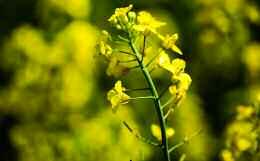
Outgoing varieties include Windozz, Architect, Elgar, Butterfly, Elevation, Nikita, Anastasia, Kielder, and Broadway.
Things look more dynamic on the wheat front with eight new winter varieties added this year and nabim Group 3 growers set to benefit the most.
New to the Group 3 category is LG Prince; LG Illuminate; LG Quasar and LG Astronomer –– all from the Limagrain stable –– as well as Merit from Elsoms.
Though Limagrain’s offerings fall into the biscuit category, they do have multiple end-use markets says the firm’s cereals and pulses product manager, Tom Barker “They shouldn’t just be considered solely as biscuit
Since the incursion of new yellow and brown rust populations in the early 2010’s, rust populations have been dynamic in space and time and RL rust ratings –– based on three years’ worth of data –– have sometimes struggled to cope.
In 2016, there was a large shift in yellow rust populations and so ratings were based on just one year’s data on the 2017/18 RL.
Reports of unexpected levels of rusts on some varieties in 2019 led to questions about new rust races emerging and the veracity of the RL ratings.As a result,yellow and brown rust RL data was subject to additional checks, which showed that varietal resistance was generally in-line with recent years.
Some varieties did have their rust ratings reduced by one point,with KWS’ Firefly falling by two points on the brown rust scale.
A special notice was added to the RL tables
wheats, as they all have the additional end market of potential for distilling and two of them (Quasar and Illuminate) also have uks export opportunities on top, for a full marketing outlet opportunity.”
As well as this, the addition of two new hard Group 4s are set to provide extra options for growers. KWS Cranium sits joint-top of the leader board of hard feed types in terms of yield at 104%, while RGT Wolverine brings a specific recommendation for resistance to BYDV to the RL for the first time.
According to KWS, Cranium sets some important new standards in the Group 4 hard wheat sector. “Recommended for the whole of the UK, KWS Cranium ticks all the boxes for features of high or very high importance in modern wheat production,” says the firm’s Will Compson.
“With the best combination of yield, yellow rust resistance and OWBM resistance on the 2021/22 RL, it’s a great example of our Sowing for Peak Performance work to future-proof varieties as much as we can.”
In the soft Group 4 market, Swallow, from Senova, is causing excitement, particularly for the Scotch Whisky Research Institute, after achieving the highest average alcohol yields in 2020 –– well clear of its competitors. “The consistency of performance for alcohol yield across different harvest years and trial sites is a very positive feature of a clearly “good” distilling variety with the potential to have a significant impact on grain distilling,” it says.
Swallow also has resistance to OWBM, which will no doubt attract growers, though
Paul warns that limited data suggests it’s very susceptible to eyespot ([3]), which is worth keeping in mind if you’re considering the variety.
Leaving the list this year are KWS Lilli; KWS Bassett; Zulu; Bennington; LG Motown; Leeds; Viscount; Revelation; KWS Crispin and Dunston.
Looking to spring wheat, WPB Escape, bred by LSPB, replaces outgoing KWS Alderon. “Escape has given high treated yields from both spring and late-autumn sowings (based on limited data) and has high resistance to both yellow rust and mildew,” says Paul.
While there are no new options for winter malting barley growers, the feed market has had quite a shake up with the addition of five new winter feed varieties now on the list, in place of departing varieties, SY Venture, KWS Glacier and KWS Astaire.
In the two-row category, KWS Tardis (from KWS), Bolton (from Elsoms) and Bordeaux (from Senova) all have joint UK yields of 106, beating closest competitors KWS Hawking and KWS Gimlet by 3%.
“KWS Tardis’ yield is just 1% point off the highest yielding six-row hybrid,” explains Will. “The variety is particularly strong in the East of the country and performs well on light soils, although it’s best on heavy ones where yields are at 110% of controls.”
Two new six-row hybrid varieties, both from Syngenta have also made recommendation. “Both SY Kingston and SY Thunderbolt offer better disease resistance
last to explain this,but doubts persisted.
So,since last year,AHDB has consulted with pathologists,breeders,agronomists,and statisticians to find a better way of calculating rust ratings,explains Paul.“The trial data is good –– varieties with high levels of rust in commercial situations were generally showing high levels of rust in RL trials. However,this wasn’t being reflected in the ratings and the system was arguably poor at dealing with constantly changing populations.”
As a result,a new system has been developed and agreed by all parties and applies to yellow and brown rust ratings.
So how does it work? In the new way of working,three years’ worth of data will continue to be used to calculate ratings,however,data from the current year will be given a weighting of three in the calculations, the previous year, two, and the year prior to that, one.
In yellow rust,the bottom “fixed”point has been adjusted in order to lower ratings for the most susceptible varieties so that disease levels reflect what farmers and agronomist expect to see at those lower levels.
A Yellow Rust Watch List system has also been developed, using RL trial data to highlight varieties that seem to have higher levels of disease than expected in some trials.
“While the watch list doesn’t form part of this year’s RL it will be available online after Christmas,”explains Paul.“This list will be useful to guide monitoring and fungicide programmes, however, it’s important to stress again that the resistance itself has not changed significantly this year.What has changed is the calculations, which we hope will better reflect what’s actually seen in the field.”
Group 3 LG Illuminate also has uks export opportunities on top,for a full marketing opportunity.
and untreated yields, combined with good quality characteristics,” explains Paul.
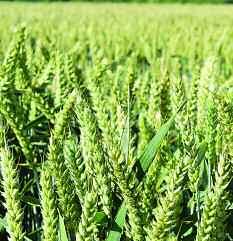

For those looking for spring cropping options, Skyway –– bred by Agrii –– is a new high-yielding malting option that’s currently on test for brewing. If successful, this could potentially offer huge yield increases over the current market leader, notes Paul.
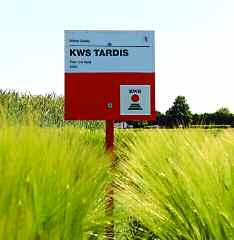
Also joining the spring barley line up is Cadiz, a feed variety from Senova, with specific recommendation for the East/West region and good all-round agronomics, says Senova’s Jeremy Taylor “With a 7 for lodging and an 8 for brackling resistance, Cadiz has similar maturity to other leading spring varieties.”
Leaving the spring barley list is Concerto, after more than 10 years of recommendation.
There are no changes to either the winter or spring oat RL –– with nothing new and nothing removed –– however, where there is a difference is within spring oat mildew
ratings. “Spring and winter oat mildew ratings were not aligned –– higher levels of disease were found in spring varieties than in winter varieties with similar resistance ratings,” explains Paul. “As a result, and to bring this back into line, the bottom “fixed” point used to calculate mildew ratings in spring oats has been moved.
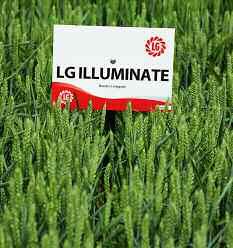
“The effect of this is lower ratings in the less resistant varieties, while more resistant varieties are not affected.”
Looking at the figures, some of the worst hit varieties include Madison, which moves from a score of 5 to 3, while Elison stays unaffected with a score of 8. However, Paul says it’s crucial to point out that this doesn’t mean that there’s been a significant change in mildew races this year –– “it’s simply a change in the way we calculate ratings to bring them more in line with winter oats.” ■
Swallow is causing excitement,particularly for the Scotch Whisky Research Institute,after achieving the highest average alcohol yields in 2020.
Looking for performance from a late-sown wheat, Norfolk grower NE Salmon is bringing newly recommended winter wheat KWS Cranium into its wide and diverse rotation. CPM visits to find out why.
By Tom Allen-StevensLate November is not a time of year Ed Salmon likes to get the combine out. He’s inspecting a crop of soya, hoping the current spell of dry weather will last long enough to cut the 8ha grown more as a point of principle than to test a new market opportunity
“I’m glad we’ve grown the crop, though I’m not sure we’ll be growing it again,” he says. “But I believe there’s a big opportunity for UK growers to displace imports –– it’s not right for the UK to export the environmental burden of crops we could so easily grow here, especially those destined for animal feed.”
NE Salmon, based near Dereham, Norfolk, crops around 1900ha on mainly sandy/clay loam soils that range from chalky boulder clay to pure sand. There are no fewer than 12 crops across the rotation, nine of which pass through the combine.

“We’ve had a wide and varied rotation ever since the 1950s. It’s evolved and adapted to market opportunities and new practices, but the principle is one of spreading risk and spreading the window for cultivations as well as harvest,” explains Ed, who manages the farm alongside his father Robert.
So that brings crops such as herbage seed, rye grown for grain and soya into a cropping mix dominated by winter wheat and barley, oilseed rape and spring beans. With 100ha of the wheat grown for seed, harvest is managed with just one Claas Lexion 780, apart from the herbage seed. This starts in June and usually ends in mid Sept –– although not this year.

“We’ve no set rotation –– the cropping is geared around improving soil health. So there’s a balance of spring cropping, all of which is preceded with cover crops –– we aim for no bare soil at any time of the year,” Ed explains.
“With cultivations, we cherry-pick the system that’s right for the soil, the crop and
the field conditions. We aim for appropriate cultivations using a Köckerling all-rounder at 120mm depth and a Väderstad Topdown. But we have a plough and power harrow, used where needed, with most of the drilling carried out with an 8m Väderstad Rapid.”
The farm’s emphasis on flexibility in a resilient rotation, with a system that can be efficiently managed over a wide window is reflected in its careful choice of wheats.
“The hard Group 4 feed market is where we’re focused, both with the seed wheat we grow and the varieties sown across the rest of the 500ha.”
So this year, Gleam, KWS Parkin, RGT Gravity and KWS Kinetic are the main varieties currently in the ground. “Parkin is a super variety for that early drilling slot with its
The soya,grown to explore how to displace imported livestock feed, probably won’t become a permanent feature in the farm’s diverse rotation.
“ ”
stiff straw. Gleam we’ve chosen for its high untreated yield and I’m a big fan of Kinetic –– you can’t beat it for its out-and-out
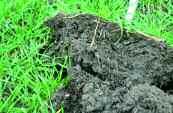
yield. That’s down to the flag leaf that must be an inch wide and soaks up the sun. I like Gravity because it tillers like mad, but its

KWS Cranium is the agronomist’s dream variety, reckons KWS product development manager John Miles.“It’s different,but this is in areas that are significant on farm,”he says.
Yield-wise the variety sits in the top of the pack of Group 4 hard wheats,a new entrant on the 2021/22 AHDB Recommended List.“But it retains this yield performance as a second wheat,while it outstrips any other variety where it’s late sown
septoria susceptibility, coupled with the loss of chlorothalonil, makes it a risky choice and I think this year will be our last with the variety.”
Still in the shed and yet to be drilled is KWS Cranium. This is a variety that was grown for the first time as a seed crop for the 2020 harvest. The plan has been to bring it into the main wheat portfolio and take advantage of its suitability for the late slot, eventually taking the place of Gravity. But the wettest October Ed can remember has kept the drill out of the field.
“We have Cranium lined up for our late-sown and second wheat slot. Many growers may choose to put it after roots, but our potatoes and sugar beet go on our lighter land, while Cranium’s suited to heavier soil.
“With Kielder in its parentage the variety knows how to yield and spreads the combining window –– at harvest this year, the Kinetic had gone golden while the Cranium was still bright green. But it produces a huge ear –– I’ve never seen anything
The cropping is geared around improving soil health with cultivations cherry-picked for the soil,the crop and the field conditions.
like it, each carrying around 80 grains,” he remarks.
Last year, the crop was drilled on 24 Oct –– relatively late for a business that prefers to have drilled up its main wheat crop by the second week of Oct. “It was a difficult autumn, but at least we could actually get the crop drilled. As with all our seed crops, it followed the double break of a herbage ley.
“The Cranium emerged well, but didn’t tiller as much as Gravity and was slow to start in the spring. But then it really put on some pace and raced through the growth stages. It was a shame the season was
–– in trials in Framlingham, Suffolk,sown in late Dec/Jan,Cranium delivered 113% of controls,” he notes.
John puts this down to the recovery of the variety –– its ability to catch up when sown late. KWS trials have identified Cranium as a fast developer in later sowings.“It has vigour,but it also has stiffness –– that’s where a lot of fast-growing varieties fall down.And this recovery goes right the way through to its late harvest –– Cranium is a variety that wants to maximise its yield.”
A strong score on yellow rust comes from Timaru that’s in the variety’s parentage and also gives the variety seedling resistance.This is coupled with a respectable 6.0 for septoria and there’s also orange wheat-blossom midge resistance,he adds.“We’re calling it the wheat for the thinking grower because it ticks a lot of boxes.”
KWS wheat breeder Mark Dodds notes that Cranium has KWS Crispin and Kielder as its parents. “Crispin doesn’t grab headlines for yield,but always performs in later sowings, particularly after roots.The problem with the variety is its straw.”

That’s where the Kielder comes in with good straw stiffness and high yield. “The result is a really useful package of four agronomic traits:OWBM resistance,stiff straw,yellow rust resistance and a high yield –– that’s an attractive combination, particularly for growers in the East,”notes Mark.
Cranium puts on strong growth in the autumn, competing well with blackgrass, he adds. “It’s more upright than most, tillers well and grows steadily through the winter.The real added bonus is its performance in later sowings,”he concludes.
so dry as the crop did suffer some water stress. But it was pretty clear of disease throughout.
“We applied CTL until the T2 timing and dropped back the rate of Ascra at T1. In hindsight, given the season, we could have gone with a cheaper T2 than Verydor. All we saw was a bit of mildew to start with then a little septoria and a spattering of rust, but nothing that would have troubled yield,” recalls Ed.
held onto its green leaf area until late in the season, and was one of the latest wheats to be harvested on 11 Aug. “One thing we noticed was a low specific weight, which I think was down to those large ears and the lack of sunlight in June. It may be that you can manage the crop to feed the ears a little more at the end of the season, which would add a little to the yield, too.”
That said, Ed was pleasantly surprised with a crop that came over the weighbridge at 10.77t/ha, against a farm average of 10.87t/ha. “That’s impressive for a late-drilled wheat, and lines it up for our second wheats, especially on stronger soils. We usually give these some farmyard manure, so I reckon it won’t be difficult to bring the performance of a late drilled Cranium up close to our first wheats.”
He’s expecting this will bolster the heap of Group 4 hard feed wheats they’ll have to sell. Here again, Ed has a close eye on the market and is looking for post-Brexit opportunities. “I’m not a fan of Group 1 milling wheats as all too often you fall foul of spurious rejections. But we have found some local mills that are now taking around 40% of our feed wheat into their grists and paying a small premium.”

While the wide rotation,with a focus on the soils have always been strengths for the business, Ed Salmon plans to use digital technology to adapt the system for the future.

risk and window, but we don’t want to over-complicate things. That’s why Cranium fits in well –– it serves a purpose putting a dependable variety in the late, second wheat slot,” Ed concludes. ■
KWS Cranium performed well as a seed crop for 2020 harvest,but the area planned for this autumn has not yet been drilled.

As for the rest of the rotation, while it’s unlikely soya will become a permanent feature, Ed’s bringing in the latest digital technology in his quest to help determine how the farm’s rotation will adapt through the transition after Brexit. The business is collaborating with a number of other farmers in the area on around 8000ha in total, employing a data analyst to sift through the wealth of digital information they’ve amassed to identify and pinpoint opportunities for their systems to evolve and adapt.
“It’s the wide rotation, with our focus on the soils that have always been strengths for the business. There’s potential for digital farming to help refine how this goes forward, further improving its sustainability. With the wheats, we want to keep the spread of
The Brexit-ready marketing strategy involves identifying opportunities to displace imports and premium markets found for the Group 4 hard feed wheats.
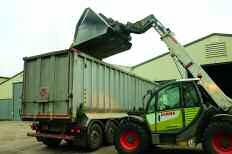
In this series of articles, CPM has teamed up for the third year with KWS to explore how the wheat market may evolve,and profile growers set to deliver ongoing profitability.
The aim is to focus on the unique factors affecting variety performance,to optimise this and maximise return on investment.It highlights the value plant genetics can now play in variety selection as many factors are heavily influenced and even fixed by variety choice.
Compost is among soil additions used to bring a steady rise to organic matter levels.

KWS is a leading breeder of cereals, oilseeds,sugar beet and maize.As a family-owned business,it is truly independent and entirely focussed on promoting success through the continual improvement of varieties with higher yields,strong disease and pest resistance, and excellent grain quality. We’re committed to your future just as much as you are.

included commitments to sustainable food and farming practices, although there was no mention specifically of any incentives for pulses. “The obvious place for this is the Sustainable Farming Incentive,” he suggests.
“The door’s wide open for pulses. I can’t think of another crop group that could offer a better pathway to a more sustainable way of farming and source of food.”
well-managed pulse crop into the rotation, that would bring the current crop area from the current 5% of arable cropping to 15-20%. This would have a substantial impact on the 3.8M tonnes of soya we currently import and result in a massive reduction in our overall carbon footprint, not to mention the soil health and other environmental benefits that would bring.”
The renewed call for action builds on PGRO’s Blueprint for UK Pulses in a post-Brexit world, a strategy document produced two years ago. This laid out specific steps to exploit the potential of pulses to address the changes and challenges facing growers, researchers and traders following Brexit:
● Encourage cropping for environmental good. Specifically targeting pulses and vegetable legumes to aid the sustainability of UK food production systems in agriculture.

● Take an approach to crop protection and nutrition to assist the production of pulse crops, ensuring more economic productivity and reliability.
● Incentivise the feeding of UK-produced plant proteins to drive local demand and fuel production.
By Tom Allen-StevensUK growers have the opportunity to displace a considerable proportion of imported soya and make a step change on their journey to Net Zero. But it will take a firm commitment to bring a pulse into the rotation, and solid support for home-grown protein crops from Government.
The call comes from PGRO CEO Roger Vickers following the release of Defra’s Path to Sustainable Farming. The policy paper, released at the end of Nov, sets out the Government’s Agricultural Transition Plan, shifting payments from direct subsidy to public money paid for public goods.
“The need for home-grown pulses has received plenty of support from the wider public, but not a lot has happened on farm or in terms of policy that would effect any change,” he told CPM
He points out the Defra policy paper
Roger’s not in favour of a direct crop subsidy nor area payment for pulses, but suggests there could be an option to meet a particular target under a wider incentive for more flowering crops, for example. He’s also keen to see the crop receive more R&D and on-farm agronomy support to boost returns from pulses under the elements of the Defra plan to improve farm prosperity.
“If every UK grower brought a
● Stimulate investment of private equity in industrial processing and ingredient manufacture to kick-start demand and to drive increased, more efficient production and to add value.
● Increase education of growers and the supply chain about the environmental and economic benefits of pulse production.
● Set out a clear strategy of education in schools via the national curriculum to stress the health benefits of pulses, food origins and to encourage healthy eating choices.
● Require public procurement and service providers to take a lead in the provision of healthy pulse-based diets and education initiatives.
● Require Government departments to col late and distribute timely, accurate public supply statistics.
● Set up a market and research development platform with trade and research organisations to identify research priorities for funding initiatives with a unified approach.
The door of opportunity is wide open for pulses, reckons Roger Vickers.
● Use public funds for public good research directed at agronomic risk reduction, developing UK traits for genetic improvements, pulse crop diversification and added-value processing.
Roger believes the ability for growers to

With the right incentives and a commitment from growers, there’s a very promising future for protein crops. CPM assesses the policy pathways,market opportunities and varieties that could make that happen.
There are growers producing excellent pea and bean crops and following really innovative practices that would be fascinating to explore.
“ ”
apply good agronomy and crop protection is mission critical in building a greater area of profitable protein crops. “The direction of travel is towards regenerative agriculture. But these systems still include an element of crop protection to optimise productivity and result in the most sustainable outcome,” he points out.
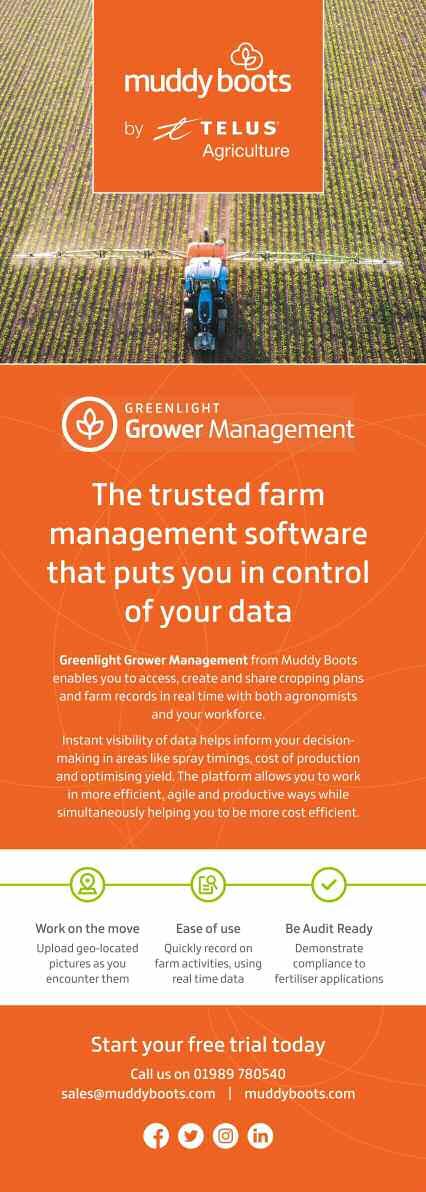
“The amount of agrochemicals applied to pulses is miniscule, but growers and agronomists cannot be hemmed in by regulation that prohibits its use. The loss of products such as diquat with no viable alternative results in a vicious circle for protein crops. It’s a sector too small to warrant the large investment neededby agrochemical companies to support products, but too large to qualify for a derogation or EAMU.”

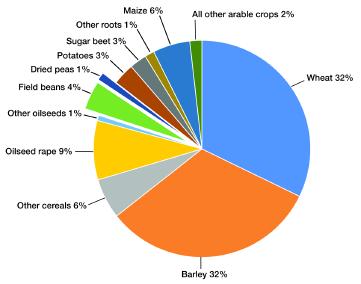
Managing director of LS Plant Breeding Chris Guest believes the reduction in oilseed rape area and move away from sugar
Policy
crops.
beet do create opportunities for pulses. “Current market demand could utilise a doubling in the pulse area –– there’s currently lots of interest in pea protein,” he says.
“The UK would require investment in a fractionation plant to properly benefit from this new and exciting market opportunity. New technological advances, for example the work being done by the Cambridge start-up Xampla looking at a plastic alternative from pea protein, is very exciting for the future.”
In beans, he believes there’s a “huge opportunity” in the animal
feed sector, particularly in monagastrics, such as pigs, and poultry. LSPB is responsible for breeding or marketing over 85% ofthe bean varieties grown in the UK and Chris sees great potential for those low in vicine and convicine (LVC). These are pyrimidine glycosides that can decrease feeding efficiency in monogastric animals.
“I don’t see a rise as significant as a quadrupling of the pulse crop area, but policy support is justified –– work by the Game and Wildlife Conservation Trust has shown the benefit of beans and peas within the rotation to farmland wildlife, with an extension to the flowering period benefiting insect life and onwards to bird species including the grey partridge.
“It will be interesting to see how Defra’s innovation and R&D element rolls out as there are many potential opportunities here, including further potential work on LVC beans. We’ll assist wherever possible with industry lobbying to ensure that additional R&D can be targeted to the pulse crop,” adds Chris.
Roger’s also keen for support for farmer-led R&D. “There are growers producing excellent pea and bean crops and following really innovative practices that would be fascinating to explore. Let’s find the IPM approaches progressive growers are already utilising and make a step change in prospects for the crop,” he says.
The PGRO has launched its 2021 Descriptive Lists (DL) for combining peas, winter and spring beans. The list represents a significant change for the levy-funded lists as the data moves from its long-established Recommended List format.
“The result will be a more open system that gives breeders the freedom to innovate,” says PGRO principal technical officer Stephen Belcher. “They’ll know their products will be independently trialled and presented without judgement giving them the opportunity to react more quickly to market interest.”
Challenging weather was a theme across all crops during the 2020 trials, he reports, but several new varieties have delivered encouraging results and the conditions provided a greater level of disease information for pulse growers.
“Lack of rainfall post drilling in the spring gave rise to patchy and uneven emergence for many trials and crops with double emergence a common occurrence.”

Yields are therefore well down on 2019, with winter beans suffering the worst. The control yields for 2020 were 2.72t/ha for
peas, 3.68t/ha for spring beans and 2.67t/ha for winter beans.

“Powdery mildew in peas became a significant problem late in the season, while late rust in spring beans was a problem in some trials,” notes Stephen.
Stella, one of three new varieties from Saaten Union now tops the list with a yield of 108%, just ahead of LSPB’s Lynx, added to the list five years ago. Capri and Daisy, also from Saaten Union, have also joined the 2021 list.
“Both Lynx and Yukon continue to show very good tolerance to downy mildew,” comments Stephen. Bolivia, from LSPB has been added to the electronic version of the DL, available on the PGRO website, while LG Viper and LG Sphinx from Limagrain and Allison from LSPB will be added, subject to
A pulse crop in every rotation could have a substantial impact on the 3.8M tonnes of soya imports and result in a massive reduction in the UK’s carbon footprint.
confirmed National List status.
Although all eight trials were taken through to harvest, yields varied from 6.29t/ha in North Yorks to 1.88 t/ha in Lincs, Stephen notes. Vespa is still the top-yielding winter bean variety at 109%. Vincent and Norton, both from Senova, are
Chris Guest believes there’s a huge opportunity in the animal feed sector for beans,particularly in monagastrics,such as pigs and poultry.
new high-yielding additions to the list, subject to confirmed NL status.
“Spring bean Lynx has proven itself as a very consistent performer,” comments LSPB’s Chris Guest. “A great combination of yield and agronomics still make this the market leader. Macho has a very large seed size, making it suitable not only for human consumption export markets but also the fish food market where the skins are removed.”
Chris points growers to the availability of LVC varieties. “We’re working hard to build awareness of this valuable trait, present in Victus, Tiffany and now Bolivia. LVC represents an added benefit to other market opportunities.
“Yukon, new to the market last year, combines very early maturity with excellent downy mildew resistance and brings a new opportunity to growers from York to the Scottish Borders where late harvest can lead to issues.” There’s limited seed availability of this variety for next year, however, he adds.

Nudging just behind Lynx in yield terms is LG Raptor, scoring 105% over control on the new DL, notes Limagrain pulse breeder Will Pillinger. “Yield is the most important factor for spring beans, and a major focus in our breeding programme. LG Raptor offers extremely high yield potential that could see it out-yielding the market leader by next season.”
This season has seen the variety produce a uniform sample, while it also has solid agronomics and traits, he adds. “It is fairly early to mature, stands well and offers a good disease package including rust. This combination of traits makes it a good variety for the north.”
LG Raptor is suitable for human consumption, fish feed and animal protein markets.
At 120% of controls, last year’s newcomer Kameleon from Senova tops the yield rankings in the yellow/white pea category, closely followed by Orchestra at 115%, notes Stephen. “New to the list for 2021 are Kaiman from Senova and IAR Agri’s Raider.”
New additions in green/blue peas for 2021 are LSPB’s Stroma, Kiravi from Senova Greenway and Mikka (IAR Agri). “Kactus emerged top of the yield rankings at 112%, closely followed by Bluetime and Stroma at 111%. Blueman came top for tolerance to downy mildew with a rating of 8. Kactus, Karioka, Mikka, Croft and LG Aviator followed with 7,” he adds.
In the marrowfats, Akooma from LSPB is new to the 2021 list with a yield of 97% ––11% higher than Sakura –– and with a very large seed size, notes Stephen.
“Our new marrowfat pea is really exciting,” comments Chris. “The market has been


With AHDB’s Early Bird Survey figures suggesting a further slight rise of 7% in the area grown to pulses, the trade is reporting increased interest in pea cropping for 2021 and requests for contracts are being welcomed, notes president of Pulses UK Lewis Cottey
“As for beans,the large Australian crop has begun to find its way into the market. With better visual quality, they’re undercutting UK feed bean prices and demand for UK beans for human consumption has dried up.”
The variability of the cropping season remains a conundrum,he says,but there’s confidence demand will return later in the winter “For now, feed bean prices appear to be supported by recent increases in wheat,soya and rapemeal prices.”
These are seeing beans leave the farm at £210/t.Prices for new crop (2021) are around a £30/t premium on Nov wheat.Good sample marrowfat peas are currently getting up to £305/t on the open market while contracts for new crop are getting up to £335/t ex farm.Pale/bleached green/blue peas might get £220/t with the best quality trading at £270/t.New crop contracts are in the range £215-260/t ex-farm.
“More recently yellow/white peas have started to attract a little more interest from both domestic processors and European buyers,although from a very low level within the UK.This probably reflects the growing profile peas are getting in health messages,flour production and snack processing,”adds Lewis.
crying out for a new marrowfat for many years, one that also improves yield and agronomics at the farm level. Akooma really looks to be a step in the right direction in this segment.” End user testing has just started and early indications have been very positive, he reports.
LSPB’s Bluetime brings a high-yielding green/blue pea to growers in the South at 111% of controls, he notes, while Blueman offers high resistance to powdery mildew, along with its score of 8 to downy mildew.
LG Aviator has the same high resistance to powdery mildew, offering a 7 against downy mildew, points out Will. New to the list last year and with a yield rating of 103% over control, LG Aviator is a multi-podded variety type, he explains.
“For each node it produces, there are three pods. This means there are more pods at the top of the plant, making for a more even maturity with less competition for light. This is a significant characteristic in building yield. It’s early, and has good ratings for standing ability and straw length (rated 6),” he adds.
More analysis and the full 2021 PGRO Descriptive List can be found in the current copy of the Pulse magazine, included with this issue of CPM ■
Yellow/white pea interest reflects the growing profile they’re getting in health messages,flour production and snack processing.
Current values are in the region of £215/t ex farm.He tips yellow peas as having a significant role to play in the future of UK pulse production, and notes 2021 contracts are available.
Spring oats combine a food with recognised health benefits and a crop that leaves the soil in good heart.
CPM explores the agronomic value and market prospects of the crop and leading varieties available for 2021.
By Tom Allen-StevensA crop that roots voraciously, bringing soil health benefits,that competes well against blackgrass and produces a food with recognised human health benefits –– what’s not to like about oats?
“With the trend for more spring cropping, widening of rotations and less reliance on oilseed rape as a break, and with prospects for spring barley perhaps not as good as they were, spring oats are gaining favour,” notes Saaten Union UK cereals product manager Andrew Creasy.
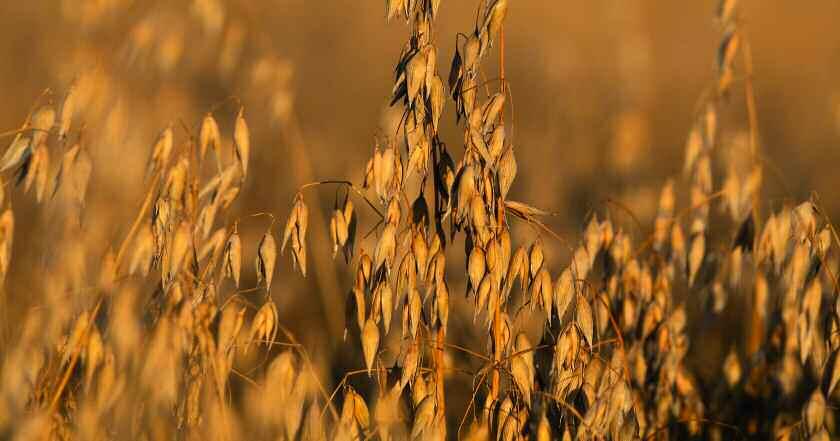
“There’s strong demand, especially for milling oats, and unlike some other spring breaks, it’s a crop growers are familiar with. What’s more, the varieties now available do present growers with a nice range of options to fulfil some of the market opportunities.”
Saaten Union UK represents leading German plant breeder Nordsaat, with whom Elsoms have an exclusive arrangement in the UK. Andrew’s also been working with UK oat processors to help bring to the UK germplasm specifically adapted for the
northern European climate that has real domestic promise. The collaboration has resulted in Lion, a milling-quality variety that joins a strong offering of high-yielding feed types (see panel on p21).
So what qualities make a spring oat resilient within the arable rotation? “Agronomically, growers look primarily for a dependable yield. But one of the biggest benefits of oats is their competitive nature –– they cover the ground so quickly, which is a key feature, especially in a spring-sown situation and where blackgrass is an issue,” Andrew points out.
“Spring oats are also strong-rooting, which makes them good soil conditioners, especially on heavy-land sites. They have a reputation for leaving the land hungry, but I’d say they leave a good tilth and they’re a take-all break so a good entry for a first wheat.”
Other qualities to look for are straw strength and height – oats grow tall so benefit from use of growth regulators. “PGRs should be matched to season –– if it’s cool and dry during stem extension, their use can check growth harshly. But oats are vulnerable to brackling and lodging later on if the canopy isn’t well managed,” he advises.
Compared with other cereals, disease is less of a consideration. “Mildew can be an issue for some sites, while late in the season crown rust can be a problem –– a bit like brown rust in wheat. But both are very easily managed in susceptible varieties with a one or two-spray fungicide programme.”
When it comes to the market, oats score
favourably, with domestic demand enjoying a steady rise of around 10% per year. “But it is important to have a market lined up for your crop –– the spot feed market has relatively poor returns,” Andrew notes (see table on p20).
“Processors look for high kernel content –– the proportion of the grain that can be utilised – and hullability, which is the ease with which the hull is separated through the mill. Oats have either a white or more yellow hull, which affects flour colour, and some markets prefer a whiter hull, especially in Northern Ireland and certain export destinations.”
Most spring oat varieties are husked, which means they retain their hull through the combine, he explains. “The hull makes up about 30% of husked varieties, which explains the lower apparent yield of naked types. But most processors prefer the quality of husked varieties, despite the need to de-hull them.”
▲
Oats cover the ground quickly, competing against blackgrass, says Andrew Creasy, and they leave a good tilth.
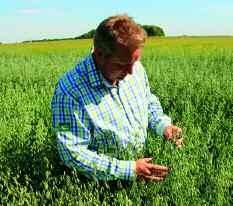
We have extraordinarily good feedback from commercial mills – they’ve been euphoric.
“ ”
Newcomer to the RL Lion has very strong scores for kernel content and specific weight,with the resulting high extraction rate drawing favour from millers across Europe.
OatsBarley

Seed7167
Fertiliser7885 Sprays96151
Total Variable costs245303
Yield (t/ha)6.256.50
Cost per tonne (£)39.2046.61
PremiumReturn862.50942.50 market G margin617.50639.50
Feed Return737.50877.50 market G margin492.50574.50
Source:John Nix (costs + yield); AHDB (spot prices at 08/10/2020):malting barley £145/t,feed barley £135/t, milling oats £138/t,feed oats £118/t; all figures in £/ha, unless otherwise stated.
Richardson Milling, with a base at Bedford, and Quaker with mills in Scotland are two key UK buyers for human
Initial results from milling spring oat newcomer Lion suggest good prospects for the variety in domestic markets,as well as for export destinations.
Richardson Milling (UK) is the biggest business-to-business buyer of oats in Europe, notes the firm’s agronomy manager Brin Hughes. It’s owned by Richardson International,Canada’s largest agribusiness,that purchased European Oat Millers from the Jordan family in 2017. Along with Jordans,Dorset Cereals and Oatibix (the oat-based version of Weetabix) are among the popular brands supplied by the Bedford mill, from oats and other cereals sourced mainly within an 80-mile radius.
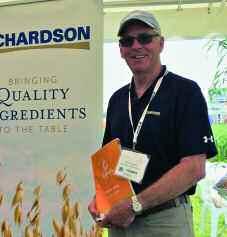
“We’ve seen a steady growth in demand that’s doubled over 20 years,” says Brin. “The entire UK oat market is about 1M tonnes,with human consumption taking about half.The strength in demand is largely down to the health benefits.”
Oats are proven to be high in beta glucans,a soluble dietary fibre strongly linked to improving cholesterol levels and boosting heart health.“In processing terms,the key for us is an oat with good hullability and low hulling losses.These are related to kernel content,but also with how the oats travel through the mills and how easily the hull shatters –– some varieties dehull more easily than others.Every mill has its own set-up so you’ll find millers differ with their favoured varieties,” he explains.
The colour of the oats –– the whiteness of the finished product –– is less of a concern for the Bedford mill.A typical contract will specify more than 50kg/hl specific weight with less than 6% screenings.“While we’re considering adding hulling losses,we don’t currently have a contract spec but look for varieties with less than 30%.
Winter varieties tend to have lower screenings and are the only ones we buy on contract,comprising around 80% of throughput,although we process a considerable spring-sown crop.”
Brin works closely with breeders to identify and encourage varieties that perform well through the mill.“Elyann has historically been our preferred spring oat,but what we’ve seen of Lion this year is looking very promising.Bearing in mind harvest quality was generally very good,Lion achieved hulling losses from the limited samples we tried as low as 20%,which is fantastic.This is a variety we are interested in.”
Harvest 2020 contrasts starkly with the previous two seasons,however.“We’ve had two horrendous years for the spring crop,with drought and poor weather hitting specific weight,and screenings over 10%.We don’t yet know how Lion will perform in a more challenging year,but
consumption, he adds (see panel below). “Mills have their preferred varieties, with Quaker favouring Canyon from Scottish growers and Richardson looking very favourably on Lion. There’s a strong demand from some outlets for feed varieties, especially in the South West.”
The Saaten Union lines, marketed through Elsoms, have come from Nordsaat’s North European breeding programme, based on the Rügen peninsular in N Germany. The company has the largest multiplication area of spring oats across Europe.
“One trait in particular we’ve focused on for the N European market is straw strength,” notes oat breeder Dr Steffen Beuch, who heads up the breeding station and has developed the company’s oat breeding lines over 20 years into the market-leading position.
“PGRs aren’t allowed in some of the

Brin Hughes believes there’s potential to improve the on-farm performance of spring oats.
currently we’re happy with it for 2021 plantings.”
He’s keen for growers with attention to detail to get involved with oats.“It’s a fascinating crop,with very elastic potential to adapt to its situation, but we don’t don’t know enough about it –– oats don’t attract as much R&D investment as wheat or barley.”
He advises sowing at a relatively low seed rate of 300 seeds/m2 early,ideally Feb or early March to encourage roots to explore. Around 130kgN/ha gives the crop what it needs, split 30% in the seedbed and 70% soon after emergence. “Although the crop’s seen as low input, in my experience a decent two-spray triazole/strobilurin fungicide programme usually pays dividends.
“But we’re way off understanding some of the details about this crop, such as the optimum grains per panicle and how to balance N and PGR use to coax the best performance. There’s real scope for the professional grower to get a really healthy return from some careful crop management,” notes Brin.
markets of this region. There’s a general preference for white-hulled varieties, while yield stability and foliar disease resistance are key requirements for UK and Ireland.”
Lion has been a particular success for Nordsaat, he notes. “It’s short, early, very stiff with a very stable yield. It’s not the highest yielder but adapts well over many different sites which is a mark of consistency.
“Lion’s stand-out feature is its quality ––it has the best kernel content of all spring varieties, coming out consistently high in all trials and all years, with a high extraction rate and good hullability. We have extraordinarily good feedback from commercial mills across Germany ––they’ve been euphoric.”
Steffen expects Lion to get a similar reception from UK millers. “It’s almost ten years since we introduced our first spring oat, Canyon, to the UK, which now has some well established market outlets. Lion represents a step-up on quality.”
Yukon he calls a “classical” oat, performing well in low input situations. “It has very good standing ability and is short. Delfin is similar although has slightly better quality, but the remarkable aspect
of this variety is its yield –– it’s the highest yielding spring oat across Europe. It delivered a staggering 13t/ha in a trial in Sweden, which is the highest I’ve seen for a spring oat,” he notes.
He now has his eyes set on Scotty and Tasman, both candidates for the UK and both with Yukon in their parentage. “Scotty has been yielding top consistently across N Europe. It combines this with early maturity, good straw stiffness, disease resistance and quality. This isn’t as high as Lion’s, although it’s a white-hulled variety. Tasman is even higher-yielding, especially in untreated trials, so we’re expecting a strong uptake among organic growers. It has good specific weight and hullability.”
Growers who suffer mildew will benefit from very high ratings for the disease in the future –– two genes have been identified and crossed into lines that are making their way through the N European programme, reports Steffen. But an issue identified by breeders is a widening yield gap between the best of new material in trials and on-farm spring oat performance –– higher

Over 20 years,Nordstat breeder Steffen Beuch has developed some of Europe’s leading spring oat lines ,but notes a yield gap with on-farm performance.Photo Saaten Union.
than in wheat or barley
“The potential is there for UK growers to significantly raise the returns from spring oats with good management. Meanwhile we’re using the latest breeding techniques, such as genomic selection, to advance the spring oat lines, and the result is really good diversity and robustness in the traits we’re now bringing forward. That will ensure resilience for rotations across Europe in years to come,” he concludes. ■
(days
0 0 0 -1 Resistance to lodging887[9] Straw length (cm) 111106110[104]
resistance
8783
rust454Source:AHDB
data.*NOTE:Lion
a candidate variety so figures are not
Less oilseed rape, spring cropping, a focus on improving soil health and building carbon all rely on a cropping rotation that is resilient. Each crop must deliver a profit on the year while the rotation as a whole should ensure the farming business remains sustainable for years to come.
comparable
that
Saaten Union. Delfin has not only the highest treated yield but also tops the spring oat RL with its untreated performance.This is coupled with one of the strongest scores on the RL for mildew and good stem stiffness, making the variety suitable for organic and low input situations.Performing particularly well in the East,its main market is for feed,although there are milling outlets that take the variety. Yukon has a very similar profile to Delfin,with the second highest untreated yield on the RL.It has a slightly lower mildew score, but performs better on crown rust,is slightly shorter and stiffer. Canyon has the edge on quality,with similar disease scores and straw stiffness to its stable mates. The first Nordsaat variety to make it onto the UK RL,it retains a mid-range yield performance that’s dependable and is one of the widest grown across Europe.It’s a yellow-hulled variety used by Quaker, making Canyon a popular choice for growers in the north of England and Scotland.
Lion is the newcomer,still a candidate on the RL,but with very strong scores for kernel content and specific weight in a yellow-hulled variety.The resulting high extraction rate is drawing favour from millers across Europe.Stiff-strawed,it’s also significantly earlier maturing,although mildew is one disease to watch for.
In this series, CPM partners with Elsoms to look at the opportunities offered by cereals other than wheat and delves into the genetics behind them. Through privileged access to the company’s staff and resources,these articles explore rotations that secure a reliable return today and offer bright prospects for the future.
Elsoms Seeds is the UK’s leading independent seed specialist and plant breeder.The company’s experienced, specialist staff combine a passion for high quality vegetable and agricultural seed with the latest in plant-breeding research and seed technology.This ensures a focus on high performance and low-risk varieties,building resilience into rotations for years to come.

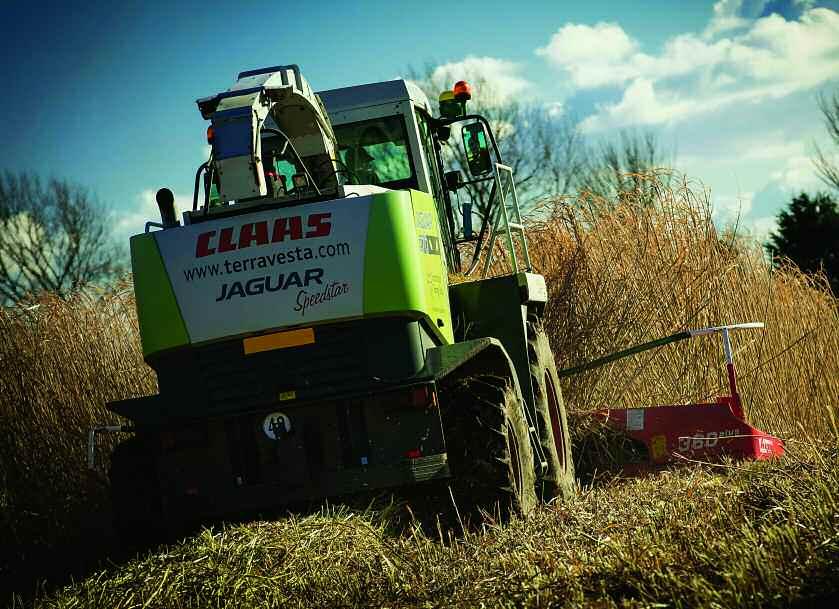
There’s less than a 20-year timescale for UK agriculture to meet the NFU’s Net Zero target– that’s also less than the lifecycle of the biomass crop,miscanthus. CPM explores the potential of a crop with a market that’s beginning to expand rapidly.
By Lucy de la PastureFarming with carbon in mind is something many growers are getting to grips with –– partly because increasing carbon in the soil goes hand in hand with soil health,but also by necessity as the industry sets its sights on achieving Net Zero by 2040.
Sarah Wynn, principle sustainable food and farming consultant atADAS, says many growers are choosing to look at carbon accounting on their farms –– a process which was driven primarily by the supply chain until very recently.

Although there’s a lot of discussion about the discrepancies between the carbon accounting tools available, Sarah says the absolute numbers they provide don’t really matter. “The important thing is to choose a tool and then stick with it so you can see the direction of travel and then the results will help drive the adoption of the right carbon practices.
“Generally the tools are very good at calculating emissions but less so when it comes to carbon capture. The interaction of soil type, environment and carbon is very complex and the science is only just catching up with demand.The risk is that the tools oversimplify things and, in some cases, over-estimate how quickly soil carbon can be accumulated.”
Carbon capture and sequestration is much more nuanced than is widely believed, explains Sarah. “In a normal annual cropping cycle, we don’t look at carbon capture in carbon accounting because it is so transient. It’s true to say a winter wheat crop will capture carbon dioxide by photosynthesising and build the assimilates into plant-based material, However the grain is then consumed and
the straw either incorporated, used for livestock or combusted, releasing the carbon stored in it.”
Building soil organic matter is acknowledged to be a very slow process and exactly the same applies to soil carbon, which is why coppice and timber are more effective ways of sequestering carbon –– particularly if the above-ground biomass is used in construction, which
Sarah Wynn explains that carbon capture and sequestration is much more nuanced than is widely believed.
Over time a carbon equilibrium will be reached
“ ”

Underground the miscanthus adds carbon to the soil over its lifetime, whereas above ground the harvested biomass only offers a transient capture of carbon.

only a change in management practice will enable the crop to accumulate more carbon. For, example changing from an intensive grazing regime to a rotational one, where the grass is rested so it has more chance of capturing carbon, will allow the crop to continue to add carbon to the soil.”
of carbon. But over time a carbon equilibrium will be reached so then you have to look to do something else, such as introducing cover crops into the rotation or adding organic amendments, to continue to enhance the carbon in the soil,” explains Sarah.
But carbon doesn’t travel in just one direction so the problem remains that growing practices also have the potential to release carbon as well as store it, highlights Sarah.
▲
maintains the carbon ‘under lock and key’.
That’s not to say shorter term crops don’t have a role to play in increasing soil carbon, explains Sarah. “When a grass ley is planted, it starts to accumulate carbon by putting on biomass –– with its roots, root exudates and leaf matter
all adding carbon to the soil. So over time the grass ley sequesters carbon until it reaches a state of equilibrium and then it becomes carbon neutral, if it’s continuously managed in the same way, where the carbon it uses equals the carbon it stores.
“Once this point is reached,
Even so, there is a ‘but’ when it comes to the influence of a management change, she highlights, because different soils or vegetation types behave in different ways and climatic conditions can either promote emissions or carbon sequestration.
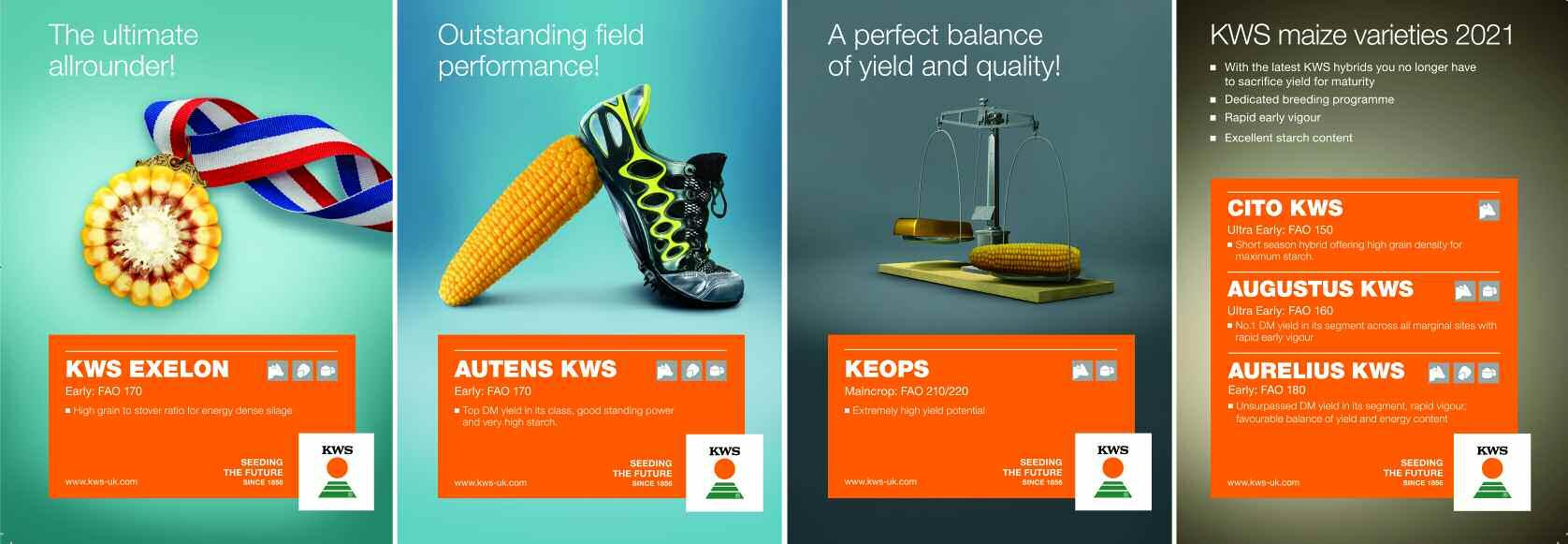
Min-till and no-till cultivations minimise the release of carbon from the soil but exactly the same principle applies as it does when a new crop of grass is planted. “When a change is made from ploughing to min-till, or from min-till to no-till, there will be a gradual accumulation
“All the benefit from moving to a system of minimal cultivations can be undone if the ground has to be ploughed for agronomic reasons. The carbon turned up in the soil will become oxidised when it’s exposed to the air and released as carbon dioxide.”
Because carbon is so easily released from soil and this happens much more quickly than it can be accumulated, Sarah believes it’s important to
have a good understanding of the processes involved in the carbon cycle and the practices that influence them.
Crops which occupy a longer term in the rotation, such as miscanthus, can add a pool of carbon to the soil over its lifetime. “Miscanthus is planted as a small rhizome which accumulates biomass each year until it becomes a large root body –– allowing the soil to accumulate carbon. The leaf litter falls which also replenishes carbon in the soil.
“The above ground harvested biomass only offers a transient capture of carbon, although there is some carbon offset to put against otherwise burning a fossil fuel. If the miscanthus is used as a biofabric then this will lock the carbon up over a longer period of time.”
Miscanthus is currently grown on over 7,000ha of marginal land in the UK and its mainly supplied to whole-bale
biomass renewable energy plants, which power over 200,000 homes. The crop could have a key role to play in reaching Net Zero emissions in agriculture and not only is it scalable –– it’s making waves in the industry as new technologies and markets emerge.
Earlier this year, the UK Committee on Climate Change (CCC) released its “Land use: Policies for a net zero UK” report, stating that expanding biomass crops, including miscanthus, by around 23,000ha/annum would deliver a 2Mt CO2e emissions saving in the land sector. Additionally, it highlighted that an extra 11Mt CO2e reduction in emissions is possible by using harvested biomass for construction or bioenergy with carbon capture and storage (BECCS).
Jonathan Scurlock, NFU chief adviser for renewable energy and climate change, believes miscanthus can contribute significantly to UK
net zero targets. “The NFU expects growth in land use for perennial energy crops like miscanthus to result in feedstock supply for bioener gy, displacing fossil fuels, supply of bio-based materials and also bioenergy coupled to carbon capture (BECCS), all of which are essential components of our

ambition for Net Zero agriculture and will contribute to the overall national goal,” he says.

Over a period of time a crop or management practice becomes carbon neutral and a change in management is then needed to capture more carbon. ▲
“Probably the largest bulk end-market will remain as a feedstock for power generation, which is likely to include carbon-negative technology in the future, but miscanthus also has potential as a fuel for
Miscanthus acts as a net carbon absorber which helps mitigate against greenhouse gas emitted by the land-use sector,says Alex Robinson.
district heating, as a supplement to wheat straw for anaerobic digestion, and as a source of fibre products for a growing bioeconomy.”
Expanding the sustainable future of the crop is miscanthus specialist Terravesta, a company which works with over 300 growers throughout the UK, facilitating planting, providing agronomic support, securing markets and offering long term contracts.
“Agriculture is seen as a significant carbon net emitter. With miscanthus, what you have is a proportion of land that’s a net carbon absorber which helps to mitigate against greenhouse gas emitted by the land-use sector,” says Alex Robinson, the company’s operations director.
Rob Meadley,agricultural business consultant for Brown and Co and an East Yorkshire arable farmer,grows 12ha of miscanthus on outlying land of varying quality which wasn’t delivering a viable return with arable crops.


His crop is coming up to eight years old and had a slightly difficult start.Rob planted miscanthus in March 2012 in good conditions, but this was followed by the wettest April on record,meaning the freshly planted crop was in standing water and then the bad weather hit again in June.
“We therefore couldn’t control weeds on a poor-quality field with a heavy weed burden,”he says.“We applied a selective herbicide in August that year,then the following year we topped it and controlled the weeds.Apart from a little patch spraying in 2014,no herbicide has been used on the crop,which out-competes the weeds each year.
“The only issue to note was on one of the headlands –– where the forager and baler turns,we noticed compaction.We used a low disturbance subsoiler and this affected the height of the crop across a couple of passes, but the following year it was back to normal.”
Rob explains that the 2014 harvest was affected by the legacy from flooding and lack of weed control,but arable crops would never have survived the conditions that the miscanthus was exposed to and he didn’t lose any money on inputs.“The annual yield quickly recovered,and in 2017 we had a bumper harvest of 13t/ha.”
Rob believes it’s the right crop for this land and has not only met the budgeted return but has introduced additional ecological benefits to the farm.
“We’ve had a number of RSPB surveys done
on the farm and the feedback was that they were genuinely surprised by the abundance and diversity of birds in and around the miscanthus, including curlews,rarely found in East Yorkshire,”explains Rob.“We also saw breeding deer,brown hares and an abundance of invertebrates.”
The miscanthus-planted area has allowed Rob to square off an arable crop next to it and has also helped to naturally control blackgrass. The field is two miles away from the farm, meaning the minimal maintenance required is noticeable,he notes.
Ultimately,Rob says that there wouldn’t have been another option for a crop on that land which would have been as profitable.“In 2012 when we decided to plant miscanthus,the principle was looking at the whole farm net margin and identifying the risk in this area.
“It wasn’t performing as well as other parts of the farm and miscanthus was 100% the right decision for it.The only other option for that land would have been environmental grass,but miscanthus beats this hands-down from a net margin point of view
“Miscanthus is a vitally important crop due to
Terravesta is working with scientists to introduce new ‘performance hybrids’ to the market which can be cultivated from seed rather than having to plant a rhizome.
“Not only is there a case for planting miscanthus for environmental reasons, it helps boost food production on-farm and it makes good business sense because it’s grown on unviable farmland, which struggles to yield annual crops, and improves the quality of the land.”

The perennial energy crop can grow to heights of up to 3.7m and has the potential to yield 15t/ha, which can give a return of £900/ha after establishment costs have been paid back. The new performance hybrids provide an average net profit of £558/ha/annum over 15 years.
So what about agronomy? Miscanthus
Since planting miscanthus,the abundance and diversity of birds in and around the crop has increased in RSPB surveys,says Rob Meadley.
its soil carbon capabilities and positive ecological impact, and with the uncertainty around farm subsidies under the Environmental Land Management (ELM) model,it provides a long-term fixed price, reliable income,”he adds.
The miscanthus crop grows up to about 3.7m tall and produces a stem, which is primarily used as a biofuel but its use is expanding rapidly into new markets.

requires minimal inputs once established, because the root stock or rhizome, recycles nutrients back into the soil, so no fertiliser application is required.
“Planting takes place in the spring and there’s a minimal herbicide input once established as the crop suppresses annual weeds, such as blackgrass, because its high canopy out-competes it,” says Alex.
As miscanthus is harvested annually between March and April, and has a productive life of 20+ years, growers consider it a long-term, low maintenance investment that provides an assured income well into the future.
Terravesta offers long-term, index-linked, fixed price contracts for miscanthus. “The upfront cost is £1,500/ha, which is significant but with yield improvements, a return on investment is quicker and its zero inputs means the crop delivers a reliable annual income,” says Alex.
The market for miscanthus is seeing sustainable growth and is currently expanding, with several different end-markets including whole bale power stations –– Terrvesta currently supply Brigg in Lincolnshire and Snetter ton in Nor folk on long ter m contracts.
Other markets include horse
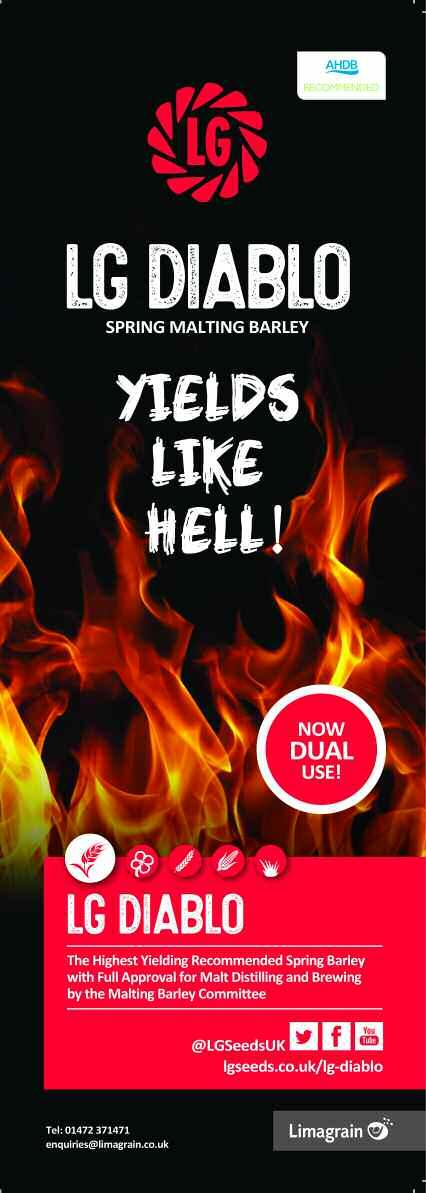
and poultry bedding, consumer briquettes, miscanthus logs and firelighter ranges, and current development into future markets include construction, biofuels, composite materials, medical/cosmetic applications, land remediation, and as a bioherbicide replacement for glyphosate.
“The national annual crop is around 50,000t and there’s an opportunity for this to expand a hundredfold by 2030. This is due to the rapidly growing demand for heat from biomass and potential future markets,” adds Alex.
The firm is also progressing a standardised approach to measuring and auditing miscanthus carbon storage, enabling farmers to be rewarded for thecarbon sequestration delivered by the crop.
“One of the areas worth considering on the farm are grass strips on the headlands,” adds Sarah. “Managed properly these can provide carbon stores, but equally a lack of care in management can promote the release of carbon. Another area of interest is hedges –– though their age and management make a big difference to the carbon they can sequester or store.”
But one thing’s for sure, farmers are in a unique position within the food supply chain to take action to sequester carbon on their farms, she says. ■
The arable sector’s 2020 Climate Change Champions presented the progress and problems on their journey to Net Zero at a round table event,hosted by NFU and attended by Defra minister Victoria Prentis. CPM summarises the discussion.
By Tom Allen-StevensNow is the time for UK arable farmers to step forward with potential solutions for climate change.
The sector is uniquely placed to deliver the practices required to help farming meet its ambitious target of Net Zero emissions by 2040, according to attendees of a high-level round-table event, organised by CPM and hosted by NFU. A collaborative approach is key to success, involving the whole supply chain and led by those in the arable sector with a mindset for positive change. Farmers and industry have also called on Government for clear policy objectives, a united method of monitoring and measuring greenhouse gas (GHG) emissions, and an approach to regulation that favours the circular economy.
“This is our time,” declared NFU president Minette Batters who attended and introduced the event. “But it is only our time if we make it our time. We now have to work together to make it happen.”

The Agriculture Act presents a “landmark moment” that will set the path for a new future, she said. With 85% of people wanting to see growers producing more food here, and with the UK hosting the COP26 United Nations climate change discussions in 2021, Minette believes there’s a “global opportunity” for thought-leaders in UK farming to be part of the solution.

“This is such an opportunity for the UK to lead, but it does mean mindset change at scale and not just across the farming community –– it’s got to go across consumers too.”
Also attending the event was Defra farming minister Victoria Prentis. She said the NFU target of Net Zero by 2040 is “ambitious, but as these farmers here today have demonstrated, it is possible. It’s really, really great to see leaders in climate change within the agricultural world.”

The minister was referring to eight Climate Change Champions who were leading the discussion and who stepped forward with their ideas over a year ago, which have been profiled in CPM throughout 2020. In all, the event drew together over 40 key influencers in the arable sector who can
drive the ambition for Net Zero.
So how can farmers achieve this goal? “Everything must dovetail together,” said Al Brooks, estate director of Faccombe Estate near Andover, Hants, and the farmer voted by CPM readers as Climate Change Champion 2020.
“We have a desire to build a sustainable community. It’s not just an arable farming approach, but a whole edge-to-edge asset approach. We try to add value wherever we can from both a financial and environmental perspective.”
Hamish Campbell, farming in the Cotswolds, achieves his targets through working with local markets and AD plants, putting back what he takes out –– what he calls “just doing the basics”. But he agreed there’s a “massive opportunity” to do more:
Minette Batters believes there’s an opportunity for the UK to lead on climate change,but it requires mindset change at scale.
Big corporate companies should be working with us to offset carbon,pushed by a government that sees farmers as the solution,not the problem. ”
Net Zero will happen as a result of a strategic change to David Miller’s farming system,in which he focuses on big-picture issues such as N use and organic matter.
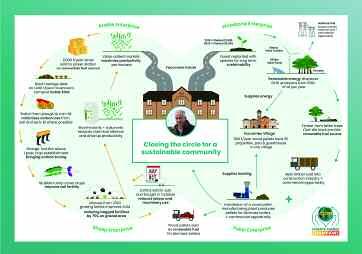
“Big corporate companies should be working with us to offset carbon, pushed by a government that sees farmers as the solution, not the problem.”

Not every farmer can achieve Net Zero through pushing productivity, noted John Hawkins. He’s put his whole farm in the rolling Dorset countryside near Blandford Forum into mid-tier stewardship which he estimates will “lock in” up to 10,000t of CO2 over 10 years. “Some farmers will grow food really intensively, while others on the less quality land will probably help offset that,” he suggested.
Net zero isn’t a “singular ambition” for David Miller of Wheatsheaf Farming near Basingstoke, Hants. “It will happen in conjunction with and as a result of a strategic change to our farming system.”
David uses cover, catch and companion crops in conjunction with a zero-tillage approach to establishing crops. Integrated Pest Management is a “cornerstone” of the system that has helped reduce CO2 emissions by 65% over 10 years. He called it “a responsible way to produce high quality food, while the environment gains by having more biodiversity with a better natural balance”.
Andrew Pitts, farming at Mears Ashby in Northants is convinced UK farmers can build the “resilience and balance” needed to reach carbon neutral well before 2040. He called on the minister to “give us the help we need working together”, spelling out the need to retain glyphosate and to classify “perfectly safe” composted materials as a fertiliser, not a waste product.
“We need to be allowed to use science because science, such as gene-editing, will help us solve many problems,” he added.

Cambs grower Tom Pearson brought with him three examples of his experiences in the journey towards Net Zero. “The first one is a change in mindset. The second is committing to a regenerative agriculture system. The third example is current technology –– game-changing ag-tech and farmer groups,” he said.
He uses the Farm Carbon ▲
Al Brooks was voted Climate Change Champion 2020 by CPM readers and advocates a whole edge-to-edge asset approach to building a sustainable community followed at Faccombe.Best use of organic manure steers the circular economy for Charlie Steer,one of many attendees who called for a for an internationally recognised standard for carbon budgeting.
Toolkit to measure progress gained through a steady transition to no-till, maximising green cover and widening rotations. Tom looks forward to the day in the “not-too-distant future” when “herbicide-free robotic weeding” does away with current control measures for blackgrass.
Clive Pullin, near Stowe in Bucks, runs a mixed farm producing “a lot of food” –– milk, sheep as well as cereals. “My goal is to be part of this carbon challenge –– keep the carbon in the ground and not import it wherever possible,” he noted.
This is achieved through each enterprise feeding the other, with new tractor technology, zero tillage and precision farming used to best effect. “We are able now to put the nutrients where the crops want it, and I’ve managed to reduce my oil-based fertiliser from 550t/yr to 115t/yr.”
Similarly, Charlie Steer of Grosvenor Farms in West Cheshire focuses on the circular economy, milking over 2500 cows and farming 2300ha. Best use of organic manure, food waste, rotational diversity and precision farming underpin production.
“Yield has to remain paramount on our most productive land and in the dairy unit to minimise both carbon and financial cost per unit of output. So our carbon cost per kg of milk produced has reduced from 1.22kg to 0.86kg for 2020, equivalent to a reduction of over 11,000t/yr.” A keen advocate of the 4 per 1000 initiative, whereby every farmer aims to raise soil organic matter by 0.4% per
year, Charlie’s seen those at Grosvenor Farms lift by 0.53% in just three years.
He uses the Agrecalc tool, developed by SRUC to monitor this, and raised the need for an internationally recognised standard for carbon budgeting on farms. Minette indicated this was a priority area for NFU but cautioned that experience with reducing antibiotic usage in livestock showed carbon calculators shouldn’t become “competitive”.

“Carbon budgeting has got to be globally recognised,” she said. “The worst thing we can do is to tie our farmers hands with recognition of what is needed and then we import and undermine underneath.”
Emma Ralph of Interagro noted that not all carbon tools run to the same criteria, calling for a more “joined-up”, transparent solution.
“It takes a collaborative approach across all industries,” she pointed out.
Al added that “payment by results means tangible results that are measurable, transparent and trusted. Carbon calculators must be on the same page in terms of a level playing field in the results they give. Whatever we do needs to stand up to scrutiny.”
NFU combinable crops board chairman Matt Culley noted that the storage of carbon that’s then released isn’t accounted for in carbon sequestration. This point was picked up by Mike Green of BASF –– the food carbon produced isn’t credited as a positive for farming, he said.


“When it leaves the farm, that carbon in the grain or meat or milk is counted as a negative because it doesn’t remain. But if you think
The quest is on to find the Climate Change Champions of 2021 –– those arable farmers who have already made palpable progress towards Net Zero. We believe those individuals currently have their eyes set on this very page. All you have to do is step forward and nominate yourself.
Throughout 2021, we’ll be profiling in CPM a shortlist of candidates,selected from those nominees by a judging panel.The campaign is supported by NFU, and supports its goal of achieving Net Zero by 2040.Specifically,we’re looking for arable farmers with:
● Inspirational ideas more than anything, this is the opportunity for those with innovative practices or novel thinking to come forward and show how these help the journey towards Net Zero.
● Productivity push those using a wide variety of techniques to enhance productivity and deliver the same output or more,and those working smarter to use fewer inputs.
about all your inputs that have been put on to grow the crops, they’re sequestering CO2 all the time.” See article on p32 for more.
Accounting for carbon all the way through the chain would point out the “real low-lying fruits”, such as minimising waste in households, added George Fisher of CF Fertilisers. Different carbon models are a factor of working within an unrestricted market place, he added. “That’s what free markets do, but we must ensure that they all align with the highest standard.”
David pointed out the industry shouldn’t get “bogged down” with understanding the finer detail of its carbon footprint before it’s looked at the “big picture stuff”. “At the moment we’re looking at the big carbon issues –– nitrogen-based fertilisers, and on the positive side organic matter,” he said.
The focus of the discussion turned to the carbon footprint of machinery used to carry out field operations. Matt noted that most carbon calculators just look at diesel usage.
● Cultivation care those using measures to build soil organic matter and lock carbon into the land,which may involve cultivation practice, a change in rotation or alternative land use.

● Bio-based boldness farmers who have implemented measures or activities that positively displace the use of fossil fuel or other causes of greenhouse gas (GHG) emissions elsewhere in society.Examples include anaerobic digesters, solar and wind and alternative uses for agricultural products that lock up carbon.
To find out more,and to nominate yourself for Climate Change Champions 2021,go to www.cpm-magazine.co.uk/climatechange champions. Nominations close 31 Jan 2021.
Andrew Pitts asked that the Government retains glyphosate,regulates organic additions better and follows the science. Matt Culley noted that the storage of carbon that’s then released off farm isn’t accounted for in carbon sequestration.“Is that acceptable? Or are we going to need things like telematics to give us the actual correct data so it can be audited properly and accurately?” he asked.
Yuri Dantilio of BKT tyres pointed out the contribution these make to carbon costs. “Essentially using the tyres increases efficiency and also makes it last longer. And it also performs better in terms of traction and fuel consumption.” Specialist tyres developed for high road usage help here, while very high flexion technology is designed to reduce compaction and avoid soil damage, he added.
Ben Scott Robinson of Small Robot Company suggested it’s the machines themselves that cause the problem. “Unless we can lighten the load on the field by removing a lot of the weight from the machinery, then we’ll just be applying Band Aids to the problems around having 10s of tonnes of kit creating compaction that we have to resolve in other ways.”
The real problem lies in covering large areas of ground in tricky weather windows, said Martin Hamer of Fendt. “Looking at tyre technology and inflation pressures can spread the load. We see more and more farmers opting for direct drilling, so you don’t need such a big
tractor trafficking your fields.”
Sean Groom of Pöttinger added the construction of machinery has a role to play. “There is the use of alternative forms of plastic that can replace some steel materials. There’s also cast aluminium components, particularly when it comes to things like coulter arms that can reduce the overall weight of a product.”
So when it comes to sequestering carbon, how should farmers be paid, and could the private sector help? “The key in this is to get that carbon account, of carbon captured in arable crops on the farm,” said Matt.
“The way forward may be linking up with supply chains and essentially sharing the information on carbon storage right throughout the supply chain.”
While you can buy carbon credits through the internet for around £3/t, Mike noted farmers should be duty bound to reduce their own emissions before seeking to be rewarded for offsetting others. “Perhaps there should be two types of carbon credits –– stocks of permanently sequestered carbon and the carbon flow, done on a more field-by-field basis. If someone says they’ve sequestered 5000t of carbon, whoever buys that needs to know it’s still there.”
Matt confirmed that identifying the perfect
carbon-accounting system is a key priority for NFU’s Net Zero campaign, while benchmarking will then help farmers take the policy forward. E10 –– statutory inclusion of at least 10% of biofuels for all road users –– is another key lobbying point, along with ensuring the clean air strategy results in practical outcomes and best use is made of IPM.

“On livestock, new intensive units could be planned within larger arable areas that don’t have much livestock within them at the moment. Greater collaboration between livestock and arable has the potential to reduce our carbon footprint,” concluded Matt. ■
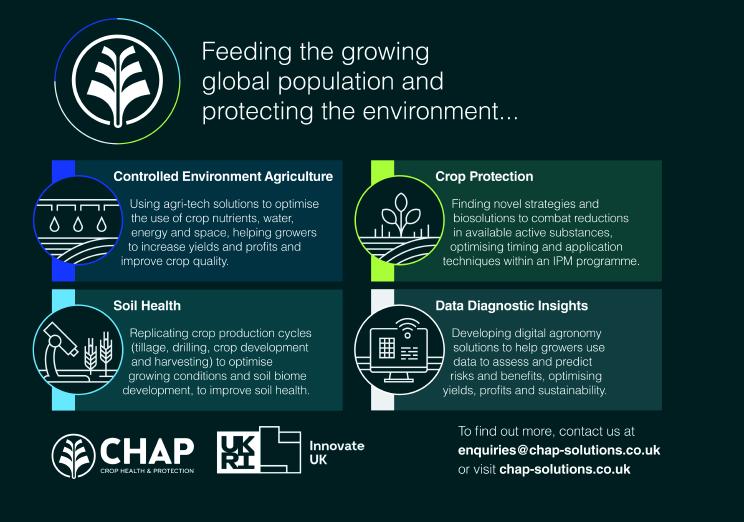 Emma Ralph sees a more joined-up,transparent and collaborative approach across all industries as the best way forward.
Emma Ralph sees a more joined-up,transparent and collaborative approach across all industries as the best way forward.
Farming captures vast amounts of carbon every year in the crops,grassland and livestock that produce the world’s food,but their contribution to net emissions are entirely ignored. CPM explores how to farm carbon.
By Tom Allen-StevensImagine if we mined food from depleting resources,in the same way as we source raw materials for our manufactured goods and much of our energy requirements. The world would turn to dust in no time at all.
So thank goodness that food is a basic resource that comes from truly renewable material –– perhaps the only one that does. But why is the industry responsible for its production –– farming –– treated as though it isn’t?
There’s now a growing body of opinion that questions the very basis on which agriculture’s carbon cost has been calculated. The assumption, laid down by the Intergovernmental Panel on Climate Change (IPCC), is that the net flux from agriculture is estimated to be approximately balanced. So carbon sequestered during food production is assumed to be released during the same year when the food is
consumed and through residue breakdown.
“But this totally ignores the role of photosynthesis and the farmer’s skill in maximising the efficiency of their crops in using it to capture carbon,” notes Mike Green, BASF UK and Ireland agriculture sustainability manager.
“A better approach is to look at the TotalPlantCarbon sequestered in the crop by the grain, stem and root together. The farmer’s aim may be to maximise the carbon stored by the crop using the most efficient approach. The crop is then massively carbon positive as it sits in the field. The other side of the equation is how it’s then harvested, the TotalPlantCarbon partitioned, and the carbon release of the components accounted for.”
Getting the optimum balance is what BASF calls ClimateEfficiencyMax, and Mike believes this is a far fairer way for growers to strive for a better carbon balance on their farm and one that would ultimately drive the most sustainable form of crop production across the rotation.
The numbers are quite compelling, according to Per Frankelius, associate professor at Linköping University, Sweden. “It’s strange that agriculture is so often accused for its negative climate effect, but doesn’t at the same time get praise for its positive carbon-binding and oxygen production,” he notes in a paper published in Agronomy Journal earlier this year.
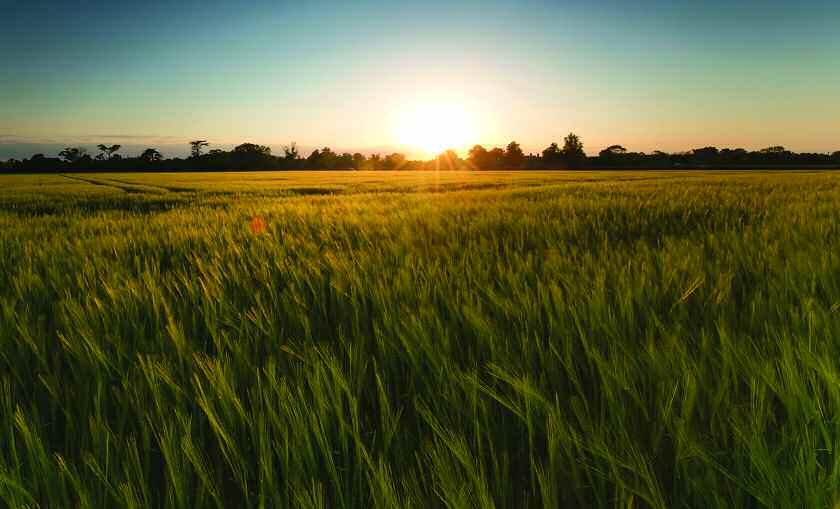
According to the IPCC, around 23% of total anthropogenic greenhouse gas emissions (those resulting from human activity) derive from agriculture, forestry and other land use. Agriculture makes up about half of this and global models estimate net emissions of 6.2 Gt CO2e/yr (gigatonnes, or billions of t of CO2 equivalence).
But Per’s new preliminary calculations put the total amount captured in growing crops and grassland –– excluded in the global models adopted by IPCC –– at 39.5 Gt CO2/yr. This includes an estimated 2.75 Gt of organic carbon left in the field in the form of residues and roots – equivalent to around 10 Gt CO2
“Consider a world in which we take all agricultural land away –– the climate would quickly hit a catastrophic crisis,” he notes. “What’s more, as well as sequestering carbon, these crops are responsible for generating huge amounts of oxygen, which is good for the climate.”
The argument for not taking harvested products into account as a positive contribution is that the bound C in food will generate CO2 when it’s consumed. “But that occurs outside the agricultural sector, and at later points in time,” Per points out.
There’s a scientific imperative to recognise this contribution, even if it is temporary, he argues. “Agriculture is already partly a Net Zero hero, but we can do more to boost its climate contribution –– we can enhance our environmental assets, through innovation”, he says.
Agriculture is so often accused for its negative climate effect, but doesn’t get praise for its positive carbon-binding.
“ ”
ComponentBiomass/ CO2e (t/ha) product (t/ha)

Output
Grain 10 15
Straw 5 6.5 Roots 1.1 1.4 Total 16.1 22.9
Input
Seed 0.15 0.23 Fertiliser 0.84 2.0 Sprays 0.005 0.09 Fuel 0.1 0.34
Machinery - 0.2
Cultivations - 0.9
Total 1.1 3.76
Net sequestered carbon 19.14 Climate efficiency of grain*1.19
Source:BASF (outputs); Farm Carbon Calculator (inputs). *net sequestered carbon per tonne of biomass.
Time since last tillage has a direct effect on soil organic carbon (SOC) status, while it takes around 20-30 years of no-till for a soil to reach its carbon saturation level. These are two major findings of a study carried out in southwest England with the Tamar Valley Organic Group of growers,funded by Westcountry Rivers Trust.
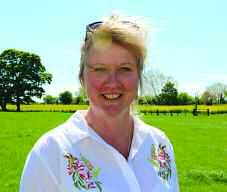
“The growers wanted to know if their soil carbon had a value,while flooding and water quality have been big issues in the area,” explains Soil Health Expert Prof Jenni Dungait.
The study investigated how SOC relates to
A healthy carbon-rich soil is dynamic,so good management is about invigorating the soil community and encouraging the carbon cycle.
Agriculture is unique in that it is the only industry that acts as both a source and a sink for greenhouse gas emissions.
“But as a result of the IPCC paradigm Europe has mostly focused on methods of reducing emissions, while there are excellent
land use across the 15 farms with samples compared all taken from similar clay-rich soils. Four different land uses were looked at and the farmers asked to supply field histor y
“SOC varied significantly with land use and time since last tillage –– it’s rare to get such a consistent relationship,”notes Jenni.“Woodland at 5.0% SOC was roughly the same as permanent pasture (4.3%).Then grass ley/arable rotation (3.2%) was similar to arable (2.7%).”
A soil slake test,developed by Dr Sarah Collier who works with US growers,was used as an easy method to quickly assess soil behaviour, and results correlated closely with SOC.
“Management practice does influence SOC and growers can build it,”concludes Jenni.She has some key tips for carbon enrichment:
1. Maintain a green cover.Soils don’t like to be bare, so try to keep a root growing through them throughout the year –– cover and catch crops help here.These will also add to SOC,as will additions such as farmyard manure.
2. Address compaction issues.These can make a massive difference to net emissions. Use a spade to make regular inspections and address problem areas with appropriate cultivation –– roots can’t do this on their own.Aim to lift compacted layers,putting in vertical fissures.Then,look after the structure –– don’t smash it up or traffic soils in the wet.
ways to enhance photosynthesis, such as genetic advances, with the potential to improve plant biomass and therefore both

3. Keep the surface alive.A thick mat of straw will bury the microbes,so even just a light pass with a straw rake can help crop residue mix with the soil.This gets the carbon cycle going.
4. Consider multi-canopy cropping Agroforestry is a good way to capture carbon into your soil while retaining the land for food production.Tree roots benefit from active management,as well as the canopy –– if encouraged to go deep they won’t interfere with the crop and can help maintain soil moisture.
“It’s worth noting that a healthy carbon-rich soil is dynamic,so good management is not about locking up carbon,but invigorating the soil community and encouraging the carbon cycle,” adds Jenni.
Jenni Dungait found that soil organic carbon varies significantly with land use and time since last tillage.carbon binding and oxygen production.”
Per is concerned that agricultural productivity advances are perceived as mostly negative as a result of the IPCC’s failure to recognise the true value of photosynthesis, suggesting a connection between that perspective and EU policy-making. “If this is the case, there will be fewer incentives to support productivity –– the EU’s Farm to Fork and biodiversity strategies are examples of policy pulling partly against productivity.”
A recent analysis by the US Economic Research Service, for example, has found these policies would result in EU production falling by 7-12%, reducing worldwide societal welfare by $96 billion to $1.1 trillion, depending on how widely other countries adopt the strategies.
“If the EU and others really want to meet multiple challenges successfully there is only one pathway: radical innovation,” states Per. “In the US, agriculture is embraced as the country’s most important industry. Agtech innovation takes centre stage and Silicon Valley has contributed in creating amazing technology for the American farmer
“But in the EU, agriculture has become
considered as a climate villain, and that can lead to new regulations that inhibit production levels and profitability of farming, and these in turn can be very damaging from a broad sustainability point of view.”
Quite where climate policy in relation to agriculture will go in the UK is still unclear. Raising productivity is one of the three core pillars behind NFU’s policy ambition for UK farmers to reach Net Zero emissions by 2040 and could deliver around a quarter of net savings.
But NFU combinable crops board chairman Matt Culley is concerned policy-makers at the very highest level can’t think further than planting trees as the sole solution for climate change. “NFU supports tree-planting in areas identified as having low productive capacity. But I’m really keen to see a whole carbon supply chain develop, that recognises all of the carbon captured by crops and where it then goes,” he says.

“Farmers have no control over how the captured carbon is released, but can do so much to enhance the efficiency of how they sequester it. Meanwhile, I’m convinced if this carbon is given a value, the supply chain will rise to the challenge of bringing it to the end user in the most efficient way, while the carbon efficiency of imports will get proper scrutiny. It’s up to negotiation as to how this carbon value is shared, and how much it’s actually worth, but it would be a real and compelling incentive for growers to focus on their carbon footprint.”
So how would this work on farm? It’s an area BASF has been developing, working with other partners in the supply chain, Mike explains. “If you take a crop in a field as the unit, pre-drilling you have a negative carbon balance, embedded in the input CO2e ‘debt’ of the products you have sitting in your shed –– seed, fuel, crop protection, fertiliser.
“Once the crop is growing, you start to reduce this debt as your solar panel
crop sequesters more CO2e into TotalPlantCarbon, although you must also debit input CO2e of fuel and machinery and your establishment technique.”
Just before harvest, you assess TotalPlantCarbonMax for that year (see worked example on p33), that takes account of the total biomass you have accumulated. “But of course, we harvest the crop, partitioning off the grain and straw components, leaving behind the roots and stubble.”
The grain isn’t stored on farm forever, though, so you would lose that element of the TotalPlantCarbon when you sell it. “But the Input CO2e debt apportioned to the grain should go with it. That leaves up to 34% of the carbon remaining on the farm, depending on what you do with the straw. Once you’ve factored in the remaining input CO2e, that means a considerable net amount has potentially been sequestered.”
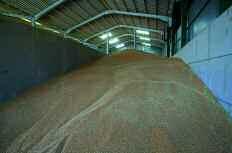
Mike argues that calculating net emissions in this way, using TotalPlantCarbon, allows greater leeway for growers to aim for ClimateEfficiencyMax –– the maximum net sequestered carbon per t of produce. This could then become a tradeable premium
Leaving the land in a better state than we found it unites progressive arable farmers and policy makers in a common aim. But it’s not so easy to put into practice, treading the delicate balance between bounty drawn from the land,an innate care for Nature’s needs and the moving sands of societal demands.
CPM is working with some of the industry’s leading companies to sort the soil sense from the climate guff.These articles bring the inside track on policy as it evolves,delve into the opportunity and pinpoint the potential for long term sustainable gain.
BASF knows that for farmers,preserving the land is common sense:for their businesses,for their communities and for the next generation.They can rely on the support of BASF with innovative products and agricultural solutions that also reach far beyond standard crop protection.

commodity, like grain protein and oil content. “Those growers particularly proficient at using their solar panel crop to sequester carbon will become sought after by end users as the grain will carry with it a proportionately higher carbon credit.”
In terms of the carbon residue left on farm, crop roots and incorporated straw can be captured into soil organic matter, although Mike notes that maybe 50% will naturally break down and be lost to CO2 during the year.


None of this carbon is currently accounted for in any of the carbon-accounting tools available, explains Becky Willson of Farm Carbon Calculator. “The IPCC currently takes the carbon captured by the crop as transient, so it’s accruing in the system no faster than it’s being released.
“However, the nitrous oxide (NO2) emissions lost from crop residues during breakdown are accounted for as a significant CO2e loss, even though the carbon captured isn’t credited while the crop’s growing.”
The rate at which these emissions are released is dependent on cultivation, fertiliser practice, soil type and conditions, with CO2e emissions from plough-based systems being the highest (see panel on p33). “The way tools account for these losses are being refined as we learn more about the management practices that can be used to
mitigate them,” she adds.
On the crop input side, growers are penalised for emissions, although this doesn’t fully account for efficiency of use. “Fertiliser makes up 50-60% of total emissions for an average arable farm, but growers don’t see the carbon benefit. You can measure your emissions intensity ––total emissions per tonne of produce –– but this doesn’t fully reflect carbon captured during crop growth.”
Becky notes that aspects such as fertiliser timing can have a massive influence on biomass growth and therefore carbon sequestered, but this won’t be reflected in a farm’s net emissions. “Use of crop protection products is potentially an even greater anomaly –– they make up less than 1% of overall emissions, yet a good fungicide, for example, can improve plant health and therefore the carbon efficiency of a crop.”
So should the carbon captured in crops make a contribution to a farm’s net emissions balance? “It’s not too difficult to put figures on it, and there’s certainly potential to then use those figures to improve the carbon efficiency of a crop production system,” she says.
“Care would have to be taken with how the figures are used –– sequestered carbon
Per Frankelius is concerned that agricultural productivity advances are perceived as mostly negative which affects EU policy-making.
only makes a difference to climate change if it is permanently captured, while a crop will take carbon out of the atmosphere for no more than two years before it’s released again.
“That said, the carbon captured by trees may be significant, but doesn’t take account of what happens once a woodland planting reaches maturity, which can be in as little as 20-30 years. So it seems a little unfair to give all the credit to trees –– in the right place and right situation they are a useful tool, but they are not the only option.” ■
There’s an old proverb that says,‘one man’s tonic is another man’s poison’. The same is true when it comes to farming systems –– what’s right for one farm may be totally wrong for another and this can make interpreting the results of formal research in a way that’s meaningful at farm level difficult at best.
Consequently, more and more farmers are using on-farm trials to find answers to some of the more pressing problems they face, says AHDB’s Emily Pope.
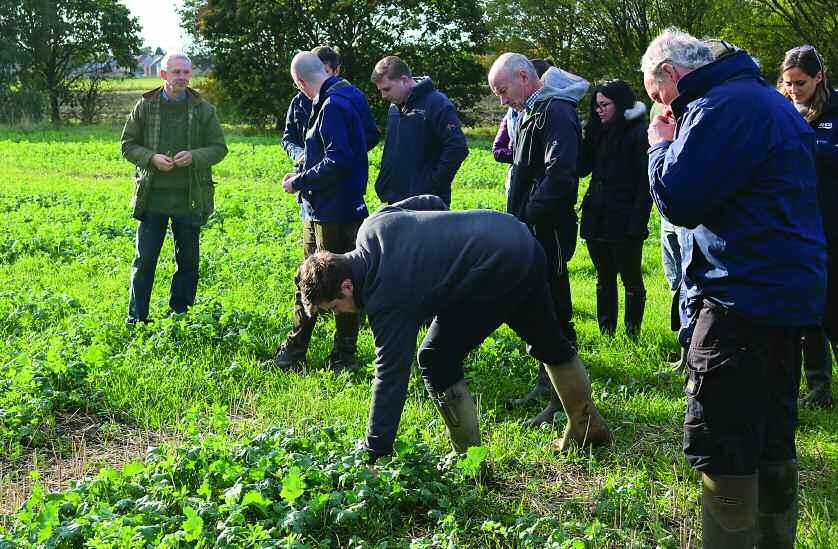
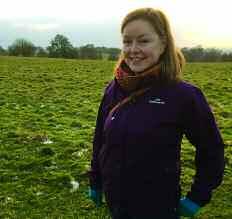
Farmers and she speaks very passionately about the value of farmer-centric R&D. The seeds for the Innovative Farmers programme were sown in the past and build on the concept of a much earlier project, established in 1989 by the UN Food and Agriculture Organisation.
This brought farmers together in ‘farmer field schools’, she explains. “The first one started in Indonesia where farmers were very geographically isolated and restricted by education. The aim was to look at reducing pesticide use in rice by encouraging natural enemies. The concept
A failure of traditional research is that it can be difficult to translate into farming practice.
Increasingly farmers are taking research into their own hands and the Innovative Farmers programme is helping them do this. CPM takes a closer look.
By Lucy de la Pasture
“Our network of Monitor Farms delivers a farmer-led agenda and opportunities to address issues on the farm and the Strategic Farms help to deliver research into practice. The Innovative farmers programmes offers something unique which really complements the exiting AHDB network of farms cross different sectors,” says Emily.
“This is why AHDB partner with Innovative Farmers and have field labs that are coordinated by AHDB Knowledge Exchange teams, involving both Monitor Farms and Strategic Farms. Some of our own research activity also involves Innovative Farmers. This partnership brings the research and KE landscape together by working collaboratively.”
The Soil Association’s Dr Kate Pressland is programme manager for Innovative
Kate Pressland says that having the researcher on the farm can queue-jump knowledge blockages and is much more relatable than reading research papers.There’s such an experimental spirit in farming.
“ ”
was that if you bring farmers together to experiment and to share their knowledge, then the gains for everyone would be great.
“UK farmers aren’t restricted in the same way, but they are restricted by time and it could be argued that they’re restricted in the sense that there’s so much information, where do you begin? We have an excellent but highly fragmented knowledge exchange system in the UK, and it takes time to find the information which may be relevant to your farm. Then you’re on your own when deciding how to implement it.”
In 2012 the farmer field schools idea was developed by the Soil Association (with Organic Research Centre) and field labs were born, funded by the Prince of Wales’s Charitable Fund (PWCF) as part of its
mission to help farmers become more sustainable and resilient. The funding gave both organic and conventional farmers a platform to test something on farm that they may have otherwise been unable to do.
“Farmers are all doing experiments all the time – testing things, dabbling with varieties or breeds and learning –– as well as doing what they’ve always done, they’re always tweaking. There’s such an experimental spirit in farming –– even working out when to harvest a crop is an experiment in itself.”
This means that the sharing of information between farmers is a very powerful way of expanding knowledge, believes Kate “It’s about pushing through barriers to innovation and bringing farmers together to share what they know and ideas that they have. By bringing a researcher into the mix, we’re addressing the gap where farmers want to try something but had no way of doing it in a coordinated way with a bit of support.”
The idea for field labs came from a UN initiative where farmers are brought together to share ideas and learning in Farmer Field Schools (pictured in Bangladesh). Photo FAO/Karina Coates

Establishing the programme hasn’t been without its challenges, says Kate, and to begin with the learning curve was a steep one. “We were so familiar with the concept of a demonstration farm or a scientific research project that it took a little while to work out how field labs were going to function best –– if the experiments are less rigorous, less controlled than in a research project, then what value will they have?

The introduction of cover crops and bringing livestock back into arable enterprises are two known measures farmers can take to improve soil health on the farm.Putting the two together could be a way for farmers to eke out a more immediate financial return after planting a cover crop,says ADAS research scientist Dr Kate Smith,who is leading an AHDB-funded field lab.
Earlier this summer she got together with a group of farmers via Zoom to discuss the questions that they’d like to find the answers to.They decided to investigate whether grazing sheep can aid cover crop destruction,as well as look at their impact on soil properties and the following crop.
“One of the concerns farmers have is the cost of planting cover crops, where a return on their investment isn’t immediately apparent.Grazing sheep is an area the group are keen to explore and establish what the benefits actually are,” she explains.
By grazing sheep there’s a potential to reduce feed costs and increase margins in the sheep enterprise.There are also possible soil benefits with added organic matter return and a potential
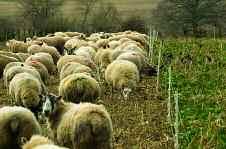
benefit to the following crop from the sheep manure,which contains nitrogen in a form that’s more available,explains Kate.
“Finally there’s the possibility that by grazing cover crops,farmers will be less reliant on glyphosate to destroy them,though from discussions in the group it appears glyphosate will still be required,”she adds.
The field lab has three sites which embrace different climatic conditions and soil types,with predominantly sandy and peat soils.The ‘hub’ is in Norfolk and this will be where ADAS make detailed assessments of the soil and cover crop.It’s backed up by two satellite sites,one in Staffordshire and another in Cambridgeshire, where farmers will make their own assessments.
“Tramline trials have been set up in the cover crops by farmers,with support from ADAS to make sure the design returns the best data from each site.The field labs will look at over-wintered stubble,a cover crop and a cover crop grazed with sheep at each site and assess the impacts on soil structure and the following crop.
“At the hub site we’ll analyse cover crop
“It turns out that the field labs bring a lot of value. If you’re going to be basing your business decisions on dabbling rather than research outcomes, then necessarily by experimenting with a group of others you’re getting better data and testing each other’s assumptions.”
Kate concedes that the data is ‘noisier’ because the experiments take place on different farms, but argues that there’s actually some real robustness to it. “The discussion which occurs when working out the reasons behind any vagaries between results really embeds the learning from the process,” she comments.
Kate believes another huge plus is the
sheep.
biomass, nitrogen content and its ME. After grazing we’ll look at the soil properties and the farmers will keep a trial diary to record any poaching, run-off or erosion that may occur. Where possible they will also collect information on the livestock,such as liveweight gains and body condition,” says Kate.
Using all this data ADAS will ultimately prepare a cost benefit analysis for using sheep to graze cover crops which will help some on the unanswered questions the group have about integrating sheep and cover crops on their farms, she explains.
A new AHDB-sponsored field lab is looking at the potential advantages from grazing cover crops withacademia. But what researchers really want to do is make a difference. They wanted the institutes to give them the thumbs up to be able to go and work with farmers. There aren’t huge funds available to pay researchers or farmers, this works as mutually beneficial relationships,” says Kate.
The Innovative Farmers field labs bring a different dimension to the existing AHDB network of Monitor and Strategic farms.
large amount of knowledge gained when trialling something on your own farm, which she says far outweighs seeing something written in a research paper that may have been based on a plot study or glasshouse experiment.
“Working in a way where the research was less controlled meant it took quite a while for researchers to work out what they could best bring to the process. But many saw this was either an opportunity to start to shine a light on something interesting which could be developed into a more sophisticated research project, or they found great satisfaction in being able to transfer their knowledge in plain English, in really useful terms, around the kitchen table and for the farmers to immediately absorb it.
“But we’ve pushed past the barrier of field labs not being seen as relevant as classical research because of their real value, evidenced by the fact that they have been responsible for changes in management on farm. Farmers ‘dabbling’ experiments are being elevated, and their research skills and inferences are improving.”
Even so, there were still challenges in getting the support of the research institutes, says Kate. “They couldn’t easily see the value of being involved –– the system means research papers are the cash flow for
“Since 2012 many more institutes recognise the value of science communication and the field labs provide a pathway for this, with future research projects based on ground-truthed priorities and pilot data. This is compelling proof of impact for funders of academic research.”
Then BBSRC, which is the predominant funder of agricultural research in the UK, became supportive of the programme, she explains. “They saw this positive feedback of value from researchers getting involved in grassroots work and really understanding the priorities of farmers. As well as sharing their research knowledge, researchers were also gaining knowledge at the field level and BBSRC wanted to see this loop back into funding proposals for projects that would have a greater direct impact and value to farmers.”
There are other benefits from direct interaction between researchers and farmers, adds Kate. “With academic research there’s a large time lag before results are available to farmers, which really doesn’t work for them as the horse may have already bolted on a problem they may be tackling. Having the researcher step foot on the farm can queue-jump this knowledge blockage and it’s all done in such a human way that it is much more relatable than research papers.
“A large amount of agricultural research only focuses on the positive results, but equally the null results, which aren’t published, can be of huge value as something not working is important to know.”
AHDB Project No 91580001 ‘Innovative
Many of the field labs are looking at practices which may bring benefits to soil health.
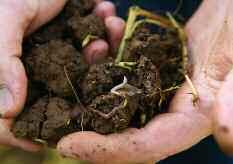
Kate says a lot was learnt from this first phase but there was an appetite to do more by creating a network and in 2015 the programme became Innovative Farmers.
“Topics are farmer-led and the idea of a network is that the more farmers that are trialling something, the greater the insight should be into a subject –– for instance, if six farmers are trialling a technique and it works for four of them but not for the other two, then the learning amplifies as the group tries to understand why this may be the case. ‘Learning by doing’ is very powerful and farmers like learning from each other –– this is why everything Innovative Farmers does is open-source.”
Innovative Farmers is still predominantly funded by the PWCF, but Kate believes farmers should be more valued for doing R&D. She’s advocating grass roots research should be centrally recognised, with farmers supported to carry this out in a way that’s beneficial to them so that it can move beyond the limitations of scale in being charitably funded.
There are encouraging signs that Defra is recognising the positive role farmers can play in shaping research projects capable of generating information which can be usefully applied at a farm level but the scale of funding and how it works for farmers is yet to be published, concludes Kate. ■
An Innovative Farmers field lab has enabled researchers to investigate the effectiveness of mowing off oilseed rape crops on farms in an effort reduce numbers of cabbage stem flea beetle larvae.

Farmers field labs’ runs between April 2019 and March 2022 at a cost to AHDB of £224,190 (cash £177,000,in kind £47,190).Innovative Farmers is predominantly funded by the Prince of Wales’s Charitable Fund (PWCF) £800,000 and other non-AHDB sponsorship (including BBSRC) is £270,000.AHDB funding is split approximately as follows:AHDB Cereals & Oilseed 53%,AHDB Horticulture 19%,AHDB Pork 17% and AHDB Potatoes 11%.
Innovative Farmers is part of the Duchy Future
Farming Programme.It is backed by a team from LEAF,Innovation for Agriculture,the Organic Research Centre and the Soil Association.

To find other field labs,visit innovativefarmers.org/find-a-field-lab and tick ‘AHDB’.
From Theory to Field is part of AHDB’s delivery of knowledge exchange on grower-funded research projects. CPM would like to thank AHDB for its support and in providing privileged access to staff and others involved in helping put these articles together.
Cover and catch crops get a lot of positive commendation, but what real benefits can they bring to the heavy land grower? CPM explores the findings of a major six-year project conducted at Agrii’s Stow Longa Technology Centre in Cambridgeshire.
By Tom Allen-StevensAlmost anyone who’s grown cover crops will have received mixed results and to be fair,that’s par for the course when introducing any new practice into an arable system.

What’s particularly tricky, however, is refining the system, and understanding how to ensure they consistently deliver a benefit –– even working out what a ‘benefit’ from a cover crop is can be a task in itself, notes Agrii trials manager Steve Corbett.
“60-70% of cover cropping on heavy land is almost certainly a waste of money,” he states. “There can be serious confusion over what we’re trying to do with them and a scatter-gun approach to growing them on farm. But there are valuable benefits if you know exactly what you want to achieve and you integrate them carefully into the rotation.”
Steve and his colleague, David Felce, have been sifting through six years of data,
accumulated across 618 plots in detailed cover and catch cropping trials drilled, assessed and harvested at Agrii’s Stow Longa Technology Centre in Cambs. For almost 20 years, the site has been at the centre of the company’s R&D into blackgrass and cultivations. Since 2015, a significant strand of this work has focused on cover cropping, and with the results now drawn together, CPM has joined the duo for a detailed discussion.
“We quickly realised early on that biology doesn’t deliver benefits on its own,” notes Steve. “Just as with a cash crop, a cover crop needs the basics of good soil structure and a well drained site. It also helps to know the specific conditions of the site you’re dealing with and then tailor your approach to cover cropping to suit it.”
The predominant soil type at Stow Longa is chalky boulder clay, David points out, with a high blackgrass burden. “It’s similar to situations faced by a lot of growers, but the approach on a Cotswold brash or lighter soil, for example, would be very different. That said, we built our trials into previous work on cultivations, so in all we have around 7-8 years’ worth of data from which to draw conclusions.”
Soil analysis of the trial site itself reveals it’s actually only 10.5% clay, with sand constituting almost half of what’s classified as a sandy silt loam. “What makes it heavy and difficult is the silt content in the 75cm of topsoil overlying the impermeable clay subsoil,” David explains.
Steve accepts that this has presented the
cover crops and cultivation routines they’ve explored with a bit of a challenge. “Time in the ground is a key component for cover crops. This site cools down quick and gets wet relatively early. Good seed-to-soil contact is also vital at establishment, and that’s not easy to achieve on this soil in the summer. So, you’re working with a narrow window in which you’re asking the crops to perform.”
The trials have compared a range of cover and catch crops with three cultivation-only routines, based on ploughing, deep cultivation and direct drilling preceded with a straw rake (see panel on p40). A Lemken Karat combination was used to establish the cover and catch crops, while a Sky EasyDrill was the direct drill chosen for the following cash crops.

Throughout the trial, assessments were made of the soil and blackgrass levels along with the financial results. “We frequently found the direct drilled area was very easily smeared with surface compaction obvious,” reports Steve. “Also that cover crops can get in the way of controlling high levels of blackgrass –– on their own they don’t help against the issue, which supports all the advice that a range of control approaches are required.”
It’s getting these aspects right, along with establishment, that are essential for those looking to maximise the benefits from cover crops on farm, he notes. “It’s best to focus on a small area to address a particular issue and get it right at first, before introducing them widely across the farm –– there are too many factors that can skew the results and mask the potential benefits.
“The shallow, fibrous roots of phacelia, for example, won’t go into a compacted layer, but wow, they can deliver fantastic friability in the drilling zone. Black oats and vetch can really make a difference, with the oats
There are valuable benefits from cover cropping for those who know exactly what they want to achieve,says Steve Corbett.“ ” ▲
rooting aggressively close to the surface and vetch penetrating further down. Ideally, you’d look to plant a mix of 8-10 species to address a range of issues, but that would be prohibitively expensive.”
Indeed, cover and catch crops are not going to deliver an easy route to a prosperous rotation on heavy land, he suggests. As evidence, Steve presents headline gross margin figures from parallel rotation trials in a neighbouring field at Stow Longa. Here, the plough performed best at an average 2017-2020 margin over all inputs and establishment costs of
Along with getting the establishment right,killing off a cover crop and knowing when the timing’s right are pivotal to success,says Steve.
“When cover crops are breaking down,they can have a negative effect on the next crop,particularly spring barley,”he notes.
To investigate this,a crop of Explorer spring barley was drilled on 30 March this year under the three different tillage regimes in the rotations trials at Stow Longa –– ploughed,deep pass and direct drilled following a cover crop.In each case glyphosate was applied to the cover (or
£631/ha/year, followed by the deep pass system at £602/ha/year with cover crops trailing behind at £529/ha/year
This was equally apparent with just cover crops ahead of the spring cropping in the rotations work, while they also failed to deliver on blackgrass: the plough returned 93 heads/m2 on average, followed by the deep pass at 306 heads/m2, and 332 heads/m2 resulting from using cover crops.
“Cover and catch crops don’t appear to be delivering anything to the bottom line above what we can achieve through direct drilling alone,” notes David.
“That’s in a situation where no-till yield results have only just come up to the same level as those where we’ve cultivated, following six years building the soil structure.”
The experience on chalky boulder clay is similar to situations faced by a lot of growers,David Felce points out,but the approach on lighter soil would be different.
favourably over direct drilling on its own –– it’s a good safe bet to get the all-important friable tilth in that top layer so you don’t leave the seed exposed in an open slot. White mustard proves a cost-effective option, but poses problems in the rotation with other brassica crops. That’s a similar dilemma with using cereals as cover crops.
volunteers/blackgrass) either four days or six weeks prior to drilling.
“The evidence here is compelling –– there was a yield lift from the early application of 0.4t/ha in the ploughed plot, 0.5t/ha for the cover crop and 0.6t/ha in the deep pass leading to gross margin increase of £70/ha. When cover crops get to the point they’re delivering the benefit you’re seeking,that’s the point to take them out –– don’t let them run on. And whatever the cover,it pays to spray it off well before the cash crop is established,”concludes Steve.
With the cover-cropping trials, care has been taken with the trial protocol to ensure blackgrass seed return has been minimised –– the Sky drill has been specifically chosen as a low disturbance option for the cash crop in spring and late autumn, for example, says Steve. “It’s important always to be mindful of what cultivations are required for the cash crop and to carry these out in August ahead of establishing the cover crop. That means drilling is the only operation to follow, whether that’s in late autumn or early spring.”

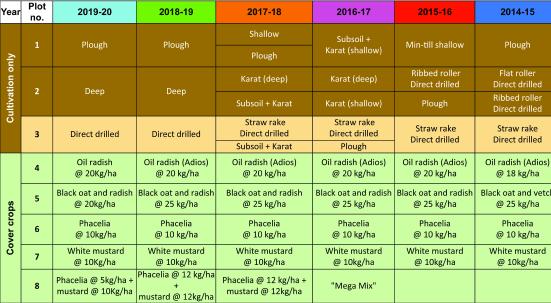
Overall, across the six years of the centre’s detailed cover and catch cropping trials, the plough-based routine averaged best at £620/ha/year with oil radish performing worst at just £389/ha/year –– a reduction of 37% (see chart on p41). So, is this a death sentence for heavy land cover crops? Far from it, he says. “Some interesting differences come through when you drill down through the figures.
“Phacelia can perform
“But while mustard or phacelia perform best, there’s still a net cost from using them averaging around £70-80/ha. So, is this a cost worth paying for sustainability?” Steve asks.
To answer this question, he and David have looked at other factors, such as soil organic matter (SOM). Samples taken in


The shallow,fibrous roots of phacelia can deliver fantastic friability in the drilling zone.
Smearing and compaction can be a problem on soils that cool down quick and get wet relatively early.
Nov 2019 vary across the plots, but the results aren’t necessarily what you’d expect: while phacelia comes out top at 4.4%, closely followed by black oats and vetch (4.3%), oil radish scores low at 3.5%. The plough achieves the site average of 3.9%, while the straw rake/direct-drilled area performs worst at 3.3%.
David emphasises that the results relate solely to this field and its soil type and shouldn’t be inferred as a typical result any farmer would achieve. “We’ve not seen any solid evidence that the plough destroys organic matter. What the headline findings on reduced cultivations often miss are the situations that result in anaerobic soil conditions which can heavily reverse any gains in soil health and send your overall carbon equivalent emissions through the roof. On this soil type, that’s far less likely to happen if you plough.”
SOM is a valuable metric,
however, and he believes it’s most informative when included as one of a range of soil criteria tested. “Only 8% of soil samples currently sent in to Lancrop are tested for SOM. Anyone looking to assess how their management practice can affect their soil should get this test done routinely to provide a benchmark against which to measure progress.”

David and Steve recommend Lancrop’s Solvita test, which includes a biological analysis with the physical scores and nutrient figures. “It combines critical criteria, like pH, P, K and Mg values, with aspects such as C:N ratio and microbial biomass, giving you an overall soil assessment score,” notes David.
And it’s here that some of the differences begin to show, with the cover crops delivering significantly better results than the cultivation-only regimes ––microbial biomass for phacelia is
around 54% higher than for the plough, for example.
The findings have prompted the duo to delve deeper into the soil biology and the Centre for Ecology and Hydrology (CEH) is now working with Agrii in assessing the various microbes found in the soil samples from Stow Longa.
“Altogether, 62,000 different bacteria, 2000 fungi and 4000 eukaryotes (organisms that include the larger and more complex soil microbes) were identified. There were large differences in the soil community found between areas that had been tilled and the cover crop and straw rake plots,” reports Steve.

These have been classed as possibly beneficial and potential pathogens, with cover crops showing an overall positive effect on the soil community while cultivations have resulted in a negative effect (see panel left). “We’ve expanded the scope of the study and CEH is now looking at up to 400 samples drawn from across farms under different cropping, tillage and organic amendment regimes. I think the results will prove interesting,” he adds.
So what conclusions can currently be drawn? “Do cover/catch crops pay at Stow
Longa? No. Can they help with control of blackgrass? Possibly, but that’s certainly not guaranteed. Do they improve soil structure? Yes, if established well, but don’t expect higher yields as a result. Good seed-to-soil contact and early drilling are essential,” says Steve.
“It’s easy to knock holes in cover crops, but equally the findings of this study should be taken in context, and for those focused on what they’re aiming to achieve, there are benefits to be gained. The really interesting one, and a ‘definite maybe’ is the effect on the soil community. There’s a lot more to learn in this area, and as we do, that’s where potentially greater benefits may come to light.” ■
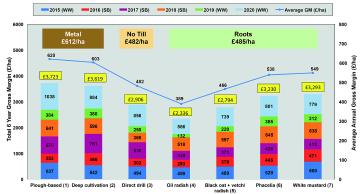
Through the country’s most extensive agronomy research and development network,Agrii is focussed on delivering the extra value growers need in a fast-changing and increasingly challenging crop production world; value which keeps them firmly ahead in a future where overall cropping sustainability is at least as important as individual crop performance.
Following on from the series of articles developed from 2013, the company’s R&D team have provided CPM with exclusive insights into findings from some of today’s most practical crop improvement work.
This includes taking advantage of the best available variety intelligence; tailoring nutrition for winter and spring crops; employing new technologies and approaches to sustainable agronomy; and making the most of modern spring cropping.
We hope you find these insights valuable in helping you optimise your production costs; minimise your risk; take advantage of your best new opportunities; maximise your performance; simplify your management and, above all, secure a more sustainable farming future.
Source:Agrii.Results shown across winter wheat (WW) and spring barley (SB). Stow Longa cover/catch crop trials 2015-2020: gross margins Source: CEH; samples taken in Nov 2019; arrow(s) indicate a comparative population increase/decrease which may be attributable to management practice. Examples of changes in microbes found in soil from Stow Longa Cover crops such as black oats and vetch can deliver a more favourable environment for the soil community.Understanding the many faces of phosphites could hold the key to unlocking their potential. CPM explores their role in agronomy, how they work and how the physical characteristics of phosphite salts can affect outcomes.
By Lucy de la PasturePhosphites are perhaps one of the best known biostimulants and have been used in agriculture for several decades. They’ve charted an interesting agronomic course, where research enthusiasm has flipflopped from nutritional products,to fungicides and finally to biostimulants –– on the way creating lots of controversy still evident today
Science has discovered a lot about phosphites but the knowledge hasn’t necessarily been transferred to the field, according to Dr Nigel Grech, co-founder of Unium Bioscience and a researcher based in the Unites States.

Nigel believes phosphites are a fantastic tool if you know how, when and why to use them. CPM draws on his 30 years of research and his experience using phosphites on his own family farming operation in California.

Phosphites have existed on Earth long before there was even an oxygen rich atmosphere, forming part of the natural terrestrial and marine phosphorus cycle. They are inorganic derivatives of phosphorous acid and a reduced form of phosphate, carrying one less oxygen molecule.
The first interest in using phosphites in agriculture was as early as the 1940s and 1950s where they were investigated as a more soluble form of phosphorus than phosphates, with greater soil mobility. In the 1970s, an organic phosphorous acid derivative (a phosphonate) was discovered to have an indirect effect on a small group of fungal pathogens, primarily oomycetes such as downy mildew and Phytophthoras, so attention switched away from other uses.
The resulting registration of Aliette (fosetyl-aluminium or aluminum tris (ethyl-phosphite) as a patented fungicide caused concerns that fertiliser products could be used in disease
Nigel Grech explains that phosphite research enthusiasm has flipflopped from nutritional products,to fungicides and finally to biostimulants.
management, which side-lined the development of fertiliser and biostimulant products until the patent expiration in the early 1990s. Science has gone on to demonstrate that phosphites are multifunctional and have a very clear biostimulant effect.
The use of a phosphite product depends on its label but it’s true to say that phosphites are definitely a biostimulant, can be a fertiliser and can be a fungicide.
While they can deliver phosphorus to plants, phosphites can’t and shouldn’t be applied to crops at a level comparable with phosphate fertilisers. When dosed and applied correctly, phosphites commonly confer significant agronomic benefit.

Science shows that most soil microbes can metabolise phosphite to phosphate –– a legacy of their primordial existence when there was no oxygen in the atmosphere. It’s also postulated that phosphite can be converted by plants into a form they can use by utilising the many bacteria contained in their rhizosphere as well as inside them.
Research is now very close to showing that these bacteria can mediate the conversion of phosphites to phosphates. Once inside a plant, phosphites are completely systemic and can be easily detected. In trials, phosphites are never permanently in plants and eventually are no longer detectable. It’s intimated that this is because they are converted to phosphate.
In soils the picture is very clear. Collaborative research with California State University is joining the dots and has shown that when soils were surveyed throughout California, 70% of the microbes in soils sampled possessed the phosphite dehydrogenase gene ––indicating most soil microbes retain the ability to convert phosphite to phosphate. Although these pathways may play a relatively minor role in direct phosphorus uptake, phosphites can be used in phosphorus management strategies to improve the nutritional efficiency of plants.
When applied to crops, phosphites induce an upregulation of the phosphorus acquisition metabolism, effectively switching on the plant’s pathways to acquire more of the element. A relatively small amount of phosphite can achieve this (200-300 g/ha), as well as delivering a positive effect on both root architecture and reproductive growth.
Phosphite also upregulates pathways that help plants manage stress. One of the main ones affected is the shikimic acid pathway –– unique to plants and microbes –– which produces molecules to help alleviate abiotic and biotic stresses. This biochemistry is of such importance to plants that they allocate around 20-25% of their photorespiratory energy to this pathway.
The cation the phosphite is bonded to is as critically important to the safety, stability and efficacy of a product as the formulation itself.
Phosphites are very strong reducing agents, meaning they strongly scavenge for oxygen. They can be very damaging to agrochemicals in formulations and tank mixtures as phosphites are very reactive in an unstabilised form.
They have very different properties to phosphates –– being
Fourteen years ago,Richard Smith formed contracting company Danum Farming with a neighbouring farmer and the firm now looks after the combinable crops operations on both farms and two neighbouring estates, covering around 1,820ha in South Yorkshire.The land is ring-fenced, with each farm responsible for its own individual costs but farmed as a whole.
Alongside the combinable crops business,Richard has grown his own 324ha potato enterprise,producing potatoes for McCain which are destined for the fast-food chain McDonalds ––a business which recognised him as their ‘outstanding grower of the year’ in 2019.
“We’ve used phosphites on arable crops for a number of years for general plant health and stress mitigation, particularly in oilseed rape crops,” he says.
But it’s the potato crops where calcium phosphite has a major role to play on his fertile Grade 2 limestone soils.The processing varieties grown can be susceptible to internal browning
and hollow heart which are caused by calcium deficiency
“Although we have calcium in our soils, it readily locks up as calcium phosphate and becomes unavailable to plants.Potato plants move calcium from their roots to the foliage,but it can’t be transported in the other direction, ie from the foliage to the tubers,” he explains.
“If the foliage runs short of calcium,often during periods of rapid haulm growth,then plants take calcium from the tubers if there’s insufficient free calcium ions available in the surrounding soil for root uptake.”
To avoid this scenario,Richard dusts calcium phosphite (formulated as a wettable powder) onto tubers at planting,which provides a source of available calcium in the soil surrounding the tuber.He has found this also brings health benefits,promoting a vibrant healthy root structure,which helps the potato plant access nutrients from the soil.
“When the haulm starts to expand rapidly,we apply 1 l/ha of
smaller and much more soluble. Unlike phosphates they enter the plant rapidly and, like phosphates, they are very mobile within the plant, heading to areas of growth such as the shoot tips, roots and meristems. Phosphite products typically have a high salt index and being highly soluble means there’s a risk of inducing osmotic shock and causing crop damage under certain application scenarios.
This means formulation is important, particular where phosphites are applied as seed treatments, in greenhouses, to early soft tissue growth, applied during hot weather or if there are residues on the leaf from a previous spray that may interact with the phosphite.
One of the main challenges in the formulation of phosphites is that they are highly deliquescent, which means when the solid is exposed to humid air it will liquefy. This is true of all the commonly available phosphite products
In poorly formulated products the lack of stability can be overcome by lowering pH (very acidic) or by using a high level of EDTA,which can destabilise cell wall complexes and has poor biodegradability in the soil.

based on potassium, sodium and ammonium. Although phosphites are available in many forms, the cation partner which produces the lowest salt index and highest stability is calcium, which makes ▲
Unical ST and foliar calcium application produce statistically significant yield responses (p<0.01).
Source: Unium Bioscience, 2020.
calcium phosphite with the blight spray and repeat this ever y fortnight until we’ve applied a total of 3 l/ha. The idea is that the foliar application provides the leaves with a source of calcium during the period where it may run short,preventing the plant from pinching additional calcium from its tubers.It’s not just the calcium that’s of benefit,the phosphite brings other benefits to overall plant health,” he says.
Richard plans a further foliar application of calcium phosphite at mid to late bulking because of its positive
effects on tuber wall integrity,skin set and skin health –– all of which have benefits when putting potatoes into store.
The role of calcium phosphite is of such importance to his enterprise that Richard values the integrity of the product above anything else.“The biostimulants market is essentially unregulated and some products aren’t necessarily what they say they are,so I use a product that’s based on research at the University of California and is well-formulated. Basically,I know what I’m getting.”
● Not all phosphites are the same different cation formulations have different physical properties which can affect tank-mixing and crop safety
● Use a stabilised formulation these may cost slightly more per litre but are used at a lower rate per hectare (50% or less of the dose rate of generics)
ecotoxic effects of some fungicides, such as copper.
Another plus for calcium as a partner is that it’s typically transported in phosphate-rich molecules in the plant, so the pairing is very synergistic as an application. Importantly, calcium phosphite can also be formulated or combined as an end use mix with biocontrol/beneficial bacteria very effectively –– together providing a platform to support biology with soft chemistry.
In the data from independent trials over the past three seasons (2018-2020), the average yield response to Unium’s calcium phosphite in winter wheat has been 0.63 t/ha = £120/ha ROI. This relates to a 91% chance of breakeven or above over 24 trials.
The OSR on the left is showing phosphate deficiency symptoms. The plants on the right received additional foliar calcium phosphite.

calcium phosphite products much safer and more versatile to use.
Using a stable calcium phosphite enables formulations that aren’t possible with more deliquesent phosphites, such as suspension concentrates, wettable powders, water dispersible powders/granules andgranules. On a practical level this means calcium phosphite can be integrated with other agrochemicals in formulations or in a spray tank without adverse negative reactions occurring.
Unstabilised phosphites also become highly phytotoxic when mixed with some products, eg copper, and many labels carry warnings to this effect. The huge advantage from using calcium phosphite is not just that these adverse reactions don’t happen, the stabilised phosphite offers the opportunity to also reduce some fungicide rates and thereby the
In oilseed rape the average yield response (2018-2020) is 0.3 t/ha = £105/ha ROI. This gives an 86% chance of breakeven or above over 28 trials.
Because phosphites have great utility in mediating phosphorus delivery, application should be early in the growth of the crop for best effect.
They can also help mitigate abiotic stresses –– so a stabilised phosphite product can be applied with post-emergence herbicides to reduce any negative effects on crops. Phosphites can also be integrated into fungicide programmes in potato and cereal crops where there may be synergistic effects as the biostimulant works to mitigate stress.
In crops with large partitioning into reproductive growth, such as cereals and strawberries, then application at later growth stages is also beneficial.
To get the maximum benefit it’s important to understand when to apply phosphites, what they work best with in the tank, how they
1.6 1.4 1.2 Y e d t / h a 9.12 9.21
Winter wheat trials 2018-2020 Stablished Buffered
0.8 0.6 0.4 0.2 0 -0.2 0.4 12345678910111213141516171819202122232425 9.99 10.16 9.79
Independent research data shows the response from foliar calcium phosphite over untreated. Source: Unium Bioscience, 2020. Different types
of phosphites on winter wheat (2018 and 2019)
work, the correct dosage and the properties of the formulation being applied. Aim to apply at the correct growth stage of the crop to have the desired effect. Application in a tank mix is the most efficient for growers but to do this safely, a stabilised form of phosphite is required. Trials have shown that crop species differ in their responsiveness to phosphite application. The most responsive tend not to form mycorrhizal associations so less
Unium directors collectively have over 55 years of experience of phosphites, being one of the lead developers into the UK market.This gives a strong background when producing formulations that are backed by peer reviewed research and research trials on many different crops.
Over the past three years Unium has developed a quality range of calcium phosphite products ––Unical ST for use as a potato seed treatment and Calfite and Acalsa, both 50% suspension concentrate foliar liquids,with a water
dispersible granule formulation soon to be launched.These products contain SafePhite Technology giving growers the reassurance of the highest level of performance with uncompromised crop safety and tank mixability.

It’s no secret the industry is still learning about how to get the best out of biostimulants.
CPM interrogates the latest data from trials carried out by NIAB to find out more about the responsiveness of different wheat varieties to Bridgeway application.
By Lucy de la PastureThe subject of biostimulants is one that divides opinion. Inconsistent and unpredictable results in independent trials,particularly in wheat,have raised question marks as to whether they really have a role to play or not.
The data from Interagro’s own trials over the past three seasons (2017-2019) in cereals has thrown up wildly different yield responses, ranging from -0.3t/ha to +3.0t/ha, with the best results achieved in the stressful growing periods of 2017 and 2018, says Stuart Sutherland, technical manager at Interagro.
The question is why? In an effort to better understand what may be happening, Interagro enlisted the help of NIAB in 2020 to delve deeper and look at winter wheat variety responses to the application of its
amino acid biostimulant, Bridgeway.
“Apar t from defence pathways regulated by the typical stress hor mones, cer tain amino acid pathways are also critical to the plant’s immune system. NIAB proposed that any host-defence trigger response enhanced by biostimulant application is likely to be most effective in moderately to highly disease-resistant varieties, with more disease-prone varieties unlikely to show any host-defence mechanisms,” explains Stuart.
So to test this, a trial series was designed to investigate the effects of Bridgeway on three winter wheat varieties that show a wide range of responsiveness to fungicide inputs –– with RGT Gravity selected as a high-input variety; Gleam as a medium-input variety and KWS Extase as a low-input variety, with the expectation Extase would respond the most to Bridgeway application.
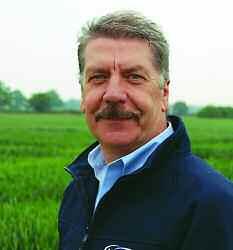
“To have the maximum effect on host-defence mechanisms, biostimulants should be applied in advance of any disease, so this means conventional fungicide timings are unlikely to be the most effective. In the trial series, earlier applications of Bridgeway were investigated at the pre-T0 and T0 timings in addition to the more conventional timing at T1,” he says.
NIAB hypothesised that in the more disease-resistant varieties, KWS Extase
and Gleam, it’s possible that the fungicide requirement could be partly replaced by Bridgeway. The trials also set out to test if this held true by including a reduced rate fungicide treatment where Bridgeway was applied at the pre-T0 and T0 timings.

Disease monitoring in the trials didn’t throw up any surprises, with KWS Extase per forming as expected. With good resistance to yellow rust and one of the highest ratings for septoria, disease in the trial was negligible. As a result, the yields were pretty flat with no significant differences seen.
In the NIAB work KWS Extase was less responsive to biostimulant and fungicides, whereas Gravity was very responsive to Bridgeway application – which wasn’t as expected, explains Bill Clark.
“ ” ▲
Biostimulants are an additional input cost for growers rather than a replacement cost,so whether the costs stack up is a very pertinent and important question. Stuart believes these results show the potential of Bridgeway to enhance grower margins.
“With profitability implications it’s important to recognise that used in the right situation, biostimulants offer the potential for considerable profit gains.The research conducted here showed that every Bridgeway treatment more than paid for itself when used on the high input variety Gravity –– ranging from an additional £37.30/ha up to

Gleam, representing the middle ground in terms of disease resistance, showed very little septoria present but yellow rust came into the trial, with 19.7% recorded on leaf 1 in the untreated on 29 June. On
£150/ha.In fact where only fungicide was used,there was a loss of £93.10.
“In the medium input variety Gleam,profit margins were also increased where Bridgeway had made significant differences to the yield –– in all but two treatments –– up to £184.50/ha extra margin was generated.
“Bridgeway use in Extase didn’t pay back,but neither did fungicide use.With the potential for such considerable profit gains to be had,pushing productivity using biostimulant Bridgeway has to be worth considering.”
leaf 2 it was 17.4%, 12.9% on leaf 3 and 6.8% on leaf 4, notes Stuar t.
“Where Bridgeway was applied (treatments 2-6), the yellow rust infection was significantly lower than the
Source:NIAB,2020.
untreated. Yellow rust infection was only present on leaf 1 at inspection on 29 June (17.9%) where just Ascra Xpro (bixafen+ fluopyram+ prothioconazole) was applied at T1 and T2 (treatment 7).”
In the trial, disease control and green leaf area were only significantly better than the untreated control where Bridgeway was included in the programme. Where Ascra

was used alone there was no significant difference in both metrics.
Treatments 4 (Bridgeway pre-T0 + T0) , 5 (Bridgeway T0) and 6 (Bridgeway pre-T0), all showed the lowest incidence of yellow rust across all four leaves which resulted in the highest yields, with a +0.26 to +0.94 t/ha yield benefit over Ascra alone.
● Bridgeway ahead of the T1 and T2 fungicide improved the overall level of disease control that was achieved.

● The best yields were achieved where Bridgeway was included pre-T0 and at T0.
● In KWS Extase,Bridgeway delivered statistically significant increases in yield over both the untreated control and fungicide-only treatments.
● In Gleam,where Bridgeway was applied pre-T0 and T0, reducing the rate of fungicide made a positive and statistically significant difference to the yield response and was better than using fungicide at typical field rates.

● The biggest responses were seen in disease-susceptible variety, RGT Gravity.
“The highest of these was achieved where Bridgeway was applied pre-T0 and the lower
Source:NIAB,2020; assessed 29 June.
yield benefit was where Bridgeway was applied at T0 instead. Applying Bridgeway at both of these timings (pre-T0 + T0) and following with a reduced rate of Ascra (0.5 l/ha), delivered a benefit of +0.3t/ha,” comments Stuart. In RGT Gravity, the disease levels were relatively low, with very little septoria recorded. Yellow rust infection was
present, with 13% on Leaf 1 and 6.7% on Leaf 2 when inspected on 29 June.
“While there was no significant difference in disease levels between treatments, applying Bridgeway ahead of the T1 and T2 fungicide improved the overall level of disease control that was achieved,” he notes.
“The results show that
a pre-T0 only application (treatment 6) was better than a T0 only application (treatment 5) in terms of reducing the incidence of the disease, but the best overall disease control was achieved where Bridgeway was included pre-T0 + T0 (treatments 3 & 4). This also corresponds with the yield results –– the best yields were achieved where Bridgeway ▲
Gleam yellow rust infection (%)was included pre-T0 and at T0.”
The highest yield in Gravity was achieved where Bridgeway was applied at pre-T0 and T0, followed by a lower dose of Ascra (0.5 l/ha) at T1 and 0.75 l/ha at T2. This gave a 1.47t/ha yield benefit (treatment 4).
“Substituting Ascra at T1
with Bridgeway was not as effective at reducing yellow rust infection, but the difference was not significant. What this treatment (Tr2) lacked in disease control was made up for in the yield, with a 1.26t/ha yield increase over fungicide applied at both T1 and T2,” says Stuart
In fact, all treatments where
Bridgeway was applied to the crop increased grain yield, with the benefit ranging from 0.78 to 1.47 t/ha over fungicide alone. The only treatment where yield was lower than the untreated was where no Bridgeway was applied to the crop, only the Ascra fungicide applied at T1 and T2 –– whilst this was not
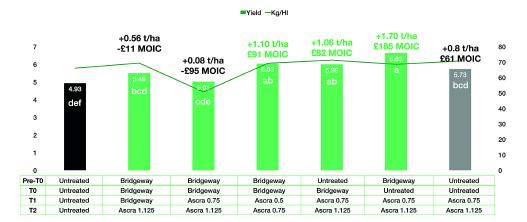
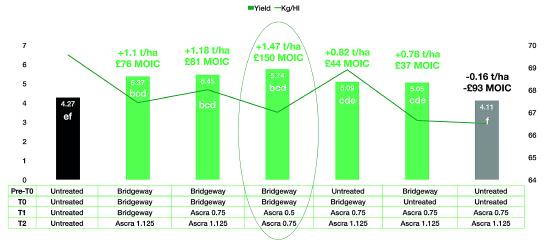
significantly different to the untreated, there was a decline of 0.16 t/ha.
So what can be deduced from this work? Stuart believes the results clearly demonstrate that varieties vary in their response to Bridgeway.

responsive “KWS Extase was less responsive to biostimulant and fungicides in this instance. On the other hand, Gravity was very responsive to Bridgeway and all applications delivered statistically significant increases in yield over the untreated control and fungicide-only treatment.
“The moderately resistant variety Gleam was also highly responsive where Bridgeway was applied at either the pre-T0 or T0 timings, with the earlier of the two giving the best overall yield response. Where Bridgeway was applied at both timings, reducing the rate of fungicide made a positive and statistically significant difference to the yield response and was better than using the fungicide at typical field rates,” comments Stuart.
What was interesting was that the outcome of the trial wasn’t as the researchers had expected. It was predicted that the greater response to the Bridgeway application would be seen in the low input variety, Extase, and the least in Gravity, whereas it was found that the opposite was true.
Stuar t believes this can be partly explained by the fact that the site was particularly stressed by the weather. “It’s possible the stress-busting properties of Bridgeway helped keep the crops healthier and helped trigger host-defence mechanisms in the plant, allowing Gleam and Gravity to respond more quickly to yellow rust infection,” he says.
The 2020 season provided more challenges to crops than most, which may be responsible for some anomalies in the data which have been hard to explain, adds Stuart. In
particular, treatments three and four in the KWS Extase produced plants with a good GLA but the resulting yields were depressed.
He believes the results are in all likelihood a trials anomaly for the following reasons. “Firstly, swapping a fungicide for Bridgeway at T1 in treatment two didn’t have this issue. Similarly treatments five and six only had one Bridgeway prior to fungicide application, so it doesn’t follow that three applications of Bridgeway and one application were fine, but two applications caused a 50% yield reduction.”
Bill Clark, technical director at NIAB, describes the Interagro trials as a really interesting piece of work.
“The thing about biostimulants is that their effects are inconsistent and variable, so can be difficult to explain or indeed predict. Because of this, one or two trials rarely give you a clear answer, unlike with fungicide trials. So, inevitably trying to make conclusions from one trial is really difficult.
“We imagined that the most resistant types of varieties, such as KWS Extase, and the moderate input varieties, such as Gleam, would be the ones that would respond best to
At the heart of good crop production lies careful use of chemistry to protect the plant and maintain performance,right through the season.But optimising the efficacy of plant protection products can be challenging,while increasingly restrictive regulations limit just how far you can go.
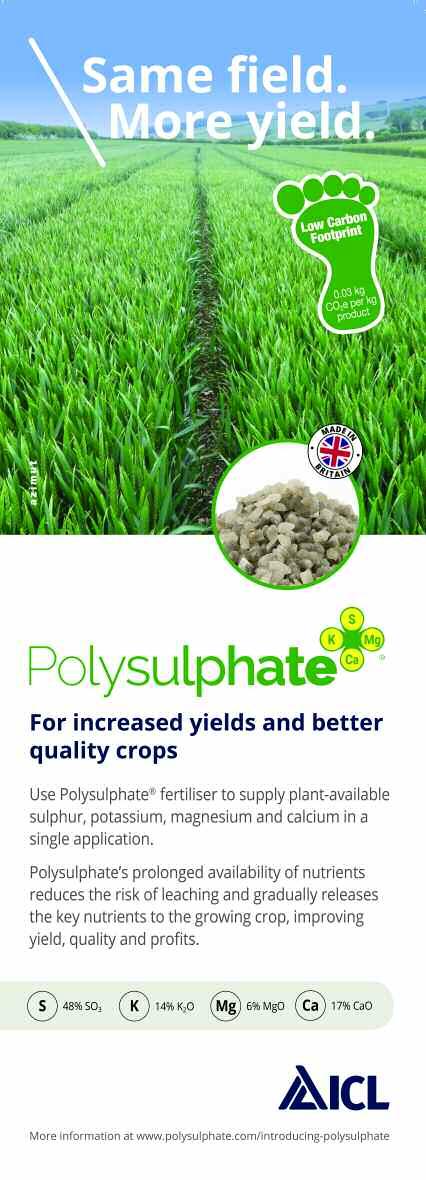
This series of articles explores the science behind the use of adjuvant and biostimulant tools to help power both chemistry and crop performance,as well as increase understanding of why they’re needed and what they do. We’re setting out to empower growers and drive crops to reach their full potential.
biostimulants and the ‘dirty’ types, such as Gravity, wouldn’t. In the end, the very resistant variety KWS Extase didn’t respond to either biostimulants or fungicides in this trial.”
So what is Bill’s explanation for this? “In a year where many crops were stressed and yields were down, KWS Extase often didn’t respond to fungicides and yield responses were small. We’ve also seen greening effects in the absence of disease on disease-resistant varieties such as KWS Extase.
“Trying to identify where biostimulants are best placed needs this type of experiment as yield responses may be smaller and less consistent than when applying fungicides, but we have identified that biostimulants can have a part to play, even on disease susceptible varieties.
Encouragingly, Interagro intend to continue to carry out trials to help growers refine their choices when considering biostimulants application, says Stuart. “We hope to continue looking at Bridgeway in this scenario, and we will continue as always to offer our best use guidelines based on our data. 2020 has cer tainly been a different year,” he concludes. ■
CPM would like to thank Interagro for kindly sponsoring this article,and for providing privileged access to staff and material used to help put the article together.
Bridgeway is a stress-busting biostimulant based exclusively on plant-sourced amino acids.It is certified for use on organic crops and can be used in all agricultural and horticultural crops throughout the growing phase to reduce stress, and improve crop health and fitness to protect yield and quality potential.
Well,we’ve made it –– and who would have thought this year would have turned out the way it has?
2020 has certainly been one I’ve wished away, and with all the pestilence and upset that this year has brought, par t of me wondered if we’d make it to December.
I joked at the beginning of the year that I was fed up of writing about Brexit and hoped I’d soon have something else to focus on, and boy, what a case of being careful what you wish for.
This year has brought change greater than we could ever imagine.
From a work perspective, my diary was hit hard, and the permanent “working-fromhome” with little to no physical human interaction was difficult, and something I definitely struggled with mentally at the peak of the pandemic.
Across industry, we’ve seen what should have been thriving showgrounds lying empty, with just perfectly pruned crop plots left as an eer y reminder of what should have been.
The machinery sector has suffered, with the closing of borders slowing down and even stopping the manufacturing process.
And on a personal level, missing birthdays, weddings, various appointments and family and social events has been hard, as I’m sure many of you will agree.
But despite all of the struggle, there have been little chinks of light, and for agriculture that’s accelerated the progression and digitalisation of the industry quicker than we could have ever dreamt of.
While we’ve been on the journey towards a digital way of working for some time, this year has forced the hands of many to quickly adapt strategies to ensure they stay connected with customers.
Instead of flying out to Europe to see the latest machinery launch, Europe has come to us with live demos, launches and a whole host of experts from across the globe on hand to ensure that “in-real-life” coverage was there.
One of the most impressive things I’ve seen this year was KWS’ “virtual” crop plot at the online Cereals Event –– which was brilliantly done given the circumstances. Who’d have thought this was possible or useful 12 months ago? Not me, for sure, however I came away feeling content that I’d still been able to gather enough information to really understand what was going on.
And from a growers’ point of view, John Deere has reported a surge in uptake of its Connected Support services during the pandemic, with more users than ever before making use of the remote troubleshooting abilities to minimise downtime and machinery faults –– an uptake I wonder would have been so vast without the movement restrictions this year has brought.
So it seems that actually, we as an industry have done incredibly well despite the

challenge and adversity we’ve faced, and that’s something that’s bringing me comfort as we head into the unknown of 2021 –– with COVID still very much restricting life and our imminent official departure from the EU on 1 Jan.
At the time that this column goes to print, the UK is still in a lockdown, with strict tier system to follow, though I’m hoping that some can take comfort in the thought of being able to spend the festive season with loved ones after a difficult year.
But whether you’re seeing off the end of the year at home, or
within a bubble of three, I’d like to wish you the merriest Christmas, and send hope for a more positive 2021.

The year that changed everythingOriginally hailing from Devon, Charlotte Cunningham is now based in Warwicks and when not busy filling the pages of CPM, can be found in the garden, or exploring the countryside with two crazy spaniels in tow. charlie@cpm-magazine.co.uk @charcunningham

Automation and AI in the world of agriculture are progressing at a jaw-dropping rate – with all signs pointing towards such tech becoming an imperative part of farming systems in the not-too-distant future.
CPM finds out more.
By Charlotte CunninghamTechnical shows and events have long been the traditional place to debut new technology and kit in agriculture,and though COVID has prevented these launches during the majority of 2020, it hasn’t stemmed the thirst for progression.
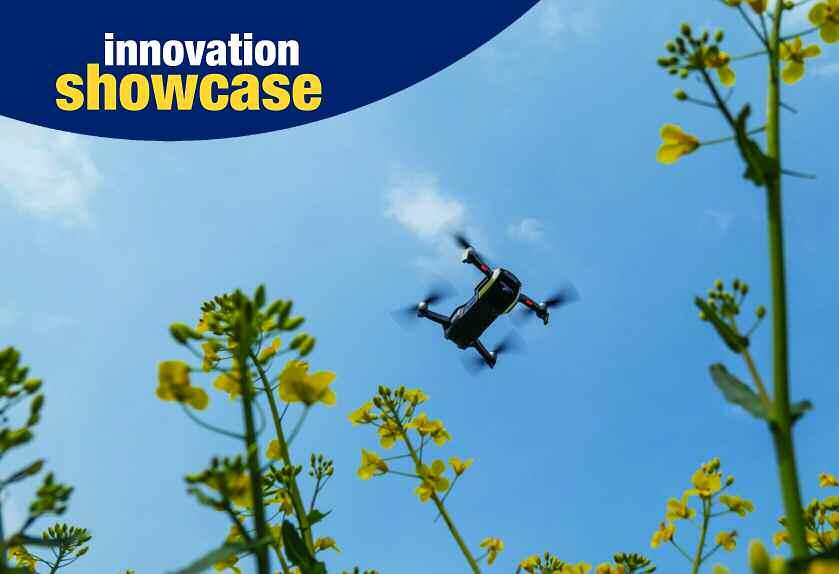
However,there are often questions over how we take the technology from the show stand to the farm, and when it gets there,just how useful is it really going to be?
For Lincs grower,Andrew Ward,integrating new technology into his business has proved to be critical from both a crop production point of view,and financially.
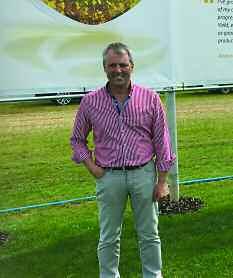
Over the past few years,Andrew has been making use of a number of technologies,including on-farm weather stations to capture rainfall,humidity,and soil temperature,as well as GPS to help with tasks such
as soil mapping.“When we look at the rainfall data we’ve gathered,it’s obvious that there’s a huge amount of variation,meaning this data is invaluable when it comes to planning on-farm activity.
“Looking at GPS,it’s not just for straight lines and making driving easier anymore –– it does actually have real potential to improve productivity and machinery capabilities.On farm,we’ve been mapping soil to GPS for the past eight years and it’s shown that we have incredibly variable soil.This data is then used to make decisions around cropping,so it’s crucial that we have access to this information.”
In conjunction with this,Andrew has also been making use of Bayer’s Climate FieldView system. “The software highlights which areas are lower yielding so we can investigate why this might be. Having data like this at our fingertips means we can take continuously lower yielding areas out of production and put it into more profitable environmental schemes.”
Though the investment in GPS can be costly,the value has proved to be colossal,with savings on Andrew’s wheat crop alone estimated at approximately £4800.“Thisis through savings from chemicals, fertiliser and seed by the reduced overlaps from using GPS on the sprayer –– instead of the operators own eyes judging when to switch on and off.The savings are far more if you include fuel in the cultivations and establishment,again because of less overlaps.”
So that’s where we are now with making use of the available technology,but where are we headed? Andrew believes the answer is simple –– robotics
and automation.“We’re not just looking at a fourth agricultural revolution anymore –– I believe we’ve started it.”
It’s Andrew’s belief that the industry as a whole will have to become a lot less reliance on plant protection products over the coming years ––regardless of whether that’s due to resistance or legislation.
And while cultural techniques will help fill the gap,he reckons that making use of robotics will be game-changing.
Andrew
believes the UK will become less reliant on chemistry and more so on robotics in the not too distant future.
WardWe’re not just looking at a fourth agricultural revolution anymore – I believe we’ve started it.
“ ”
As growers continue to battle summer droughts that seem to have become a regular feature in the arable calendar,Mantle Labs –– a remote sensing company –– has signed up to the national SPRINT (Space Research and Innovation Network for Technology) business support programme to complete a major project to measure soil moisture in crop fields.
SPRINT funding will enable Mantle Labs to collaborate with the University of Surrey on a project that will integrate Earth observation satellite data and hydrological modelling to inform on field-specific soil moisture.
The University of Surrey will provide Mantle Labs with research expertise on hydrological models to complement the company’s Earth observation measurements.This soil moisture information will be integrated into Mantle Labs’ existing insurance platform to develop a new soil moisture-based drought insurance product.
The hope is that this will enable Mantle Labs to
Andrew has been working alongside the Small Robot Company,as part of the farmer advisory board, and has trialled the “Tom”bot on farm.“We’ve had both version one and version two out on farm, capturing data and placing that data on a map.
“What’s great about SRC is that they’re looking at things on a per-plant basis,meaning these bots could
become the first remote sensing company in the world to offer end-to-end parametric index insurance products –– covering the entire spectrum of the agriculture industry,right from pre-sowing to harvest.
As a result,Mantle Labs will be able to provide insurers with historical satellite data,complemented by near real-time in season analysis,giving greater clarity of crop conditions on the ground.

Subsequently this will enable insurance companies to offer extremely cost-effective and affordable index-based insurance to small holder farmers.
The project will be funded by a grant from the £4.8M SPRINT programme that provides access to the University of Surrey’s space expertise and facilities.
“Through SPRINT,we are collaborating with leading researchers from the University of Surrey’s space programme,”says Jon Pierre,chief business officer at Mantle Labs.“Their expertise,enabled by the SPRINT funding,will help us to facilitate a unique
become a really important part of the system.”

Providing this “per-plant intelligence”is SRC’s Wilma bot,which was recently launched in its commercial form at Agri-TechE’s REAP (Realising Economic Agricultural Potential) conference.
Wilma works by using the information collected by Tom,the scouting robot,on the health of the plant.
A new project by Mantle Labs looks set to provide a drought insurance solution through the use of satellite data.
and innovative insurance product,a real market first.
“Previously,due to a lack of historical agriculture data,crop failures caused by different perils were not covered by insurers in a cost-effective manner.This meant that the estimated 500M smallholder farmers throughout the world couldn’t get access to insurance. We will now be able to access soil moisture readings at a very granular level,helping farmers to access more affordable insurance and credit.”
If she identifies the plant as a weed, then Dick –– a non-chemical robotic weeder –– is dispatched to zap it.
Ben Scott-Robinson,CEO and co-founder of SRC, says that the robots are being trialled on three farms and their success is creating excitement among farmers that have invested in the technology. ▲
As arable production continues to expand ––encompassing not only growing crops,but also protecting the wider environment,including pollinators –– a unique agri-tech start up is using IoT to monitor bee health.
By tapping into vibrations in the hive,the BeeSecure software able to listen into “conversations”ensuring that the bees are happy,healthy,and performing well.
Co-founder Roberto Pasi says the company can understand 10 main topics, quickly identifying issues.
BeeSecure is based in Italy and currently supports thousands of beehives across mainland Europe. It’s part of the European Institute of Innovation and Technology Food Accelerator Programme and has just started working with beekeeper associations and farmers in the UK.

Roberto inherited his passion for bees from his grandfather,who left him 20 hives a decade ago.

New AI is now able to interpret drone imagery to help farmers analyse broadacre crops.


In a post-glyphosate world the ability to quickly kill pernicious weeds as they appear means that farmers don’t need to wait to drill and can take the opportunity to get crops started in the better weather in early autumn,he adds.“Our lightweight farmbot Harry will also be equipped to precision drill without damaging the soil.”
“Wilma creates a per-plant crop map and is then AI-enabled to recognise disease and the nutrient status of the plant,enabling precision weeding by the farmbots and,in the future,application of water, nutrients or fungicide as appropriate –– cutting chemical use and emissions.
▲
And it’s not just on the ground that robotics and AI is gaining traction,with new AI now able to interpret drone imagery to help farmers analyse broadacre crops.
“Wilma can direct Dick on the most effective course across the field.The robot then kills the weeds using the Rootwave technology,which is electric so there’s no problem with resistance.”
“It started as a hobby,but then we got thinking bees are so important so why is there no technology to support beekeepers? There’s been a massive loss of bees in recent years and no one really knows the reason for this.”
BeeSecure uses IoT devices such as sensors to monitor the temperature,humidity,and sound.“We have a little microphone that is able to translate vibrations within the bee hive; it can’t pick up the individual conversations,but just like sitting in Old Trafford watching Manchester United,if somebody scores a goal,you’re really going to hear it,” explains Roberto.
“At the moment we can understand the 10 most important topics,from ‘the Queen is dead’ to ‘there are not enough flowers nearby’ and this is sufficient to determine a problem with the hive and understand the size of the colony.
“Additionally,bees maintain a constant temperature of 350C; if that suddenly changes
By tapping into vibrations in the hive, BeeSecure is a unique software able to listen into “conversations” ensuring that the bees are happy, healthy, and performing well.
Skippy Scout version 2.5,the mobile phone app created by Drone Ag,has been developed with unique AI to interpret images taken by a drone.“It was always our intention to develop the software to this stage and we are thrilled to have it ready for users to take advantage of this season,”says Drone Ag that is a real alarm that something is wrong.”
Data from the hives can be viewed in real-time by the farmer and keeper via a secure app.
As the software begins to make its way to the UK,Roberto is keen to talk to UK farmers about the rental of beehives and the BeeSecure system and to find partners with specialist knowledge of bumblebees.
founder,Jack Wrangham.
Automated analysis of drone imagery can detect the percentage of weeds compared to healthy crop, and count the number of plants/m2 By analysing the images,the app can also detect disease and is capable of interpreting holes in leaves to highlight insect damage.“This is the most advanced crop scouting tool we have produced and is the culmination of years of development work,” says Jack.
The new version of the software will automatically fly a drone to scout fields five times faster than conventional methods.Using AI and satellite data it can then analyse the images to offer data and advice to the user.“Skippy can now count plants,measure healthy crop cover compared to weed cover,report on damaged crops and highlight insect damage,” he explains.
Satellite data is being fed to the app up to three times a week and appears on the user’s phone as a layer of information.“Users can import their own maps too,giving each a name so that year on year data can be compiled and compared,”says Jack. “The AI in Skippy is able to take all of this information to offer analysis and advice based on the data collected from the drone images,”he adds.

The data is subsequently presented in PDF reports that are automatically created by the app.“The reports are easy to understand and can be saved for future benchmarking and comparison,” he concludes.
Also honing in on the benefits of drone imager y is Hummingbird Technologies,who discussed the role tech can play in verifying sustainability activities –– for the purpose of carbon trading,regulatory reporting,and even premium pricing –– in a recent online webinar
“As growers look to lower their inputs,we’ve become increasingly interested in measuring sustainability itself,”explains Will Wells,founder. “We can’t measure carbon from space yet, but there are all sorts of things we can do in the meantime.”
Hummingbird’s expertise is in imagery analysis, meaning it’s unable to measure factors such as diesel quantities used,so by connecting to other software platforms,users can extract that data.“We’re very much of the view that growers won’t have to log in individually to all of these platforms in the very near future,maybe in under a year.API integration between software will be able to do that for you. Backend integration unlocks value.”
On the sustainability front,Hummingbird are focusing on its “sustainability triad”which looks at:
● Facilitating optimised inputs:Microanalytic products to provide actionable insights to reduce agrochemical applications,mitigating run-off and leaching without affecting yields.
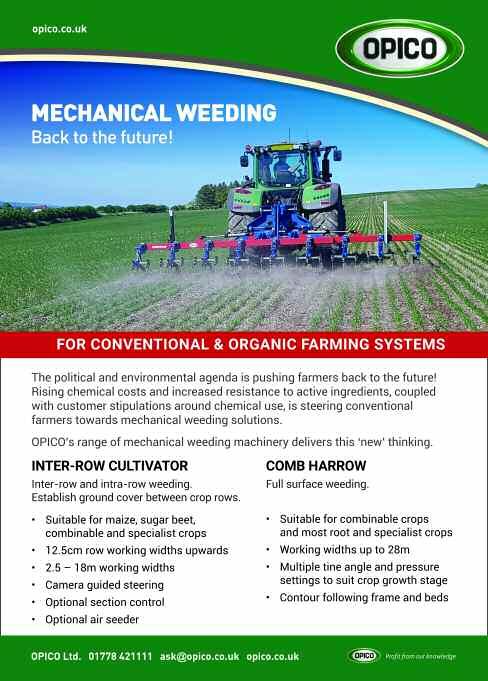
● Verifying sustainable practices:Detecting sustainable practices such as tillage and cover cropping can provide scalable and affordable verification –– subsequently unlocking carbon or supply chain credits.
● Automating sustainability reporting:Harmonising and digitalising a sustainability framework in order to improve transparency and disclosure as well as enhancing the
▲
Small Robot Company’s Wilma bot creates a per-plant crop map and is then AI-enabled to recognise disease and the nutrient status of the plant.understanding of how sustainability should be quantified and monitored
“On average,we facilitate about a 20% reduction in chemical applications and we’re working closely with the Sustainable Food Trust and LEAF on a project to automate modelling and sustainability reporting,using AI to benchmark outcomes.”
Through remote sensing and data analytics, Hummingbird’s goal is to facilitate,measure and monitor sustainability in food production,and has tools such as tillage and crop residue detection –– as well as benchmarking biomass and performance analytics –– in

its armoury already.“Within the tillage and crop residue detection algorithm,we’re able to measure the centimetres of crop residue left on the surface after a tillage event,meaning we’re able to distinguish between conservational tillage,min-till or no-till and we’re able to pinpoint the event.
“We’re doing this in the US and Australia at the moment where they have mature carbon credits available to anyone who can prove they’ve switched tillage intensity,retrospectively.
“The environment is changing a lot –– we’ve got one eye on Defra and ELMs and another on what’s happening in the US and Australia,knowing that markets follow each other.
“We’re learning every season,and it doesn’t matter as much where the initial analysis work is done, but it’s about creating a better understanding and looking at what can be done objectively,cost-effectively and remotely.”
Some time since the initial collaboration was announced,last month Bosch and BASF signed a joint venture agreement to market and sell smart farming solutions from a single source –– helping farmers to benefit from automated,agronomic solutions.
The first two products to be launched will be a version of the Intelligent Planting Solution (IPS) system,with enhanced digital intelligence for seeding and fertiliser rates, and Smart Spraying.
The Smart Spraying solution combines Bosch’s camera sensor technology and software with xarvio’ s crop optimisation platform.Both products have been tested extensively in real growing conditions.
Depending on the local conditions this may lead to a reduced need for crop protection products in specific applications, with Smart Spraying showing up herbicide reductions of up to 70% herbicide in the experimental stage.
The solution is expected to be launched with a limited number of machines in 2021.
Though hydroponics divide opinions,the benefits of such systems have been raised time and time again as part of the solution to feeding a growing population.
And the technological advances in this area of the market are truly remarkable,including the recent launch of a new project to develop an autonomous, hydroponic system centered around a novel hydrogel growing media.
The GelPonics project is a collaboration between start-up AEH Innovative Hydrogel,robotics experts Labman Automation and Crop Health and Protection (CHAP),supported by the Graphene Engineering and Innovation Centre of Manchester University,Grobotic Systems,and Stockbridge Technology Centre.

The project is funded by Innovate UK’s Transforming Food Production challenge:‘Science and Technology into Practice’ and is planned to run for 26 months –– commencing on 1 Sept this year.
In place of soil,hydroponic systems generally use a substrate,such as rock wool,coir,or peat,to support plant roots and facilitate water and nutrient uptake.
However,as all these substrate options are unsustainable,they tend to be the largest contributor to the carbon footprint of vertical farming or glasshouse production.
With global controlled environment production expanding significantly,it’s essential that alternatives are sought that can decarbonise agriculture –– while meeting grower specifications –– and,crucially, competing on price,says CHAP.
GelPonics technology is claimed to improve the sustainability of production and,by optimising inputs and crop resilience,cut operational expenditure.
As well as being recyclable,the hydrogel product can be reused locally as a soil amendment to help sequester carbon.It also has substantial export potential in dry form to countries with water scarcity.
According to CHAP,the project will be delivered in three principal phases:
Phase 1 will optimise the hydrogel formulation and shift-changer nutrient delivery system, encompassing a “state-of-the-art”graphene
membrane, alongside industry analysis.
Phase 2 will focus on prototyping trials in CHAP’s Vertical Farming Development Centre,and STC’s LED Tomato Glasshouse,to optimise plant growth within the GelPonics system.System development will combine sensors with automation to create a fully automated rig for the hydrogel substrate,integrated with renewable energy.
Phase 3 will deliver a full,semi-commercial trial of the GelPonics system for both leafy green and tomato production,as well as demonstrating the technology and its potential for low-carbon horticulture.
“There’s a significant market demand for more sustainable hydroponic substrates,”says CHAP innovation network lead,Dr Harry Langford.“This project is an exciting opportunity to optimise and scale-up a novel hydrogel product and demonstrate this product directly to the end-user,within an automated production system”.
Hummingbird Technologies are working closely with the Sustainable Food Trust and LEAF on a project to automate modelling and sustainability reporting,using AI to benchmark outcomes.
Precision farming technology has revolutionised agriculture, giving growers access to everything from GPS to variable rate mapping. CPM delves into the detail behind some of the most game-changing innovations on the market.
By Charlotte CunninghamThough much is unknown about how exactly the future of farming in the UK will look and work,everything we do know is pointing to the fact that greater resilience and sustainability are going to be core principles of viable businesses.
Of course, resilience and sustainability can mean many things, and future-proofing systems can’t be done by simply changing one aspect, however, precision farming technology and making better use of the data it generates present a good place to start.
Such is the view of Nicholas Saphir, the new chair of AHDB, who emphasised the importance of UK agribusiness being competitive –– and how the productivity gap between the best and worst farmers can be narrowed by making better use of benchmarking and data –– at the Agribusiness conference last month.
“These are exciting times, but it’s also going to be a period where uncertainty is going to rule and we’re going to have to find ways of being nimble and dealing with it.
“Farm success requires good agronomy and business acumen. The best farmers make more [money] and the worst do not.
We must drive unnecessary costs out of the system.”
While potentially a controversial statement, it does open the discussion to just how best we can drive these “unnecessary costs” out of the system and what tools are on hand to help growers do so.
At the heart of precision farming is complex data-collection software, and while these platforms regularly face criticism for their lack of smooth two-way data transfer, progress is being made with the commercial launch of DataConnect –– the cloud-based system that enables the exchange of machinery data between Claas, 365FarmNet and John Deere.

DataConnect enables the exchange of essential machinery data between different platforms, to allow users to view all of their mixed-brand fleet information within the single data platform of their choice. Previously, viewing such information required duplicating effort by using each manufacturer’s corresponding but separate platforms or web portals.
According to Deere, the structure of this new direct cloud-to-cloud solution enables a seamless and automated data flow without any effort required by the customer. The real-time data exchange allows a live overview of the whole machinery fleet. Furthermore, DataConnect works without any additional hardware and software components and ensures secure data handling.
With this new approach, customers can view five different machinery data sets for their fleet:
● Current machine location
● Historical machine location
● Fuel tank level
● Status of the machine in the field
● Machine speed
Customers can decide which company’s digital platform they prefer to use, to display all the data. As soon as they are connected, other manufacturers’ machines appear automatically. Machines are either displayed with icons in the respective brand’s colour combination or are visible in the icon’s information panel.
As well as this, Deere recently announced updates to its Operation Centre –– designed to make the system “even smarter” and more compatible.
“Thanks to a new function, with just a few clicks all processes can be adjusted in the Operations Centre –– even after fieldwork is finished,” explains Chris Wiltshire, marketing
Farm success requires good agronomy and business acumen,says Nicholas Saphir.

As we move towards the era of greater good, digital technology going to be fundamental in future-proofing farms.”
“
In a record-breaking announcement last month, Africa has become the first continent to chart soil fertility in every single field –– the benefits of which are thought to have the potential to boost livelihood and human health across 54 nations.
The map has been produced by iSDA,a social enterprise founded by three research institutes –– Rothamsted Research,World Agroforestry and the International Institute of Tropical Agriculture.
Their hope is to tackle the major human health challenges caused by food grown in poor quality soil,including the estimated 1.1M child deaths caused each year by malnutrition.
“For the first time,farm level soil data is now available for the entire African continent,”says Dr Jonathan Crouch,CEO of iSDA.“With an ever-growing demand for food,it’s critical that we find ways to increase productivity in sustainable ways that also allow millions of smallholders to improve their livelihoods.
“If we know the current status of essential
manager at John Deere UK and Ireland. “This allows farmers to manage operations just as flexibly as with a field book. “If the tractor driver has accidentally
soil nutrients,we can maximise productivity, profitability and environmental benefits.”
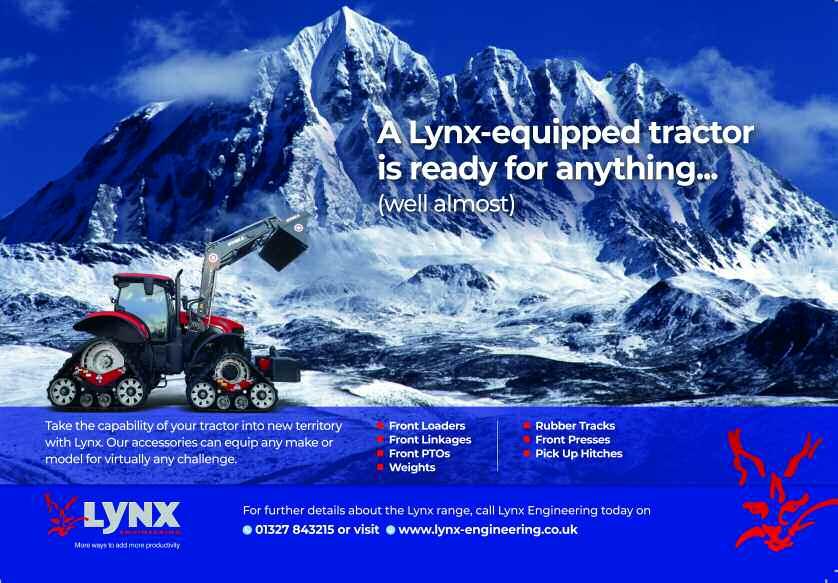
From the Tunisian coast,all the way to the Cape –– some 5000 miles away –– the iSDA soil map charts the continent’s 3.4M square miles of potential agricultural land in unrivalled detail at roughly 24bn locations.
It means that for every single field on the continent,vital information such as the acidity, organic content,and nutrient levels of the soil is now available.This can help advise farmers in a number of different areas,such as yield forecasting,crop suitability and fertiliser application.
It also marks the first time an entire continent’s soil has been studied to this level of detail and raises real hopes for much improved harvests –– and subsequently,the health, livelihoods,and food security of more than a billion people.
“Soils are fundamental to life on earth, but knowledge about African soil has been incomplete and out-dated,” adds Dr Matt Miller,
documented the wrong crop variety during drilling, for example, this can easily be corrected later on.”
Further adjustments are also possible for
Africa has become the first continent to chart soil fertility in every single field.
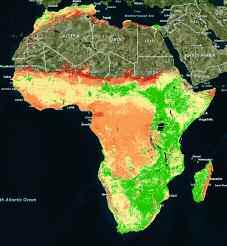
lead data scientist at iSDA.“In order to continue to feed the fast-growing population sustainably, there is an urgent need to generate accurate, up-to-date soil health information to support agricultural development,environmental sustainability and fight climate change.”
worked area, plant protection products, tank mixtures, harvest year and crop calibration on the combine, among others. In the free MyOperations app, operators can also
add data if they have forgotten to start the documentation or if the machine is not able to record data.
For customers with mixed fleets, the Operations Centre offers several options to import external data, says Chris. “For example, most common third-party displays can be connected using the respective ‘in-house’ format.
“Alternatively, data from machines with displays documenting the fieldwork in ISOXML format can be imported into the Operations Centre via a USB stick. This also works with historic machine data if it is still available somewhere else, for example saved on a computer hard drive.”
Even machines without a telematics system can be included in fleet management by using the optional location-sharing function within the MyOperations app. This function can be activated by the driver and uses the smartphone’s position to determine the machine’s location.
One of the UK’s biggest digital specialists, Farmplan, also recently announced a major update, which the firm claim will help growers unlock a decade’s worth of data.

The Business Manage update will allow users to view and analyse up to ten years’ worth of their data in just a click, giving farmers the chance to unlock extra value without requiring any additional input.
Business Manager users are now able to compare figures over a 10-year span both as profit and loss, and cashflow. Before, it was only possible to create comparisons between the current and previous year.
According to Farmplan, with this greater access comes greater insight –– meaning farm businesses can measure their performance in the long-term and make more informed decisions as a result.
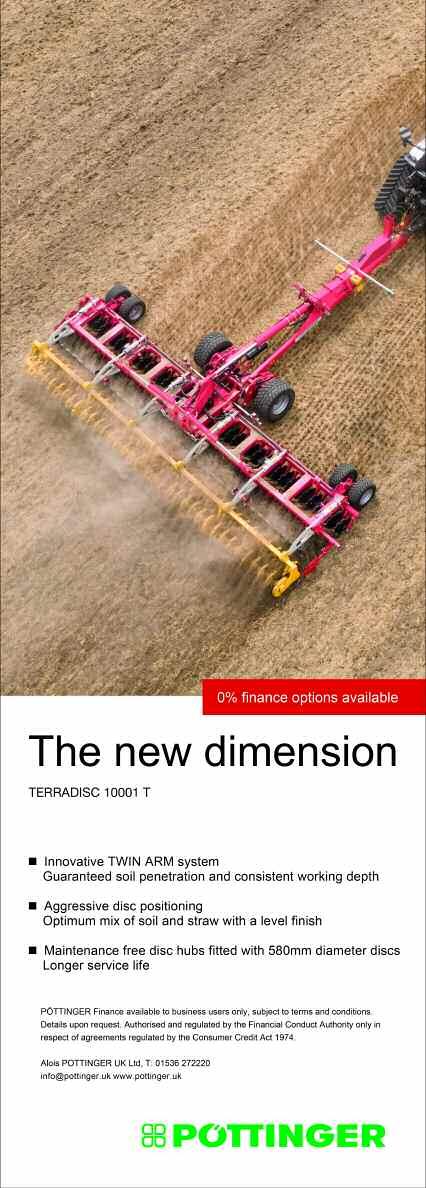
Behind the scenes, small tweaks have also made importing and exporting of data simpler
Invoices and journals can be
For customers with mixed fleets, John Deere’s Operations Centre offers several options to import external data.
imported directly via CSV file ––with members of North Herts Farmers now able to import their information directly, along with AF Group and Fram Farmers members –– eliminating the need to enter data manually, saving time and resources.
And from one of the UK’s largest providers, to an interesting start-up firm that enables collaborative working to establish best use of land assets.
Showcased at Agri-TechE’s recent REAP conference, the Land App is a digital mapping platform that enables land managers to benefit from new agri-environmental schemes, connect with Natural Capital investors and design integrated estate plans that support best practice.
The company was founded by Tim Hopkin in 2015 out of personal frustration when he struggled to save the family farm.
“I was trying to work out how best to use the land assets to stop us having to sell the farm and found the available information so fragmented. So, we started to develop software that would help pull all the data together.”
Not only did this enable Tim to keep the farm but now he has created a thriving business.
“Our main objective with The Land App is to support the development of the natural capital market and the transition to agri-environmental schemes by improving decision-making. The platform facilitates the land management sector to work collaboratively and transfer land
data more effectively.”
Looking at the technical side of things, the platform allows growers to pull in data such as boundaries, registry titles, Ordnance Survey data and Defra designations, and to build projects and schemes that support diversification by including farming and environmental activities, energy generation and alternative land uses.
And the real selling point? The platform is collaborative, allowing consultants and land managers to work together in real time to deduce the most effective use of the land assets.
“If an organisation is looking to fund new interventions in the landscape, such as a water company improving river quality or the Woodland Trust encouraging tree planting, we have so many land managers using the platform that we are able to inform them quickly of these opportunities,” explains Tim. “The software acts as a bridge between these multiple stakeholders in the land management sector to keep everyone on the same page and moving in the same direction.”
On the machinery front, while cost is undeniably a huge hurdle to overcome,
Telus –– the firm that recently acquired Muddy Boots –– has recently launched Telus Agriculture,a new business unit with high aims to digitally transform global food systems.
According to the firm, Telus Agriculture optimises the food value chain by leveraging data in new ways to increase efficiency,production,and yields,delivering better food outcomes for businesses and the end consumers.As well as Muddy Boots’ involvement,Hummingbird Technologies has also partnered with the new division,increasing access for UK growers to this global platform.
At present,Telus Agriculture supports more than 40M ha of agricultural land, backed by a team of more than 1200 experts across Canada,the USA,Mexico, Brazil,the UK,Slovakia,Armenia,Germany, China, and Australia. “From farm to fork, by digitising the entire value chain and linking these technologies together for the first time, we will facilitate a secure exchange of information to allow farmers, agri-business organisations,the agri-food industr y and the consumer to make smarter decisions”says Darren Entwistle, president and CEO of Telus.“Importantly, we are striving to provide innovative solutions to advance the agriculture sector on a worldwide basis.”
particularly for smaller farms, the investment can bring a significant reward, according to Alessio Quatraro –– connected services manager with Case IH’s parent company, CNH Industrial.
Alessio believes that with costs of inputs such as fuel, fertiliser and crop protection products continuing to rise, and wastage having cost and environmental impacts, both cropping and grassland farms –– regardless of their size –– can quickly recoup the cost of specifying or adding precision technology when ordering or upgrading tractors.

“Reduction in overlapping from the use of guided steering offers potentially significant savings in fuel and inputs such as seeds and fertiliser.
“But there are further benefits to be gained. For example, automated steering systems controlled by GPS improve accuracy and safety at night or in poor
visibility. For grassland work such as fertiliser spreading where previous passes are hard to detect and measure against, they also

One to watch for...The Land App was founded by Tim Hopkin in 2015 out of personal frustration when he struggled to save the family farm [photo:The Land App]
make pass-to-pass accuracy of application simple.

And the more accurate the GPS signal used, the greater are the potential benefits to be gained, he adds. “While a basic GPS signal with 10-15cm repeatability will allow auto-steering systems to make parallel passes sufficiently accurate for tasks such as manure spreading, an RTK correction signal and the 2.5cm repeatability it provides offers the possibility of adopting controlled traffic, with the same tractor field paths used year-on-year, minimising soil compaction and
maximising crop growth potential.”
Not only does the pass-to-pass accuracy of GPS guided auto-steering reduce fuel consumption and improve work rates, but the reduction in tiredness and increase in focus means more productive and also safer operation, particularly important for those working alone, he says.
Looking at this on a practical scale, Alessio explains that mid-range tractors such as a Case IH Maxxum or Puma –– most frequently seen on medium-sized arable farms –– are typically less likely to have been ordered with auto-steering. “These tractors –– and the
Not only does precision farming technology have the potential to improve productivity,but it can also help to curb the environmental impact of agriculture on the wider environment.
And in terms of carbon counting,AHDB has launched its first wave on-farm carbon footprinting,to help growers get a better understanding of just how much impact they’re having.
Chosen to represent a range of regions, systems and sectors,a total of 40 strategic and monitor farms will be the first to be assessed to determine their carbon footprint.
The assessments started last month, carried out by SAC Consulting and ADAS and will run until Mar 2021, with results leading to bespoke mitigation measures in detailed carbon action plans.
“The assessments are essentially the gathering of information –– to identify and
quantify all activities or inputs on farm that come with a carbon footprint,”says Dr Jonathon Foot,AHDB’s head of environment.“This can be anything from diesel,electricity,feed,and fertiliser and so on.
“Once this is established,we can then calculate the carbon to output ratio,i.e.how much carbon is being emitted per unit of output. This will then be assessed or benchmarked to determine where savings lie,and a bespoke plan created.
“Mitigation activities for arable could be as simple as changing cultivation routes to save on fuel or manure application times to optimise nutrient absorption.”

Tim Isaac director of knowledge exchange at AHDB,adds that farmer input and actions are where the success lies.
“Implementing changes on farm can sometimes be a challenge and concerns are

DataConnect enables the exchange of essential machinery data between different platforms,to allow users to view all of their mixed-brand fleet information within the single data platform of their choice.
implements they work with –– could be significantly more productive for their owners if specified with such systems.
“For example, by specifying
often raised about cost implications and wider impacts on productivity.However,evidence generally points towards ‘better for the environment equals better for businesses, so there are potentially benefits to be had all around.
“The key part of these assessments will be the identification of the specific measures the individual farms can take –– while some will be unique to each one, we also expect some common themes to emerge.This will allow us to develop case studies and share practical tips and learnings widely through our knowledge exchange activity”.
The first cohort of farms will consist of 13 cereal and oilseed growers and the initial wave offers a springboard for more activity to be launched under the new five-year AHDB strategy being published later this year, says AHDB.
‘AccuGuide-ready’ when ordering such a tractor it will come with the necessary electrical and hydraulic components.

“It’s then possible to either specify the AccuGuide components, minimising installation time –– the AFS terminal, navigation controller and AFS 372 receiver –– to be delivered installed on the tractor, or to add them at a later date.
“Alternatively, the AccuGuide-complete option means a new Case IH tractor comes fully equipped with AccuGuide from the factory, allowing the user to take full advantage of auto-guidance from the day of delivery, using the armrest-mounted AFS 700 terminal.”
Available on all foragers for the 2021 season, New Holland has introduced a factor y fit of a near-infrared spectroscopy (NIR) sensor,which will be fully integrated within the base unit.
The sensor is DLG certified for the measurement of moisture in maize,and will be able to measure key parameters such as crop nutrition,moisture content,starch, ADF,NDF and ash,explains Ian Bourke, product specialist at New Holland.
“The sensors mean on-the-go analysis is possible.For anaerobic sites in particular, having access to this information is key for profiling their clamp and ensuring forage consistency.”
Recent Case IH developments have combined the functions of the independent HMC II headland management and AccuTurn automatic headland turn systems to create AccuTurn Pro headland turn management –– fully automating operations at both ends and enhancing comfort and efficiency, says Alessio.
“With HMC II, once the driver has performed the simple process of programming a sequence of headland operations via time or distance –– such as disengaging 4wd, raising the implement and switching off the PTO –– a simple button press at the headland means all the programmed operations then occur automatically in sequence, with the reverse also possible when re-entering work. And it’s now possible to upgrade to AccuTurn Pro, which combines this with automated headland turning.”
Case IH AccuGuide-equipped tractors can receive a range of guidance correction, from the free EGNOS signal with its 20-25cm pass-to-pass repeatability, through Range Point RTX (15cm accuracy) to RTK + (2.5cm).
The repeatability provided by enhanced levels of accuracy also means that, for example, the same wheel tracks can be used when spreading fertiliser or liquid manure onto grassland, minimising trafficking of the land. Other possibilities include use of the same A-B lines when inter-row weeding a row crop that were originally set when it was established, he adds.
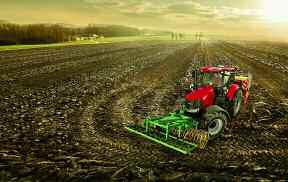
“Ultimately, there is a range of guidance technology that can bring benefits for small to medium-sized farms, particularly those with tractors run by owner-operators. These are systems that can return significant potential
Case IH developments have combined the functions of the independent HMC II headland management and AccuTurn automatic headland turn systems to create AccuTurn Pro headland turn management.
rewards for their investment.”
For anyone still on the fence about whether or not precision technology is worth the investment, Bayer launched a free trial of its FieldView in April this year –– with growers still able to sign up until 31 Dec.
Bayer’s Max Dafforn says having access to these free trials are important as it helps for the trialists to see the full potential of digital technology “We know from talking to farmers that many have lots of data but applying that to improve decision making doesn’t always follow We want to make sure that those trialling Climate FieldView realise the capability of the platform to bring all their data together and then allow them to translate that into farm management decisions.
“Obviously, some growers are reticent of digital technology. But as we move towards the era of greater good it is going to be fundamental in future proofing farms.”
Purchasing new kit is a big decision on-farm,with many different factors to consider.
CPM finds out how one farmer ticks all of his boxes with a custom approach.
By Charlotte CunninghamWhen you’re in the market for a new bit of kit, whatever it may be, drilling down into the spec can be an overwhelming task.
Not only is there a tantalising feast of features on offer, but there’s also the challenge of matching a machines ability and functionality to your business objectives, to ensure ever y penny spent will work to bring a tangible return on investment.
So how do you strike the right balance?
For Leicestershire farmer, Leigh Donger, investing in a custom-built sprayer has been key to ensuring all of the right boxes are ticked.

If you were to visit Leigh at Peacock
Far m –– deep in the Vale of Belvior ––you’re likely to see more than just crops and kit.
As well as producing over 607ha of arable crops, the fifth-generation farm is a hub for diversification, growing and producing “local produce with low food miles” including honey, from the on-site hives of bees, and cold-pressed rapeseed oil, as well as hampers for Christmas gifting and a busy liver y yard.
And so with an incredibly busy schedule, having robust, high per for ming kit for the crop production side of things has always been a priority says Leigh. “W ith so much going on at the far m, having kit that works when we need it to is crucial. For us, incurring downtime making repairs is not an option.”
When it comes to reliable sprayer options, Chafer has been the far m’s brand of choice for the past 15 years, says Leigh. “In 2005 a self-propelled Rogator 618, with a 30m Chafer spray pack and a 6000-litre tank, was charged with keeping on top of the spraying,” he explains. “But having a dedicated sprayer meant that too much pressure was being put on the
existing tractor fleet at busy periods.
“The Rogator was an excellent machine, but we felt we didn’t have enough land to justify a dedicated sprayer and we needed to be able to use the tractor unit for other jobs if needed.”
As a result, the decision was made to trade in the self-propelled sprayer and replace it with a trailed machine so the tractor could be utilised elsewhere when workload pressure was at its peak.
In 2011 a second-hand trailed 40m Sentr y with a 6000-litre tank on RTK arrived on the farm, and three years later, this was converted to 30m as the farm shifted its priorities to move towards a controlled traffic far ming system, explains Leigh.
In light of changing needs and fur ther adjustments to the business’ management strategy last year, Leigh decided to replace the existing 30m Chafer Sentr y with a brand new 30m Sentr y with 6000-litre capacity.
“We had no issues with the Sentry when it was 40m, but it was too big for many of our fields, plus we wanted to work towards a CTF system,” he explains. “In fact, we’d had so few problems with it that I was reluctant to change, but as a business, we
Incurring downtime making repairs is not an option.”
had a focus on ensuring optimum nozzle to boom height, so the new 30m model with triple-folding boom and RTK fits our system much better.”
As well as continued performance from Chafer machines, Leigh says the ability to build custom kit with the firm has been a huge decider in staying loyal to the brand. “We’ve never really looked at other sprayer brands because Chafer has always made a bespoke machine for us.
“When it came to our latest purchase, I basically just gave them a shopping list of features I wanted to have on the machine and they were able to do it for me –– something I’ve never found with competitors.”
One of the main things Leigh wanted was an alternative steering axle. “The standard axle that came with the Sentry had a silent bush system, but I wanted something different and Chafer were able to do this for me. When I spoke to other manufacturers, this wasn’t something they were prepared to discuss.”
An air purge system was also a must-have custom feature. Aimed at reducing wash-out times and chemical dead volumes, Chafer’s AirPurge system uses compressed air to expel the maximum amount of liquid from the plumbing and spray lines at the end of a tank load. An icon automatically appears on the screen at low tank levels, and once selected, the additional air tanks are used to propel liquid from the nozzles.
“An automatic purge system feature at the beginning of the spraying procedure also means that the pipes are full so there’s no time lag when you start spraying,” adds Leigh.
On the technical side of things, Leigh was also keen to include a digital touch

Having a bespoke sprayer has proved crucial to Leics farmer,Leigh Donger.
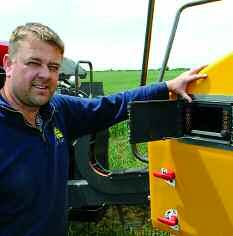
screen system for operating the sprayer. “Chafer fitted an iPad type touchscreen to the side of the sprayer and I was then able to choose what buttons I needed and where I wanted to put them, meaning I’m able to operate the sprayer exactly how I want to.”
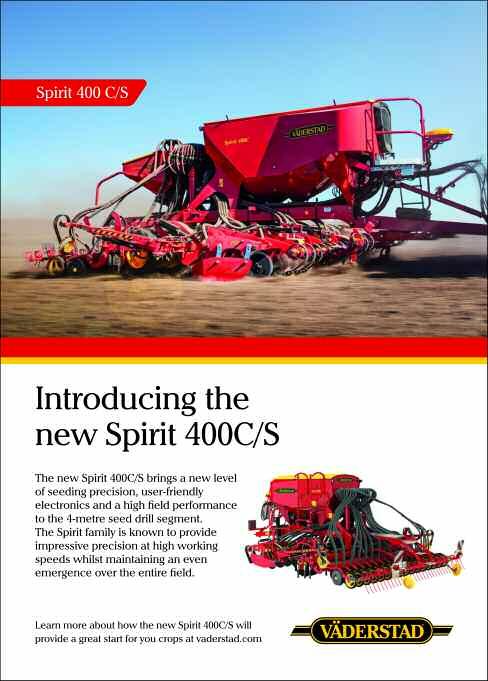
Turning to the nuts and bolts, just how does this latest Sentry sprayer compare to its predecessor?
A new sprayer-mounted gyroscope operates the steering axle, with no physical connection to the sensor now required, helping to reduce the time taken mounting the sprayer.
The most noticeable advantage is the new boom-levelling system, something that’s particularly impressed Leigh. “ We really like the new Norac UC7 boom
ePlumbing,the manufacturer’s own fully automated filling,rinsing and dilution system, has been designed to maximise efficiency by reducing downtime and removing the chance of error.
Leigh’s custom-built approach isn’t unique to Chafer,and the firm’s ethos is centred around creating bespoke sprayers to ensure every business priority is satisfied,explains the firm’s Joe Allen.“The sprayer market is particularly competitive,so by offering this bespoke approach,we can promise to deliver in every sale.”

So,how do you decide on a specification?
Size and capacity are understandably the main priorities when looking at a new machine on any farm,with a wide variety of factors effecting the choices made,explains Joe.“The total cropped area, sizing of given blocks of land, and the ability for var ying soil types to carr y the machine are all discussed when choosing a tank size.Where customers are running a bowser,obviously sprayer capacities can be reduced, lowering the overall weight and compaction in the field.”
Along with capacity,boom width is also one of the key considerations, with field sizing and the ability to spread solid fertilisers among the factors that ought to be considered.“At Chafer we continue to see the trend of customers moving to wider booms to improve work rates,timeliness and often to fit in with a CTF system.”
However,this isn’t always the case,and sometimes widths can be pushed too far at the detriment of work rates. “In initial conversations with customers we can provide tools to show expected work rates at certain forward speeds, the effects of cropped area changes, and estimate the effects these amendments have on returns,”explains Joe.“But there is a huge availability of different booms within the Chafer range which balance overall weight with durability.”
One of the main drivers behind increasing work rates –– while optimising application accuracy –– has been advancements in boom-levelling systems, he adds.“Chafer can supply various options with the Norac UC7

According to Leigh,the most noticeable advantage on the latest Sentry sprayer is the new boom-levelling system.

levelling system,” he says. “Our old sprayer had Chafer’s own levelling system which worked really well, but it was limiting in its performance in that it was slow to react to topographical changes. The new Chafer ‘F’ type boom and hydraulic system coupled with Norac is so much quicker to react.”
Chafer has also realigned the stainless-steel tank on the new Sentry,
‘Active Roll’ system offering what we believe is the most advance levelling system available. It ensures boom height is maintained regardless of topography to minimise drift and maximise product efficacy.
“Available in three or five sensor versions, UC7 uses ultrasonics and accelerometers to control the boom,adjusted through the independent incline cylinders and the centre frame. It’s that additional reaction in the centre carriage that has really advanced the contour following and the system’s ability to deal with larger tramline undulations.”
When it comes to sprayer specification,it’s precision farming technology and GPS that are high on customers wish lists,with many farms having settled on their brand of choice,believes Joe. “Both trailed and self-propelled machines can be specified with any manufacturers GPS equipment, so customers are able to choose from Topcon,Raven,Greenstar,TeeJet etc.
“We can provide advice on what’s most suitable, but often a farm has aligned itself with one particular brand and this helps with machine familiarity when it arrives on farm ––fully fitted in the factor y with their control system of choice.”
Another point worth noting is that Chafer choose not to align themselves with any one particular supplier of plumbing and nozzle body components.This allows customers to choose from single, twin and quad spray-line options, offering automatic line switching to vary application rates and nozzle type on the move, says Joe. “Pulse width modulation has allowed us to improve application accuracy further still, with operators being able to make use of specific exact droplet sizing and maintain that, regardless of forward speed. Built-in turn compensation and individual nozzle control are part of this system and these are popular with customers looking to improve applications and reduce inputs on even the most difficult of field shapes.”
Like many manufacturers,the options list is a long one,with lighting,mud guarding,electronic plumbing systems and stainless-steel belly sheets to mention just a few.“We try to understand each customer’s requirements, whether that’s the layout of their filling area, crop rotation or comparisons with an existing machine.It’s at this point that we can come across one-off issues that require some modification to the standard list of components, but with our own in-house design and engineering departments,these can be solved and a custom solution provided.”
This flexibility has led to some interesting custom machines over the years such as 6000-litre twin tank trailed machines, pineapple sprayers for Costa Rica,and the company’s range of de-icing equipment,but more often than not changes are applicable to other customers too.“Often a customer’s one-off request is picked up by other growers so becomes a standard option for the future,” concludes Joe.
which means it sits about 40cm lower on the frame and it’s wider than the previousversion. “This improves sprayer stability –– especially with the bigger tanks –– when travelling at speed or on slopes, and in tur n this makes it feel safer and easier to operate.”
Chafer has made some subtle changes to the triple boom folding height, which now sits much lower to the side of the tank. According to Leigh, this has been particularly useful when going under low hanging trees or backing into sheds.

“Chafer has even thought about the position and functionality of the induction hopper,” he says. “On our old machine it was on a fixed height so would often hit the crop. The new induction hopper works off a hydraulic cylinder which comes out and up when required for filling, and then neatly tucks back underneath out of the way when not in use.”
Chafer’s Sentr y is also fitted with ePlumbing, the manufacturer’s own fully automated filling, rinsing and dilution system and has been designed to maximise efficiency by reducing downtime and removing the chance of error.
“The ePlumbing feature has made washout a simple procedure now. It’s fully automatic and runs to a set programme,” explains Leigh. “Our operator decides how
long to clean for; the exact water quantities needed, and which part of the sprayer to clean.”
Another important priority for the far m is operator comfor t and safety and Chafer doesn’t disappoint in this area either, he concludes. “Whereas in the past, commands were mostly mechanically driven, they are now electric. Two monitors (one in the cab and one on the outside) control every sprayer function, with the Topcon GPS system providing extremely accurate rate and section control over 16 boom sections.” ■
● Arable area: 607ha
● Cropping: Winter wheat; winter beans; spring wheat; spring OSR, spring oats and spring beans.
● Soil type: Medium to heavy clay.
● Mainline tractors: Massey Ferguson 8690; 7726; 7626, John Deere 6920; 6410 with a loader
● Combine: Claas Lexion.
● Cultivation equipment: Farmet Softer 6, Vaderstad Rapid, Horsch Sprinter, Kverneland tine seeder, Horsch Terrano FG.
 With an incredibly busy schedule,having robust,high performing kit for the crop production side of things has always been a priority at Peacock Farm.
Peacock Farm,Muston,Leics
With an incredibly busy schedule,having robust,high performing kit for the crop production side of things has always been a priority at Peacock Farm.
Peacock Farm,Muston,Leics
As technology continues to break down the barriers of modern-day farming, CPM finds out how Hutchinsons’ Helix initiative is facilitating the next stage of progress.
 By Charlotte Cunningham
By Charlotte Cunningham
Over the past decade,the industry has trodden carefully into the world of digital agriculture,but now it seems we’re finally standing on solid ground,with some remarkable progress being made right across the sector

And as growers continue their journey into this revolutionary way of farming, Hutchinsons is ensuring the next stage of progress can be made within its Helix farming initiative, which has a hard focus on adding value to growers’ bottom line through technology.
If you’re not familiar with the initiative, Helix has positioned itself as a one-stop shop when it comes to offering guidance and advice on using reliable, worthwhile technology on far m, explains Stuart Hill, head of technology and innovation, who has been a driving force in the project.
“Fundamentally, Helix is all about adding value to the bottom line. It’s about taking technologies, developing them, gaining an understanding of the information they can
generate and then delivering actions that can add value, pounds, and pence to that bottom line.
“Essentially it’s about answering the “so what” about technology and I spend about 60% of my time looking at, and evaluating, technology with potential that we can bring into the business.”
So, what is the “so what?” and why is tech becoming so impor tant?
“Investment in tech and funding has tripled in the past five years, and that’s pretty significant in its own right. But what’s important to note is that that’s upstream investment, at farmgate level, meaning an outlay in things like sensors, software platforms and autonomy.”
And with a surge in uptake, Hutchinsons believe that such technology can work to answer some of the key challenges on farm, which include:
● How do we use data to improve far m profitability?
● How do we improve soils and soil health?
● How can genetics have an impact, in terms of resilience?
● How does integrated crop management really tie all of this together?
“From a Helix perspective, we have to look at where we can have an impact, as well as how and where we can bring in technologies to help achieve some further value for growers,” explains Stuar t.
“If we take the challenge of improving
soil health, for example, the first step is setting out goals –– basically, what we’re trying to improve in this area.
“This could be organic matter levels, carbon status or improving nutrition, and then we have to match this challenge with what potential technologies are available and could help meet this tar get.”
Based on this, Terramap is a good example of a project launched from Helix about 14 months ago using technology that was first developed in the mining industr y, now adopted, and adapted for agricultural use, he adds. “This technology
Helix has positioned itself as a one stop shop when it comes to offering guidance and advice on using reliable,worthwhile technology on farm, explains Stuart Hill.“
allows more remote analysis of soils, as well as the monitoring of 21 different parameters.

“Compared to traditional methods, this provides a more remote, efficient analysis and means a lot less movement of soils.”
The approach that the firm has taken is not just about introducing new technologies but also to look at how established technologies can be adapted to help deliver the best on-farm solutions. “We want Helix to be seen as the proofing ground for new technology and advice and we want outside industries, more start-ups, other businesses and growers, to come to us and give us ideas and talk about innovation. We can then look at it and decide whether we can take that forward.”
According to Stuart, inspiration and direction comes from a number of sources, including outside industries such as Microsoft or Google, and research bodies and institutes like Rothamsted Research and leading universities. “Global external forums and conferences are also key to the process, with our attending agronomists bringing those ideas together with the challenges they see on farm,” says Stuart. “There’s a whole range of different options and sources of inspiration, but it’s that collaboration that we really need. We’re not software developers and while we can take the technology and work with it, we’re not here to reinvent
the wheel.”
However, sourcing the technology is just the start of the process, and where Helix really comes into its own is through its on-farm analysis work.
“Technology generally doesn’t deliver an answer straight away –– it delivers data or information, which has to be interpreted,” says Stuart.
“That’s the next stage of the process and involves the agronomist coming in to work with the grower to understand this data and decide what practical actions can be taken to make best use of the information, and really that’s the ethos behind the project.”
Everything within the Helix project is tried and tested at the Helix national farm in Northants –– owned by Andrew and William Pitts –– before being demonstrated at the recently-launched regional sites.

“The initiative focuses on farm-scale technology, rather than small plot, meaning that we’re able to take a really strategic, workable approach,” continues Stuart.
“As we build up our regional Helix farms and growers, there will also be a group that comes together to drive what the challenges are and what technology and innovation we can bring in to help.”
The next step for the project is to take more of this nationally proven tech to the regional
sites, adds Stuart. “Over the past four months, we have initiated two regional demonstration farms –– in the North and the East with more planned for the spring
and summer of next year. This allows us to test in different scenarios and situations and really demonstrate the relevance of a certain technology to particular regions.”
Hutchinsons’ MaxiRooter,which contains a large mix of plant species,the most important being the tillage radish,”explains Andrew.
The result was hugely improved ground root structure.“We planted it in May 2019 having sprayed off the damaged headland,and the crop was huge by the time it came to planting spring beans.”
As well as improving the ground structure, taking the headland out of production proved favourable on the yield map.“It meant the lowest yielding area of the field was 4t/ha and the highest was almost 7t/ha –– we were really chuffed with that and it’s put us in a really good place for harvest 2021.”
“It was simple,to do,but managing this data has helped us make much better decisions.”
Helix North is headed up by Nick and Liz Wilson, the East is hosted by Tom Jewers.
As with any long-term project,
Heading up the Helix national farm is Andrew and William Pitts who farm 2500ha in Whiston, Northants.
Known for their forward-thinking approach, the Pitts brothers have made some huge changes to the farm in recent years, with a sharp focus on minimising their cost of production. “Five years ago,the farm was based around a continuous wheat-wheat-rape rotation,”explains Andrew.“But since then, things have changed dramatically,and we now have a very varied cropping system that includes crops such as rye and peas.
“Farming is all about change, but we want to keep it as simple as possible,which is why we’ve been focusing on making better use of the most unproductive areas of the farm within the Helix initiative.”
One particular part of the farm that’s come under scrutiny is a 13ha field known as Bush Close field,and by using technology they’ve been able to make vast improvements,explains Andrew “We looked at the five-year average of the field and quickly realised how truly unproductive the headlands were.They weren’t worth farming, and from a cost of production point of view,needed to be taken out of production.”
Following the washout of last autumn, the decision was made not to combine these areas. “Rather than putting metal through wet soil,we decided to do some headland management and tr y something different.”
Instead,the farm planted a cover crop mix, designed to relieve compaction.“We opted for
According to Andrew,the upshot of all of this, and the really important thing,is that it’s all about adding profit.“Technology can just cost you money.A lot of things we’ve tried in the past have all been about adding profit to the supplier –– not the farmer –– and we’re not interested in that.We’ve been bitten by that before.
“The tangible benefits of introducing any kind of technology has to be to reduce risk and increase profit.”
In the case of Bush Close field, the decision to take the headlands out of production has proven to be a financially savvy move,too.“We did the maths and a 13ha with the whole field cropped had a gross margin of £9808,which is not bad, but isn’t great either
“But when we change this to 10ha of cropping and 3ha of stewardship, this gross margin increases to £10,860 –– including 3ha of stewardship factored in at £540/ha.
“This means that there’s a tangible benefit of over £1000 and I don’t know about you, but I need that £1000,particularly as we move towards life without the single farm payment.”
Though the ELM Scheme is likely to offer some kind of support to growers,Andrew warns of not getting too reliant on what may –– or may not –– be to come. “Don’t be fooled for one minute that ELM is going to fulfil all of what we’ve seen within BPS.So we’re going to have to become more efficient, use more technology, and manage carefully –– particularly by identifying areas not worth cropping.
“We’re really pleased with the results we’ve seen in this field, it’s a win-win all round, but it only works if you pay close attention to the detail and make use of the technology out there to
Technology enhances the work of agronomists, says Michael Shemilt.


measure, monitor and manage.”
Of course,without proper guidance and management, even the best technology can be rendered useless, which is where the role of the agronomist comes into play.
Andrew’s agronomist, Michael Shemilt, has been working alongside the farm to ensure what they’re doing can bring profitable benefits.
“Technology enhances the work of agronomists and in the future,I think there will be a requirement to do more with it –– whether that’s due to financial,legislative or environmental pressures.
“The integrated farming approach is becoming more and more important and we’re going to rely on that more to influence the decision-making process,as well as measuring the success –– or failure –– of those decisions.
As well as the work done to improve headland profitability,Andrew and Michael have also been using the data from Terramap to create more accurate variable mapping on farm.
“An example of this is variable rate lime application. We were finding inconsistencies within some of the fields and we knew we could iron out these creases with technology that we already had.
“So we looked through the Terramap data and found that pH was the limiting factor in these areas. This could have traditionally been missed, or worse, a blanket application of lime could have been applied based on the results in that area.
“We’ve now aimed lime application on just the areas that need it and expect to see the results come harvest.”
challenges are expected, and in the case of Helix, this comes in the form of the sheer speed of development of farm technology. “With traditional inputs, as they come to market, the product doesn’t change too much for the following five to 10 years. There may be some small tweaks or developments with labels, but that’s usually it.
“However, with technology, as soon as you bring something to farm it can change almost immediately, and this is something we have to be very mindful of. So it’s this that will drive the pace of change in terms of how we work on farm over the coming years.”
On top of this, there’s also a shift in growers’ priorities and pressures to factor in, adds Stuart. “From a farmer perspective, the changing pressures over the past five years have been huge ––particularly with regards to the climate, soils and improving the wider environment.
“We then add in modifications to regulations and resistance, as well as societal changes and evolving end markets as buying habits alter, and there’s a lot to think about on a day-to-day basis.”
“As growers in the farming industry, we’re here to produce food, and if
Sourcing the technology is just the start of the process,and where Helix really comes into its own is through its on-farm analysis work.

we’re not doing that in a profitable and sustainable way, it has massive effects.
The cherry on the challenge cake is the future of government policy, particularly with the onset of ELMs on the horizon, adds Stuart. “All of this means that from a farm perspective, we’re really having to look further at the strategic end of the farm and advice, in terms of what are the objects and grower motivations and where emerging technology can have an impact.” ■
As arable farms progress towards a digital future,it can be difficult to know which forms of data generation,capture and analysis provide a really worthwhile benefit to the business,and which are costly and time-wasting distractions. CPM is working with some of the industr y’s leading companies in this area to bring growers some Digital Direction.These articles track the significant steps on the journey towards the data-enabled farm, and also explain and profile the


technologies involved.
CPM would like to thank Hutchinsons for sponsoring this Digital Direction article and for providing privileged access to staff and material used to help bring it together.
Digital agriculture is shaping arable systems across the globe,redefining the effectiveness and efficiency of what can be achieved.

CPM explores what’s in store for UK growers with some major releases planned for 2021.
By Tom Allen-StevensWhile most growers will be glad to see the back of 2020, one thing our experiences may have brought to light is the value of digital tools when movements are limited and interaction restricted.
Looking ahead to 2021 and beyond, these tools are also set to be increasingly significant solutions in agriculture as farmers seek innovative ways to produce food more sustainably, but at little or no additional cost to consumers, believes Greg Meyers, Syngenta’s global chief digital officer.

“Breakthroughs in biology and chemistry have delivered 150% greater food production from only 12% more land area over the past 50 years,” he notes. “But as global demand for food continues to grow, amidst climate change, we know that natural science alone cannot continue exclusively to fill the gap.”
Greg’s driven digital revolutions in industries from pharma and biomed to
mobile phones, and has brought his background in computer and data science to agriculture and food production.
“Digital ag is going to be the next breakthrough in farming. This time, however, rather than looking exclusively at yield, or the amount of food a crop can produce, digital tools will focus on different traits consumers and regulators are looking for, such as lower water use, fewer inputs used by a farmer or a lower carbon footprint.”
It’s a belief he shares with some of the sharpest technology innovators across the globe. Funding for agtech has more than tripled over the past five years, according to venture capital firm Agfunder, bringing new people with fresh ideas into agriculture.
“Syngenta is the world’s largest agricultural innovator and sits at the forefront in bringing digital technology to life to help meet the needs of consumers and at the same time improve growers’ profitability,” adds Greg.
And that’s no mean challenge in an increasingly volatile climate. He points to projections published in Science that suggest for each 2°C rise in global temperature, yield decreases by 31% in maize corn and 46% in wheat. “In Europe, farmers face increasing regulation of what and of how much chemical can be used. Managing this complexity with fewer options in the toolbox is hard enough, but to do so with wheat prices at the same level they were 30 years ago puts tremendous economic pressure on UK farmers.”
Syngenta is the only company to have industry-leading digital farming platforms in
all the leading four agricultural markets, he claims. This puts algorithms and tools at the fingertips of tens of thousands of growers in more than 20 countries –– 63% of sugar mills in Brazil and 1 in 3 mega farms in Ukraine are already using them and Syngenta expects to increase this coverage to more than 40 million ha by the end of this year.
Here in the UK, farmers will be the first in Europe to benefit from Syngenta’s flagship tool, Protector, due to be launched next year. This is a scouting tool used by farmers and agri-businesses in Brazil, with algorithms that convert pest pressure scouting events to localised spray maps. “What Protector does is take your observations and turn them into actions,” notes Sam Grimsdell, digital agricultural manager for UK and Ireland.
Protector has come from Strider, an agtech startup that launched its new tablet-based tool to Brazilian farmers in 2014 and quickly gathered a customer base of the country’s larger arable farmers. The tool
The beauty of the tool is that it refines its approach as more and more growers use it,so could completely redefine how we manage disease. ”
“Greg Meyers believes digital tools will focus on different traits consumers and regulators are looking for.
Spotting a problem in time to deal with it can be tough on any farm.When you have 450,000 ha spread over 16 farm units it can be logistical nightmare.
Soybean,maize and cotton growers,SLC Agricola,monitors pests and diseases across a vast spread of Brazil using the Syngenta Protector scouting and recording system.This helped the business reduce inputs and logistics by 37% last season,primarily through precision application only onto specific targeted areas where pest activity had been pinpointed,and at the optimum timing to enhance product performance.
With most of the reductions achieved by Protector in insecticide treatments,further savings have also been found with herbicide applications.The company is now in its fifth season of investing in digital agriculture tools, focused on optimising efficiencies across the business.Drones,satellite imagery and harvesters that can feed back real-time information to digital decision support tools are
gathers together information drawn from crop-monitoring in the field with satellite, weather and other data to create heat maps and infographics.
Strider was acquired by Syngenta in 2018 and the tool has gone from strength to strength since, seeing a 400% increase in
SLC Agricola monitors pests and diseases across a vast spread of Brazil using the Syngenta Protector scouting and recording system.
among SLC’s connected equipment.New developments are looking at matching the best varieties of different crops to the farms’ soil and growing conditions.
Climate management is set to be the next focus of attention for the company’s digital agriculture coordinator,Ronei Sana.“It’s not just about reducing costs and increasing productivity, what we implement also seeks to reduce the environmental impact,”she says.
use of applications between May 2019 and May 2020. “It’s currently used across five million ha of US and South American farms, and we’re bringing it to the UK next year,” says Sam.
“Protector is really quite unrivalled as a scouting tool –– if you observe a problem in
Any spray operator who’s visited the Syngenta stand at an event or brought a query to the spray application team would likely have gained some valuable tips.Much of that know-how has now been distilled into a useful app.
Launched at Cereals Live this year,Spray Assist now has around 900 users,who have helped shape the user interface and functions ever since it was first released at LAMMA, reports new farming technologies lead Harry Fordham.

“The question we’re asked most often is which nozzle is best to use, and that’s the job it’s
The app brings in detailed localised weather data and gives you a tailored spraying forecast for the next five days.
designed to do.But it does so much more besides,” he enthuses.
The app brings in detailed localised weather data and gives you a tailored spraying forecast for the next five days.This includes temperature, rainfall, wind speed and leaf wetness to help select your spraying window.“Those operators working over a wide area can save different locations,while you can set up your sprayer with your selection of nozzles –– Spray Assist will advise on the best nozzle for the job and the pressure to put through it to ensure you minimise drift.”
Harry’s favourite feature is the Pre-em Predictor.“You tell the app what day you drilled,or when it’s planned, and your soil type, and it gives you best weather,soil conditions,crop emergence and weed germination information.That’s handy in catchy years like this one, but in dry years it gives really good guidance on when’s best to go.”
Free to download,Spray Assist is available for both Android and iOS smartphones. “The information we give out is based on 25 years of thorough application trials,along with cutting-edge research carried out at Syngenta’s centre at

the field you can not only drop a pin to geolocate it, but quantify the scale of the problem, and the tool then paints in a heat map.”

But that won’t just be a pretty picture. The maps can be exported to create a variable rate application map, and there’s already data integration with MyJohnDeere. “We’re currently piloting the tool with 150 growers across the UK and using their feedback to refine it for the UK market. The plan is to launch it in the spring and what we’ll be doing over time is to integrate all of our agronomy tools into Protector.”
It’s the sum of its parts that could make this a very interesting development for UK growers. Syngenta has a history of bringing
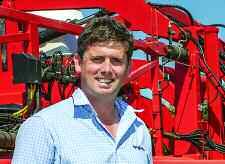
Spray Assist now does so much more than just choose which nozzle is best to use,says Harry Fordham.
Jealott’s Hill in Berks.That’s a massive database and ensures you can be confident in any advice you receive.The beauty of the app is that it puts all that at your fingertips,”says Harry.
● Look out for the new 3D90 nozzle, due to be launched in early 2021.A step-up on the award-winning Defy 3D,it’s angled just right for maximum spray efficacy at the T0 and T3 spray timings,says Harry.Drift reduction is built in and trials have also shown unrivalled penetration of the potato canopy,he adds.
The strengths of the tools lie in the quality of the data pulled in,says Sam Grimsdell,presented through a clear,easy-to-use interface.using the T-sum 170 day-degrees threshold. “It’s a very quick and easy solution for quite a difficult risk assessment growers and agronomists now have to make, so we’ve had some favourable feedback,” reports Sam.
Nearing its commercial UK launch, set for early 2021, is Syngenta’s new disease-scouting tool. Known as Avizio in France, where it was developed over 10 years, it’s helped over 1000 users refine their treatment decisions, he reports. “The tool has delivered very reliable forecasts for septoria and brown rust and also delivers good information on yellow rust and powdery mildew. Overall, it’s given an 85% confidence level.
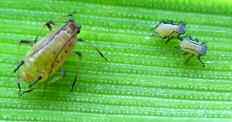
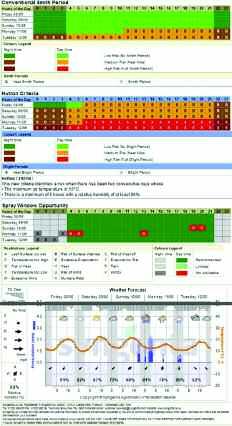
“We’ve spent some time validating the disease models under UK conditions. The app uses weather forecast and agronomic data to predict risk of infection, giving you a prediction up to 10 days in advance of the need to spray. The main benefit is that you can now accurately tailor applications to actual risk.
app. Rather it’s a tool to build on other forms of information which can be imported without the need for double entry.
And Sam recognises this is a challenge for UK growers, especially when it comes to legacy farm management software. All Syngenta tools have been designed to be open and transparent, to export and transfer data seamlessly, he says.
It’s an open-source approach Sam believes is set to become more important as growers move towards carbon-footprinting and monitoring their environmental delivery. “We’ve accrued a lot of experience and data in this area through Operation Pollinator and similar initiatives. We’re collaborating with the Cool Farm Tool and believe there’s real value in a tool that works with other partners to help growers meet environmental targets,” he says.
“Farmers know their own fields, but choices are currently largely based on granular experience and intuition. We have an absolute desire to make it easier for them to augment this with a data-driven approach, making use of the vast array of information they already possess,” notes Sam.
Blightcast includes a forecast using the Hutton Criteria to model more aggressive strains of blight.
tools to the market that help with thresholds and decision-making. “Globally, Syngenta is a market leader in digital agriculture. Although growers in the UK may not recognise this, many hundreds already use our tools.
“Our strengths lie in the quality of the data we pull in, presented through a clear, easy-to-use interface. Growers get plenty of functionality and the ability to tailor tools through apps that are simple to set up and intuitive to use.”
Blightcast, for example, is now established as a tool trusted by around 1000 potato growers and agronomists to help cope with more aggressive blight strains. It includes a forecast using the Hutton Criteria to model strains of blight capable of developing at shorter periods of 90% relative humidity. local weather forecasts are incorporated with sophisticated disease-modelling algorithms, to predict blight risk for up to five days ahead.
BYDV Assist is now in its second year with more than 700 users, who rely on the tool as part of their integrated pest management strategy against aphids following the loss of neonicotinoid seed treatments in cereals. The tool can be used to optimise spray timing to target the second generation of aphids, based on a model
“The beauty of the tool is that it refines its approach as more and more growers use it, so could completely redefine how we manage disease.”
Due for launch in the UK in mid-2021 will be Seed Selector, branded as E-Luminate in the US. “This is a tool that’s evolved from one used by seed sales advisors in the US, to help growers choose from the mesmerising array of corn hybrids and soybean varieties,” explains Sam.
“It takes publicly available data, such as weather and soil maps, and uses these to drill down through varieties and pick out those most suited to your situation.” This wouldn’t be a replacement for the AHDB Recommended Lists, however, which themselves are now available through an
“But it’s not just about more targeted use of pesticides. Ultimately growers want to deliver secure food supplies in tune with public consumer demand for produce with lower impact on climate and global resources. Syngenta has a powerful global digital resource well placed to help them attain that objective.” ■
Farming faces some major challenges. It’s not just about the products and practices applied today,but exploring what will shape the farming of tomorrow
In this series of articles, CPM has teamed up with Syngenta to investigate latest developments in sustainable farming, agronomic innovation and digital technology,with the aim to embrace tomorrow’s opportunities.
Syngenta is uniquely placed to address the increasing challenges faced by UK farmers and the changing views of society.From the discoveries made at Jealott’s Hill in Berks, the
company’s largest global site for new agrochemical R&D and product support, to its network of Innovation Centres, it has dedicated resources to bring applied science and sustainable solutions to UK growers.Through the company’s collaborations with farmers, academia and environmental groups,it’s on track to accelerate innovation in a changing world.

There’s a Yorkshire ‘tea’ that’s doing a proper job controlling diseases for one of the UK’s biggest specialist root vegetable grower. CPM finds out more about the brew that may eventually provide a helping hand with late blight control.
By Lucy de la PastureThe R&D agrochemical companies are constantly screening thousands of molecules before they find one that has potential as a fungicide –– it’s an ongoing, costly and high-tech process. That makes the discovery of a potential new fungicide in a parsnip field in Yorkshire all the more remarkable.
A tentative connection between the presence of common mugwort (Artemesia vulgaris) and a lack of disease was first made in 2014 by James Bramley, farm manager at M H Poskitt. While digging parsnips, he noticed that in the weedy patches where mugwort was present that there was no cavity spot, less pest damage and the roots were cleaner than the rest of the crop.
The family-owned farming business is based in the East Riding of Yorkshire and specialises in the growing and packing of root vegetables for supermarket chains. The farm currently produces approximately 80,000 tonnes of crops per year from approximately 2,500ha.
James decided to investigate with the farm’s agronomist, Howard Hinds of Root Crop Consultancy, whether the effects of

mugwort were merely a coincidence or a correlation. Their early work involved planting the weed between carrot rows in replicated trials. The result was encouraging, with a significant reduction in the incidence of cavity spot –– a disease which costs the veg industry millions of pounds every year.

“Planting mugwort between the rows did cause problems because when it got big, the weed then began to affect the carrot crop,” explains Howard.
So the way the mugwort was brought into contact with the crop evolved and an extract was developed by steeping the weed in hot water to make a ‘mugwort tea’ –– a step which then made application possible. The extract was then tried in experiments on different crops and when sprayed onto potato tubers they were found to keep in store for longer. When pumpkin was treated, plants were found to have less disease.
Because of the effect the mugwort had on cavity spot, which was confirmed in testing at John Innes Centre, Howard suggested assessing the leaf extract’s effects on late blight in potatoes, which is also caused by an oomycete pathogen. Samples of the extract were sent to Stockbridge House where it was found to have good activity on late blight. At this point Guy Poskitt came on board to fund independent trials specialists Richard Austen Agriculture to carry out some potato field trials, explains Howard.
The three years of independent trials showed some really positive results, he comments. “The blight pressure was relatively low in the first two years but the mugwort extract was keeping pace with the better blight chemistry. In the last year of trials (in 2019) the blight pressure was high, but the extract still performed very well ––although it did lag behind the better blight
chemistry under the higher blight pressure.”
Recognising the potential of the extract, the team called on the expertise of Dr Roma Gwynn, director of Rationale, who was first introduced to the farm in her role as AHDB Horticulture board member. Her company specialises in biorational products, with expertise in taking a product from concept to the farmer’s field.
“My role is to streamline the commercialisation process by breaking down the barriers that may be encountered on the way. I can also help with partnerships between innovators and the companies that have the capability to take a concept product to market,” she explains.
Roma worked with James and Howard to progress the project and began to look for a good commercial partnership match.
Roma’s first guidance for the Poskitt team was to get some safety checks done at different times of the year to get an insight on whether the mugwort extract contained
James Bramley found that the incidence of pests and disease in carrots was much less where common mugwort was growing.Mugwort extract was keeping pace with the better blight chemistry. ”
“
Making sure the mugwort extract had a good safety profile to support the efficacy work already carried out was the next step before finding a commercial partner,says Roma Gwynn.
any substances that were potentially toxic, recognising this as an important hurdle to get over in the regulatory process.
“The observation and enthusiasm of James and Howard, with the support of Guy, had carried the efficacy work forward but we also needed to know the safety profile as this could have stopped the project in its tracks.”
Samples of the mugwort extract were sent to Bangor University and analysed to identify its constituents. The lab tests found the components had a good safety profile and were mainly terpenoids, which play an important role in natural plant defence mechanisms
With early efficacy and safety data in hand, Roma introduced the Poskitt team to Eden Research, a British company based
in Oxfordshire. Eden focuses on sustainable biopesticides and has developed a plastic-free microencapsulation formulation technology.
The companies have shared values and similar ambitions, with both Eden and Poskitt aligned in their belief that the UK agriculture sector requires more sustainable, alternative crop protection products. So Roma thought the companies would be a good fit and that the mugwort discovery may well complement Eden’s existing portfolio of plant-derived biopesticide active ingredients. A partnership agreement was announced just last month.

“We’re delighted to be working with Eden to advance the R&D project, and be working in collaboration with a British company championing sustainable agriculture ––particularly as the bar get higher for quality, residue-free produce in supermarkets,” says Guy.
“Following successful results in our initial field trials, we’re excited about potentially finding an alternative treatment to Phytophthora, which remains one of the biggest challenges faced by root vegetable farmers.”
Over the next two years, Eden will be conducting wider testing with the aim of developing a commercially viable product, explains Sean Smith, CEO of Eden Research.
“We’ll build on the initial work that’s been done to characterise the constituents of the mugwort extract and dive deeper to identify all of the compounds within it and those present in meaningful amounts. We’ll then
Mugwort extract was also found to have activity on potato late blight in lab testing at Stockbridge House,explains Howard Hinds.

look at ways of maximising their extraction using different techniques and establish the best way to formulate them into a product,” he says.
“We’ll then be in a position to go back into the field with candidate extracts from these enhanced methodologies and the original Poskitt extraction. Replicated trials will be used to establish whether we can replicate or improve upon the performance of the original extract.”
Eden are looking for activity which gives parity with conventional chemistry in order to take the pipeline product forward. The easiest route to market is as a biostimulant but it’s unlikely to be the path followed by the Poskitt/Eden partnership, says Sean.

“Biostimulants don’t have the kind of product profile we’re looking for, so our objective is to produce a product that’s
▲

Eden will refine the extraction process from the mugwort and then make a decision which regulatory route to follow to market,says Sean Smith.
consistent and has gone through the rigour of the regulatory approval process.”

Whether the eventual product registration is as a biopesticide or follows the conventional chemistry route is being evaluated and will likely depend on the ultimate approach to product formulation.
In her role as vice-president of the biocontrol manufacturers association, Roma has a good overview of the industry, which she describes as buoyant and with a
projected annual growth of 24%.
“The global trend is to move towards more sustainable agriculture practices and to pay more than lip service to IPM. This is demonstrated in the EU’s Farm to Fork initiative, where any first intervention should now be a biological under its IPM protocols.”

The biocontrol industry has also become an area of interest for investors with a philanthropic interest in sustainable agriculture –– a big change from a few years ago when the 10-15 years it can take for a product to reach the market wasn’t proving an attractive proposition for investors, she comments.
The discovery of plants in the field which can be harnessed as biologicals isn’t unusual in the biopesticides world, adds Sean and Roma agrees, saying that it’s an area where farmers are the innovators as much as researchers.
“The challenge for agriculture is to think more as biologists rather than continue to follow the reductionist principles of chemistry. It’s more demanding to manage the complexities of biology but does enable more sustainable production, delivering food to the consumer without damaging the
environment,” she comments.
The accelerating loss of conventional active ingredients is highlighted by the recent decision by the EU Standing Committee on Plants, Animals, Food and Feed not to renew approval for mancozeb.
“The loss of mancozeb effectively wipes out almost half of the potato blight chemistry. One of the gaps it leaves will be for alternaria control and although we haven’t tested it yet, the mugwort extract seems to be broad spectrum so may have some activity on early blight,” adds Howard.
One of the benefits of biological extracts is that activity isn’t usually attributable to just one of its constituents and as a result they tend to offer multi-site activity –– something that will be largely missing in the potato armoury when mancozeb is no longer available.
Even while Eden take forward the extract, the Poskitt team are continuing to refine their use in the field. “The extract is made in batches so it’s fresh when sprayed, but James has noticed that as the mugwort plants mature, the colour of the extract fluid changes –– indicating a probable change in its constituents. That means that for the fresh extract there may be a ‘sweet spot’ in the weed’s development for maximum effect.” ■
For many people 2020 will have been an ugly year. Life as we know it has changed as we live alongside a viral threat that’s touched everyone in many different ways. But alongside the global turmoil, the impact of a changing climate has been felt across the world –– from raging wildfires to rain that just didn’t seem to know when to stop. For those making a living from the land it’s been particularly grim.
One of the blessings in agriculture is that when one sector is having a hard time, another is doing okay. That means risk can be spread across different enterprises and crops. That wasn’t the case in 2020. Combinable crops mostly came off at well below average yields and sugar beet has been plagued by virus yellows –– it was a bad season.
Where virus yellows pressure was highest, yield losses as high as 70% have been reported. And with the depression in sugar content that also comes with virus, it spells a financial disaster. The threat from viruses is a very real one, made all the more so by aphid control measures that
have been found lacking in a season such as this. 2020 is the year viral d iseases look set to change the landscape, perhaps literally as some sugar beet growers are understandably reconsidering their cropping options.
If aphids are going to thrive as the climate warms then perhaps there’ll prove to be a way to rub along with them a bit better. In this issue we’ve explored some of the innovation that’s happening on UK farms, which illustrates that the most pressing problems can be surmounted by grass roots experimentation and broader thinking. These are things that will be needed to cope with a changing climate, where the solution to the threats posed is unlikely to come out of a bottle.
One of the good things that’s come out of the ‘year of the virus’ is that there’s no shortage of food for thought. The connectivity across the world, the sharing of ideas and the availability of information has never been better. This was illustrated by keynote speaker at AHDB’s virtual Potato Industry Conference last month. Brendon Rockey farms potatoes in Colorado and has changed his farming system to one he describes as biotic ––based on living organisms –– from one that was farmed conventionally using ‘cides’ to kill pests, weeds and pathogens. In his own words he was “replacing death with life.”
As a potato seed grower Brendon’s early approach was to use aphicides to control virus, but he realised that also killed the beneficials, which resulted in using more ‘cides’. It dawned on him that in order to keep the few harmful weeds,

pests, pathogens under control, he was killing most of the beneficial organisms and concluded it was a destructive system. Brendon believes that the ‘cides’ he was using were affecting the microbiology, which in turn affects the carbon cycle and leads to the depletion of soil structure –– resulting in poor levels of gaseous exchange and water infiltration and holding capacity.
Now he concentrates on maintaining a healthy fertile soil to nurture soil biology and he’s moved away from absolute monoculture by planting a companion crop with his potatoes –– planting legumes such as faba beans, chickpeas, field peas with buckwheat ––and he also divides fields with flowering strips as a food source for beneficials.
The system relies on carefully selected cover crops, with legumes to help enrich the soil with nitrogen and buckwheat to help mobilise phosphate. He plants species with long tap roots to bring nutrients up from depth for the following crop of potatoes to utilise.
These are just some of the techniques Brendon uses in his
biotic system but he’s now able to produce comparable yields of potato seed (on a two-year rotation) without virus, something he attributes to the multiple living tools he’s using but also to the systemic acquired resistance of his potato crop –– healthy plants can defend themselves against aphid attack.
It’s a challenging concept that the very inputs relied upon to produce most crops may be disadvantageous, and it’s one that doesn’t sit comfortably with some but rings completely true to others. There’s plenty more thought-provoking content available online to help keep the brain cogs turning. A tsunami of webinars and online conferences that have replaced meeting up in person and keeping track of what’s on can be befuddling. Thankfully webinag.co.uk has compiled a diary, which may prove useful over the coming winter months.
Based in Ludlow, Shrops, Lucy de la Pasture has worked as an agronomist, while among the Twitterati, she’s @Lucy_delaP. lucy@cpm-magazine.co.uk
Keeping up with the hectic webinar schedule has become much easier with the launch of the free resource, webinag.

